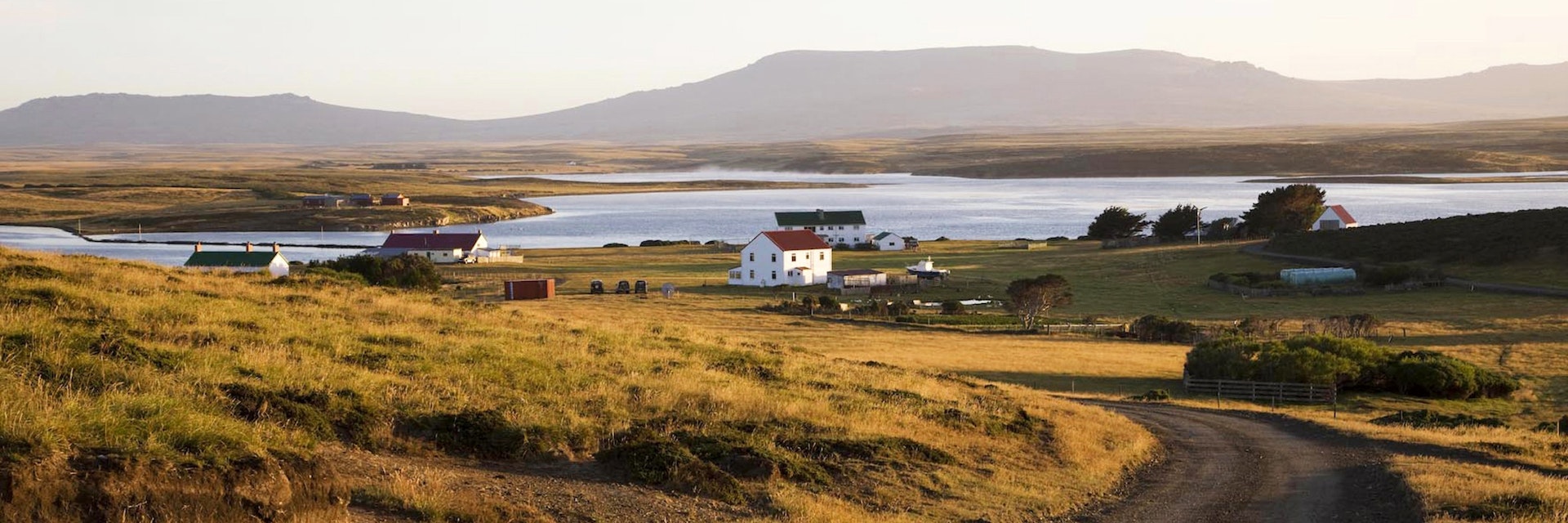
Michael Heffernan
Falkland Islands (Islas Malvinas)
The Falkland Islands are a popular addition to many Antarctic voyages, but they’re well worth seeing on their own for their spectacular penguin, seal and albatross populations. Surrounded by the South Atlantic, the islands lie 490km east of Patagonia. Two main islands, East Falkland and West Falkland, and more than 700 smaller ones cover 12,173 sq km. Alternately settled and claimed by France, Spain, Britain and Argentina, the Falklands (known as the Islas Malvinas in Argentina) have been an overseas territory of the UK since 1833, a status the Argentines have fought and still contest.

Your next trip starts here
Go from dreaming to planning with trip planning options made to help you craft your ideal itinerary.
Attractions
Must-see attractions.

Christ Church Cathedral
The great peat slip of 1886, a landslide which killed two people and damaged numerous buildings, wiped out Stanley’s Holy Trinity Church. The foundation…

Grave of Matthew Brisbane
Vernet’s lieutenant Matthew Brisbane was murdered by gauchos after British naval officer JJ Onslow left him in charge of Port Louis in August 1833. In…

Falkland Islands Museum
Open whenever tour ships are in port, this museum contains artifacts from everyday life, natural-history specimens and a fine collection relating to the…

Barnard Memorial Museum
This museum incorporates the remains of a rough stone hut built by Captain Barnard, marooned here after an encounter with the crew of a shipwrecked…

Stanley Cemetery & Memorial Wood
At the eastern end of Ross Rd, Stanley Cemetery holds among its graves the tombstones of three young Whitingtons, children of an unsuccessful 19th-century…

Government House
Perhaps Stanley’s most photographed landmark, rambling Government House has been home to London-appointed governors since 1845 and was briefly occupied by…

1914 Battle of the Falklands Memorial
This obelisk, just past Government House, commemorates a WWI naval engagement. On December 8, 1914, nine British ships, refueling in Stanley, quickly…

British War Cemetery
The immaculate British War Cemetery is close to the edge of San Carlos Water. A total of 252 British servicemen died during the Falklands conflict; the…
Latest stories from Falkland Islands (Islas Malvinas)
Filter by interest:
- All Interests
- Adventure Travel
- Art & Culture
- Beaches, Coasts & Islands
- Food & Drink
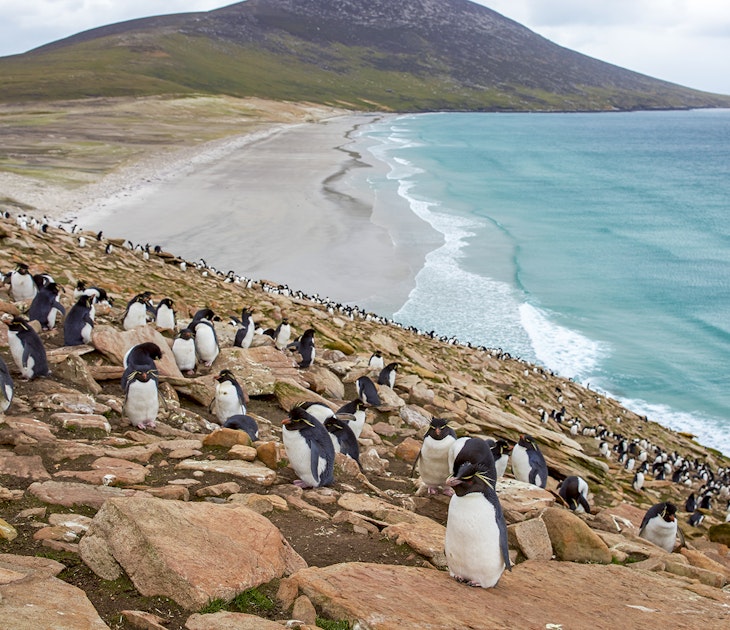
Wildlife & Nature
Apr 24, 2018 • 6 min read
Even though the Falkland Islands – one of the UK’s southernmost overseas territories – briefly came to global prominence in 1982 after its sovereignty was…
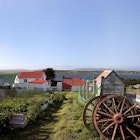
Feb 22, 2012 • 4 min read
Purchase our award-winning guidebooks
Get to the heart of Falkland Islands (Islas Malvinas) with one of our in-depth, award-winning guidebooks, covering maps, itineraries, and expert guidance.
Two Weeks in the Falkland Islands Itinerary & Travel Guide
By: Author Adam
Posted on Last updated: 23 February, 2024
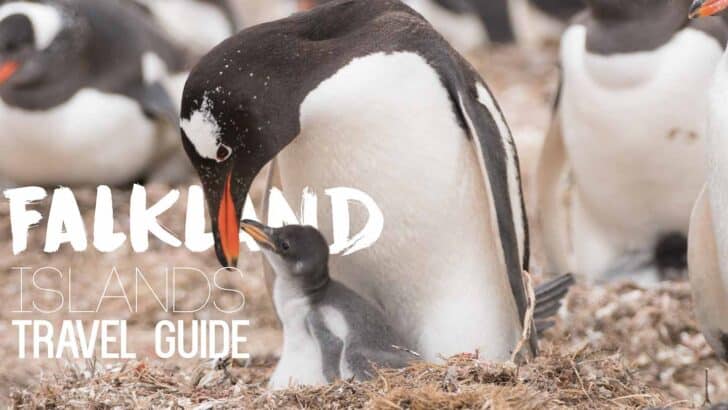
The Falkland Islands are one of those rare places left where you can escape the modern world. Located 300 miles to the east of the bottom tip of South America.
Their remote location has left the Falklands a place for one-of-a-kind wildlife encounters. While the fauna is what draws most this far south, I think what truly makes the islands special is the chance to glimpse into a unique way of life and, most importantly, a place to explore.

The longer I stayed, the more the outside world seemed to almost melt away. With each passing day spent on the islands, the pressures of everyday life seemed less important. Things are simpler here – in a good way.
Everything is extremely practical in the Falklands, almost to a fault, but fault is the wrong word because the practicality is one of the Falkland’s greatest charms. Things are the way they are mostly because they have to be – but it also makes you wonder if it isn’t because this is the way things maybe should be.
After a few days on the islands, I began to realize that this is a very DIY place. Everyone kind of does everything. The same person who checks you into the lodge is also the person serving breakfast. That’s far from the end of their duties.
They are also the ones to take you to the airstrip. They are also hooking their Land Rover to the fire station because they are the firefighters too. These are only a few of the hats most Falkland Islanders wear.
Of all the places we’ve visited in recent years, the Falklands are unlike any of the others – and I think that is what I grew to love about the Falklands the most. Sure, the wildlife is amazing, and I would return just for that alone, but something about the way of life here in the Falklands I found equally as interesting.
Jump to Info:
- Falkland Islands History
- Getting into the Falkland Islands
- How to get around the Falklands
- Falkland Islands Itinerary & Destinations
- Falkland Islands Tips & FAQ
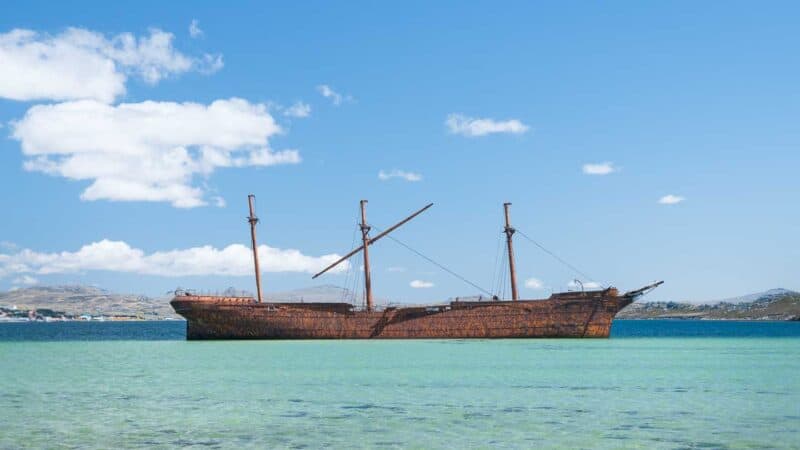
Brief Falkland Islands History
The earliest recorded history of activities on the Falklands was in 1690, when English captain John Strong discovered the islands while traveling around the tip of South America. It’s debated if earlier sailors had previously found the islands before Strong or possibly the indigenous people of Patagonia, but Strong is credited in the history books.
However, the islands remained uninhabited until 1764, when the French founded Port Louis, and two years later, the British established Port Egmont on Saunders Island.
The next 100 years would see settlements come and go, but a few took hold in the 1850s when sheep were successfully introduced. The Falklands also played a role in the shipping trades until 1914, when the Panama Canal opened. A trip to the National Falklands Museum is a must to learn about even more surprising pieces of history, like their WWI battles.
Today, a total population of around 3,300 people calls the Falkland Islands home. They share the islands with a few million sheep and some amazing wildlife.
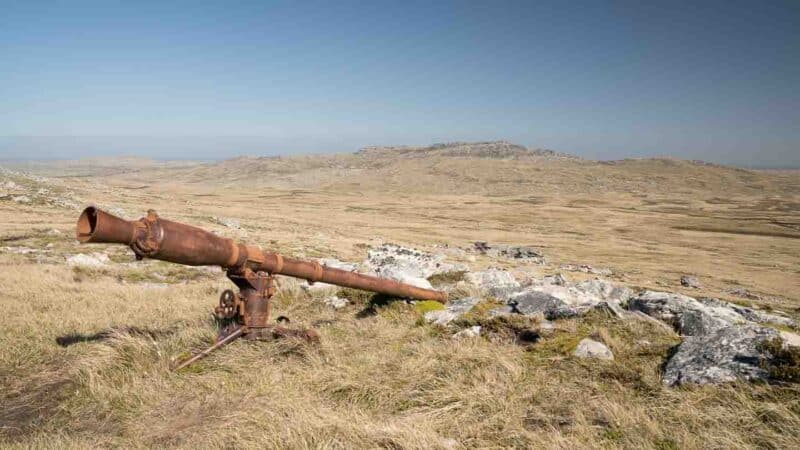
The Falklands War of 1982
I don’t want to dwell on the war, but I wanted to put a foreword in case you are not very familiar with the conflict, and it’s an important piece of history. In 1982, Argentina sent around 11,000 troops to occupy the Falkland Islands, claiming them as part of Argentina.
This claim goes back to the time of the Spanish conquest of the New World and then Argentina’s claim to Spain’s territories in the South Atlantic in 1816.
In the second half of the 20th century, the Falklands became the focal point of a political move Argentine President Juan Perón attempted to assert sovereignty over the Falklands. He used the Falklands to rally the population around a common cause, which all came to a head in 1982.
The British responded by sending 5,000 troops from various divisions, including many special forces, to take back control of the islands. The result was a 74-daylong conflict. During the fighting, nearly 1,000 people lost their lives – 649 Argentine soldiers, 255 British Soldiers, and three Falkland Islanders.
Often, when discussing the Falklands, most people gravitate toward the War of 82’. While it had a big impact here in the Falklands, there is so much more to a trip to the Falklands than war history.
Here is our recap of our recent trip and a Falkland Islands travel guide to help plan your trip. At the end of the conflict, the Argentine forces surrendered, and the Falkland Islands remained a British Territory.
Getting To The Falkland Islands
From the USA, Europe, & Other Locations – The best way to get to the islands is via Santiago, Chile. There is one flight per week from Santiago to Mount Pleasant Airport, which is currently the main commercial airport.
Every Saturday, LATAM/LAN flies to the Falkland Islands from Santiago with a stopover in Punta Arenas, Chile. You can also book the flight from Punta Arenas if you are already traveling in Southern Chile.
As a note, you will need to disembark the plane and clear Chilean customs in Punta Arenas. The process was simple and routine. We recommend booking flight legs independently rather than searching for flights from your home country to the Falkland Islands directly.
Also, be sure to leave enough time between your return flight from the Falklands to Santiago in case of weather delays that do happen infrequently.
Update: 2nd Weekly flight has been added from Sao Paulo, Brazil, every Wednesday.
From the UK – The best way to get to the Falkland Islands from the UK is by the RAF Airbridge, which runs frequent service to the islands. Every Sunday and Wednesday, flights depart from RAF Brize Norton in Oxfordshire. The journey takes around 18 hours, with one stop on Ascension Island. This option can be a little bit cheaper than commercial airlines. To Book: +44 (0)20 7222 2542
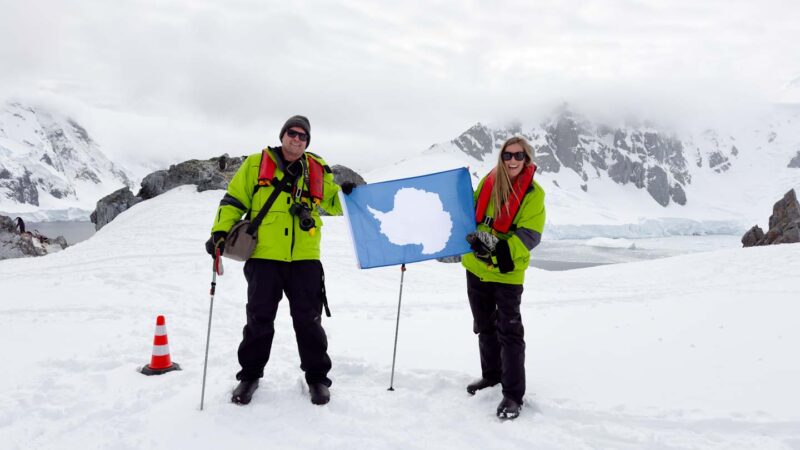
Antarctica Cruises with Falkland Island Stop
If you are looking into Antarctica Expedition Cruises, look at the longer cruises that include stopping in Antarctica. Depending on what specific itinerary you choose. There are Antarctica cruises that include visiting the Falkland Islands for 1-3 days.
The cruises that include the Falkland Islands are usually 12+ nights like this one . We went on the classic 9 night Antarctica cruise, as we couldn’t leave our two toddlers much longer than that. We had an amazing trip and next time we want to visit South Georgia & Falkland Islands.
Related Article: What To Wear In Antarctica – Clothing Packing List
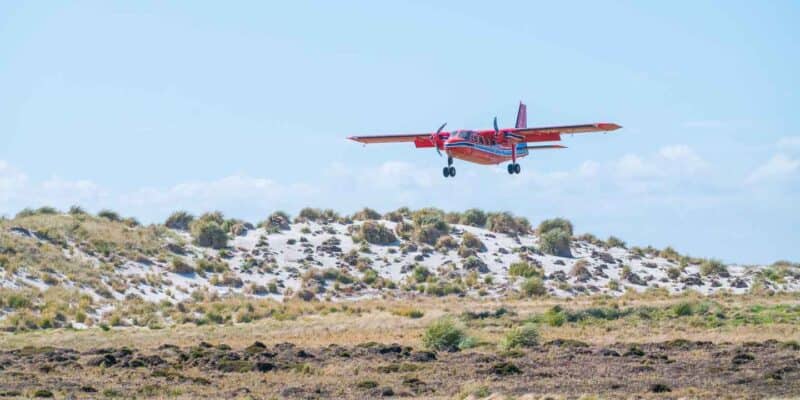
Getting Around the Falkland Islands
The best way to get around the Falkland Islands is by the little red FIGAS planes. The Falklands government runs several flights per day around all of the islands.
To make bookings, you just need to email them. The flight schedule is assembled the day before your flight, and you may have a few short stops on your way to your destination.
Before you are put off of flying small aircraft, these pilots and planes are quite impressive. I personally always dread flying in small planes, but these are just different. After my second or third flight out of six, I no longer worried during the flight. I actually enjoyed them, and it’s usually a very scenic flight.
The planes handle the generally windy conditions very well, and the pilots do a great job avoiding the bad weather. The result is a pretty good flight in some poor conditions at times.
Top Destinations for a Two Week Itinerary in the Falkland Islands
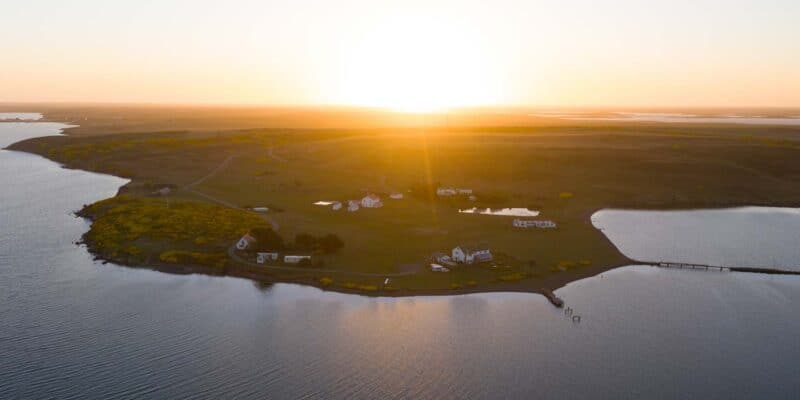
Darwin (1-2 Nights)
A long, dusty gravel road runs from the Mount Pleasant Airport toward the quiet settlement of Darwin. Comprised of just a small cluster of white houses topped with traditional green iron roofs surrounded by bright yellow gorse bushes, this would be our first taste of the Falkland Islands.
Our trip to the Falklands started here in the Darwin settlement to get a better understanding of a few of the important battles that took place in the Falklands War in 1982.
In addition to some important recent history, this settlement is surrounded by natural beauty. Just a little way in the distance is Mt. Osborne, the tallest point in the Falklands. The sunsets here are great in this peaceful setting. Standing in front of the Darwin Lodge, watching the sun colorfully set over the still landscape, it’s hard to imagine anything bad ever happening here.
How much time you want in Darwin will depend mostly on how interested you are in the war history. Many of the highlights here revolve around the war. It’s a great place to get a better understanding of what took place during the conflict of 82′ in the Falklands.
Top Things to Do in Darwin, Falkland Islands
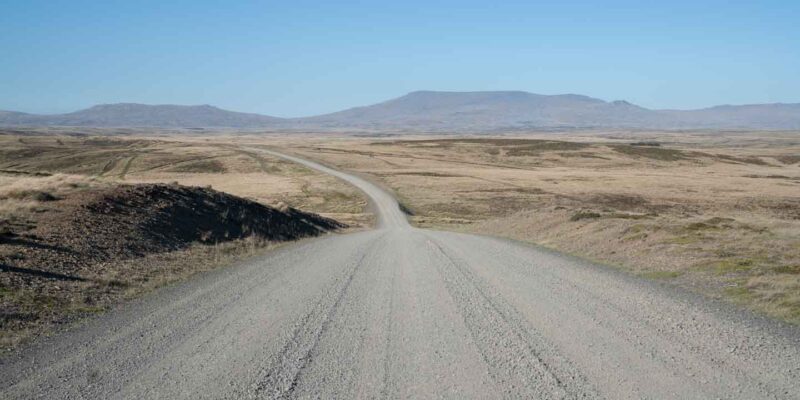
Battlefield Tour – The gently sloping grass-covered hills surrounding Darwin were host to some of the fiercest battles of the war. During our time in Darwin, Anton, the manager of the Darwin House, took us around by Land Rover to where the fighting took place in 82’.
As we blazed our own trail on the trackless hills, our guide painted a picture for us of what the landscape looked like the night the British troops took back the hills outside of Darwin. The Argentines were dug in positions on the hilltops with machine guns and mortars. The British 2 Para Division stormed the positions, taking them one by one after marching through the night to reach them.
As the fighting raged on, it took longer than expected to reach and clear the hilltops, and the British troops lost the cover of darkness. Still, they heroically forged on – eventually forcing the remaining Argentine soldiers to surrender. In the process, they took several losses, including one of their leaders, Col. H. Jones, who fell in the hills just outside of Darwin, the spot now marked with a memorial.
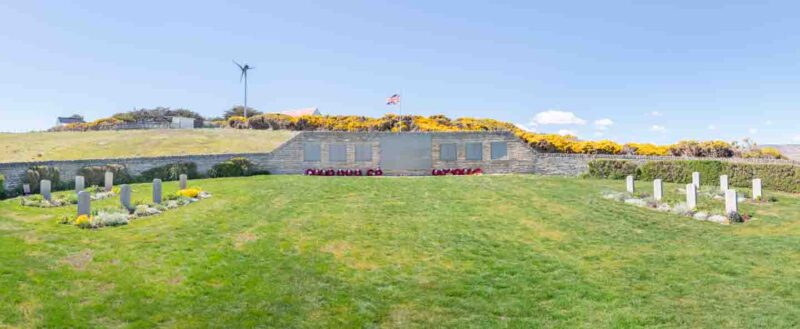
British Memorial – To commemorate the sacrifices made by the soldiers, there is a memorial overlooking the water in San Carlos near where the British troops first landed. Here, all of the soldiers & sailors who lost their lives defending the Falklands are remembered.
Here, a nicely manicured garden surrounds the grave markers, and just in front of the memorial is an excellent view overlooking the bay.
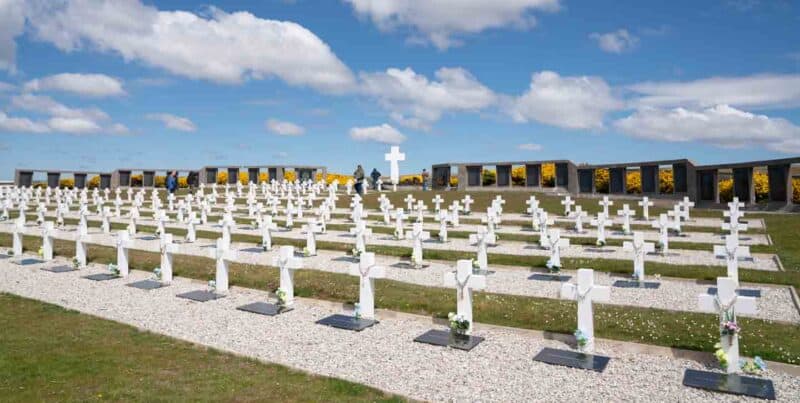
Argentine Memorial – There is also a memorial for the Argentine soldiers who died in the war. At the time they were buried, they were not able to identify soldiers, and many graves were marked by “Argentine Soldier Known Only by God.”
However, in recent years, DNA testing has been done to identify the graves of previously unknown soldiers properly. The focal point of this memorial is a large white cross that looks over all of the grave markers.
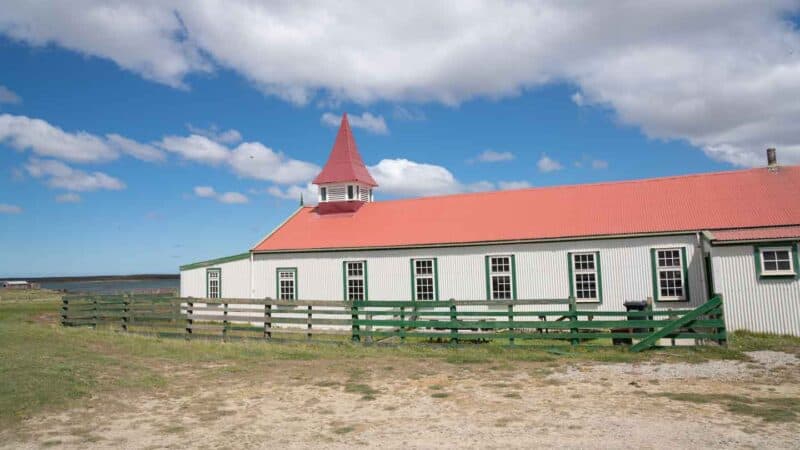
Goose Green – Goose Green was also another turning point in the war. Here inside the local community center, most of the nearby residents were held captive by Argentine troops for more than a month during the conflict.
The Argentines feared the settlers were relaying information back to the British troops, so they kept them confined to the small community center. In modern times, there is a war museum dedicated to the regiment of soldiers from the 2 Para division who liberated the town.
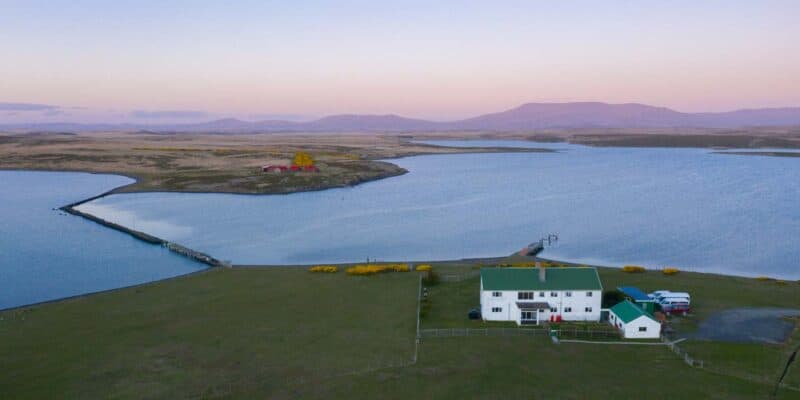
Mt. Usborne – A few miles to the north of Darwin is the tallest point (2,313 feet / 705 meters) in the Falklands, Mt. Osborne. In the evening, it glows pink when the skies are clear as the sun slowly sinks into the hills surrounding the small settlement.
Where to stay in Darwin – We stayed at the Darwin Lodge, which was one of the nicest lodges we visited during our trip.
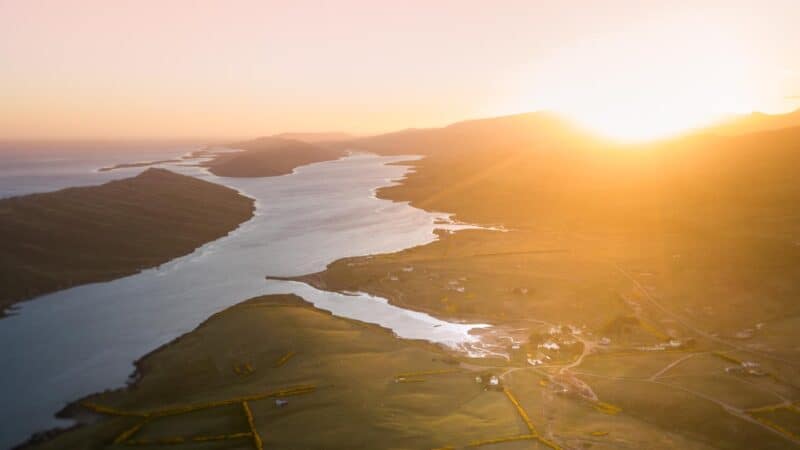
Port Howard (2 Nights)
The second stop on our tour of the Falklands was the settlement of Port Howard, which is one of the largest settlements in West Falkland, with around 100 people. The large community living here is a unique chance to see ‘camp’ life in the Falklands. There are also a handful of activities in and around the town that are unique to the area.
Due to the flight schedules, the only way you’ll be able to take a fishing trip and see some of the area highlights is to spend two nights here. Anything less than that, you might not get to see much.
Top things to do in Port Howard, Falkland Islands
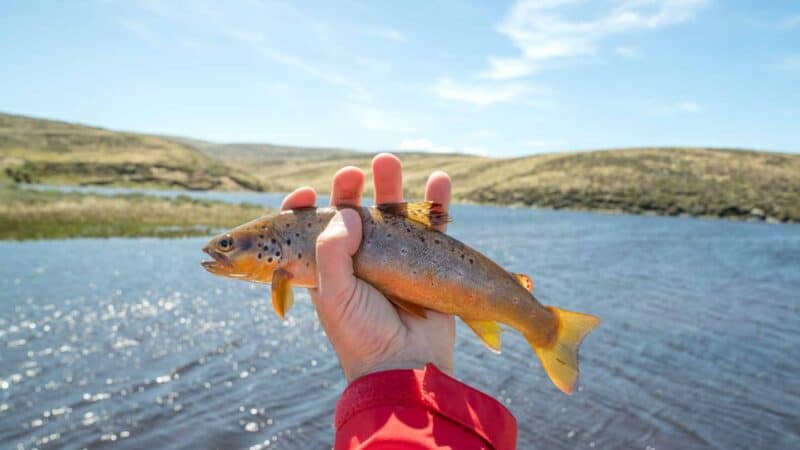
Trout Fishing – One of the top activities in Port Howard is a trip out to the Warrah River for some very good Trout fishing. We went out on a day of fishing on the Warrah with a local guide, who was also our host at the Port Howard Lodge, Wayne Brewer. He set us up with equipment, and we made the drive out to the point where the Warrah River met the sea.
From here, we cast our spinning bait into the shallow rocky portion of the river in hopes of pulling in a big trout. During our visit, the conditions were not in our favor, but we still managed to reel in a few nice trout. Even though we didn’t land a monster, it was still a nice day in a very scenic part of the Falklands.
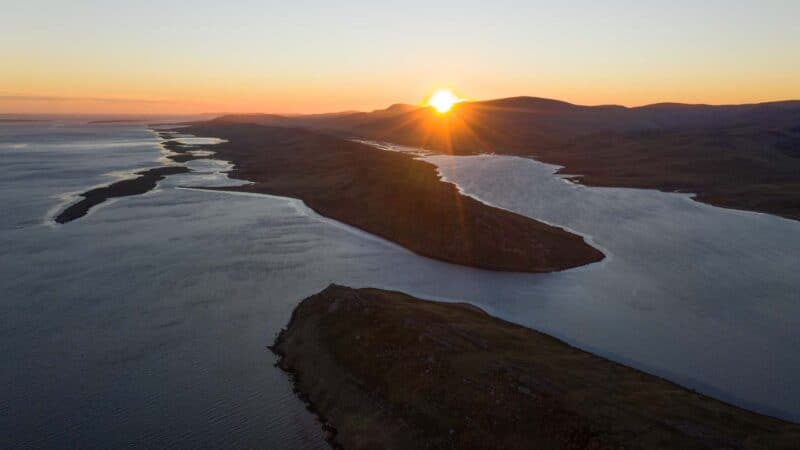
The Narrows – The bay of Port Howard is formed by two massive rock walls standing between the settlement and the sound that divides East and West Falkland. Between those walls is a small gap, which is known as the narrows.
The unique geography provides a very calm harbor and provides shelter for boats and marine life. From the dock in Port Howard, you can often spot dolphins cruising around the harbor. The sunsets here are also pretty amazing.
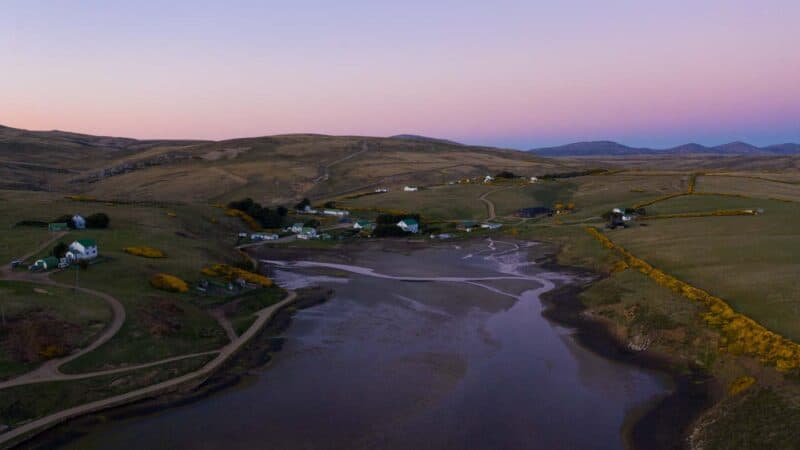
Exploring the Settlement – Be sure to take some time to walk around and see what life is like in this small community. During my time walking around the town, there were two baby lambs that took a special interest in me, and every time I walked along the main road, they would run after me, following me until they lost sight of their home before they turned around.
Hikes – In Port Howard, one of the best things to do is go out and explore the many hikes around the settlement. Some of the most challenging ascend the 2000’+ tall Mt. Maria with great views of the town and some interesting rock formations. Another one not to miss is the walk along the top of the hills that form the Narrows of the harbor for more great settlement views and a look into the Falkland Sound.
Land Mines – Still, after more than 35 years, remnants of the Falklands War are still scattered around the country. Here in Port Howard, there are active de-mining efforts underway with hopes of clearing the mines in the near future.
Luckily, in the Falklands, the Argentine Forces made very detailed maps of the minefields they planted because they had hopes of settling there. So, unlike other minefields left over from wars in other parts of the world, there are known locations and mine counts – making the process much safer.
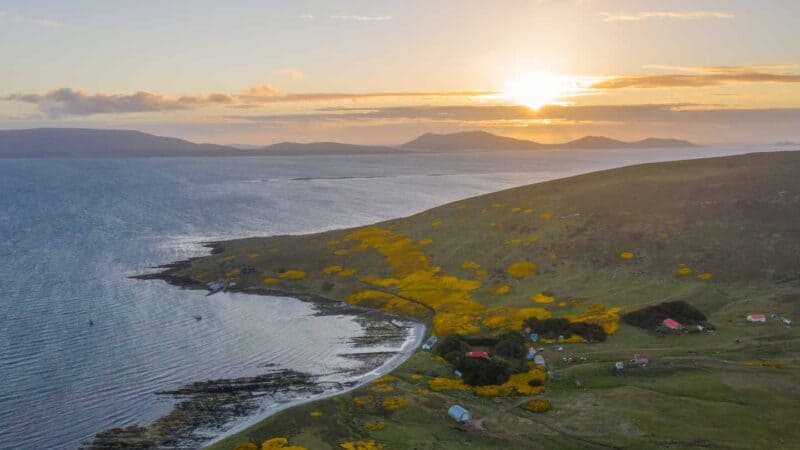
Carcass Island (2 Nights)
Carcass Island was our first taste of Falklands wildlife. Just steps from the lodge, we were on the rocky beach teeming with wildlife. Named for the HMS Carcass, the island is a favorite among wildlife enthusiasts, and it’s also a great jumping-off point to explore the Jason Islands as well as Westpoint Island.
Highlights of Carcass Island
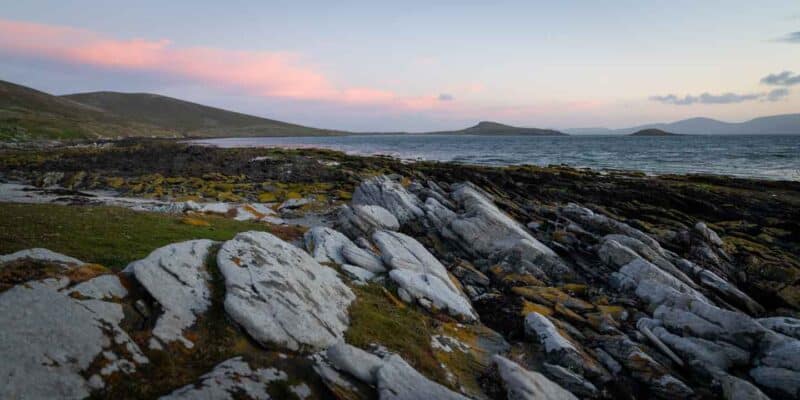
The Beach Walks – Most of the action on the island is found along the beach just in front of the lodge. Narrow tracks bring you along the length of the beach with chances to see penguins, steamer ducks, and even some endemic species like the Cobb’s Wren. If you aren’t up for a long hike, Carcass Island has plenty to see within 30 seconds of the lodge door.
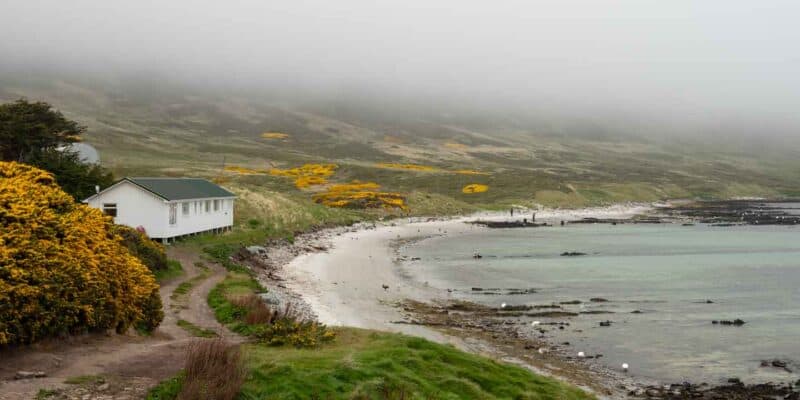
The lodge atmosphere – One of the aspects of a trip to the Falklands I wasn’t expecting was the social side of the lodges. The thing about the Falklands is that there aren’t many schedules, but if there is one important time of the day, it’s dinner time.
After a day of exploring, everyone gathers around the table, and you have people from all around the world sharing stories from their day and tales from every part of the world.
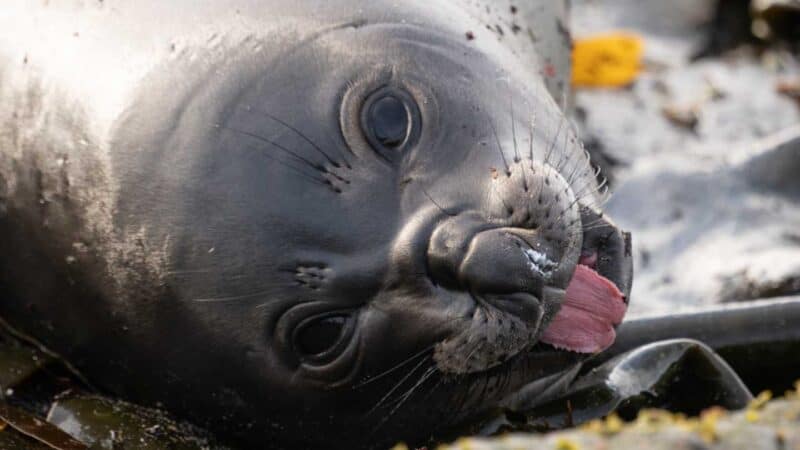
Elephant Seals – Near the airstrip, you can always find elephant seals lounging on the beach. They are generally slow-moving and laid back, and while not the most attractive, there are good photo subjects.
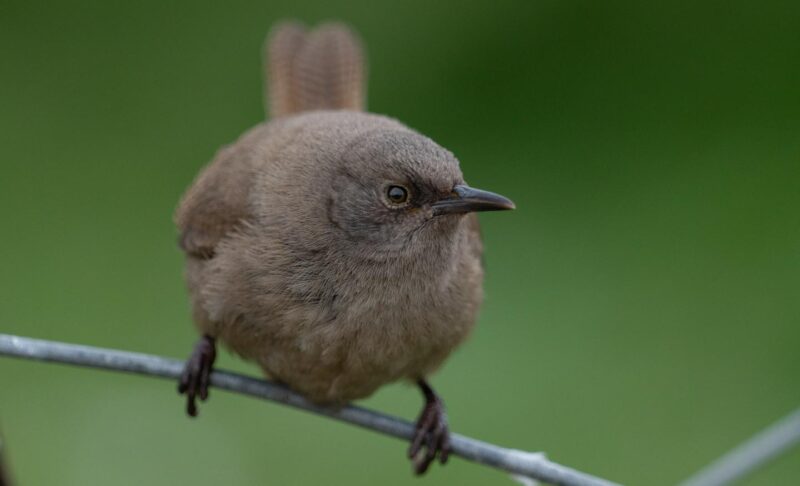
Cobbs Ren – One of the endemic species to the Island, you can find the Cobb’s wren fluttering around on the shores and trails of Carcass Island. These little brown birds are fast-moving, so be sure to have your camera ready if you happen to spot one.
West Point Island (Day Trip From Carcass Island)
Another personal highlight of our visit to the Falklands was on Westpoint Island. We took a day trip here from Carcass Island by boat to see a massive albatross colony. On the day of the visit, we were the only ones here surrounded by thousands of albatrosses.
I think this particular stop will always stick out in my mind as one of the most memorable days. Not just because of the amazing wildlife but also because we had it all to ourselves. To see something this amazing and have it all to yourself, where else in the world can you have that anymore? I think it was this day, standing on the edge of the cliffs at Westpoint, that it hit me how special the Falklands really are.
The sense of freedom here is unlike any other place I have ever visited. Of course, respecting the wildlife is required, but other than that, you are free to roam, explore, and linger here as long as you’d like.
I found myself quietly sitting all day, filling my memory cards with photos and videos of this special place. From time to time, I would set my camera down and just take in how lucky I was to not only be here but to be the only human in sight.
Must See Things on Westpoint Island
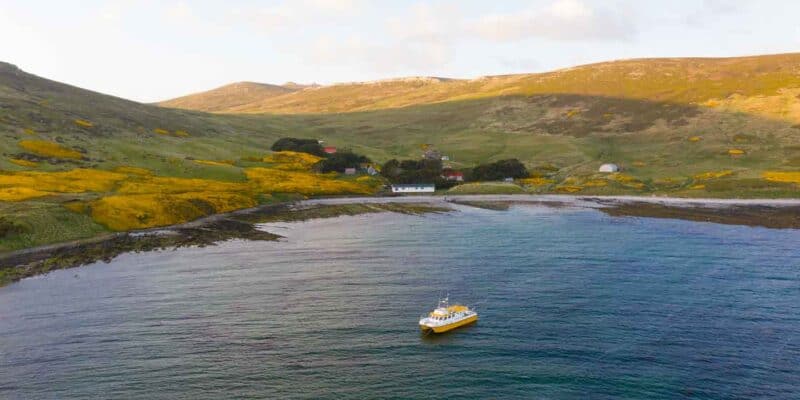
Scenic Boat ride to Westpoint – The trip over to the island is more than just transport. Along the way, we encountered stunning scenery and the chance to see other wildlife on the water.
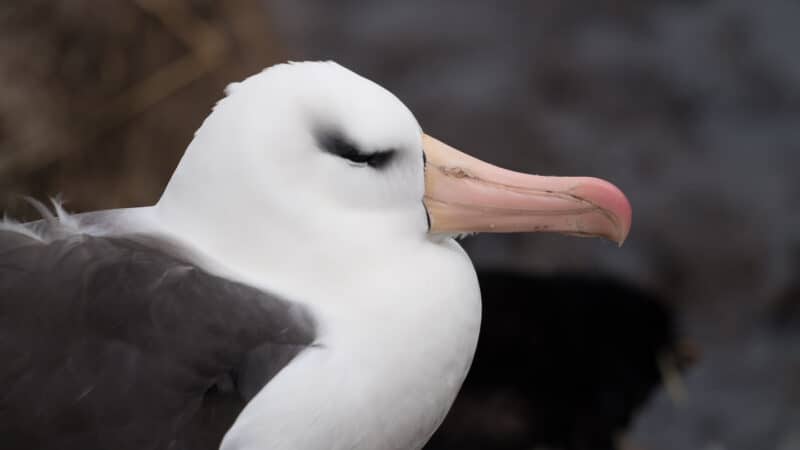
Albatross Colony – The main draw to the island is the huge colony of Black Browed Albatross that have their nests set just in front of some stunning rock formations. These birds build impressively large nests out of clay shaped like a pot.
The birds didn’t seem to mind our presence. The albatross carried on with everyday life, with us standing just a few feet away. We were so close we were almost in the landing pattern. You can find a constant rotation of albatrosses coming and going from the colony.
They are regal and impressive birds while on the nest and in the air, but they lack some grace when coming in for a landing. They swoop in with their big webbed feet outstretched like a plane with oversized landing gear, making clunky adjustments as they line up their less-than-graceful landings.
Rock Hoppers – The albatross might be the headliners here, but rockhopper penguins are my personal favorite penguins. I just love their big, bushy yellow eyebrows and pudgy physique. Living side by side with the albatross, the rockhoppers have built their nest at ground level.
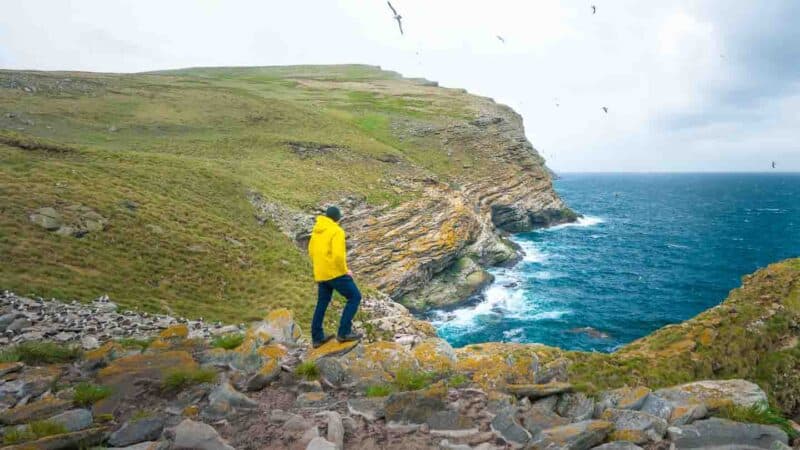
Rock Formations – Even if these cliffs weren’t covered in albatross, they would still be worthy of a visit. Springing out of the sea a few hundred feet, the rugged rock walls are topped with bright green grass and drop straight off into the sea.
Sea Lion Island (2-3 Nights)
It’s hard to pick a favorite stop in the Falklands, but Sea Lion Island would be high on that list. This small island is teeming with wildlife. In the small footprint of Sea Lion Island, you can see most of the Falklands’ most interesting species. In addition to the animals, you can spot that the landscape is also dramatic and varied.
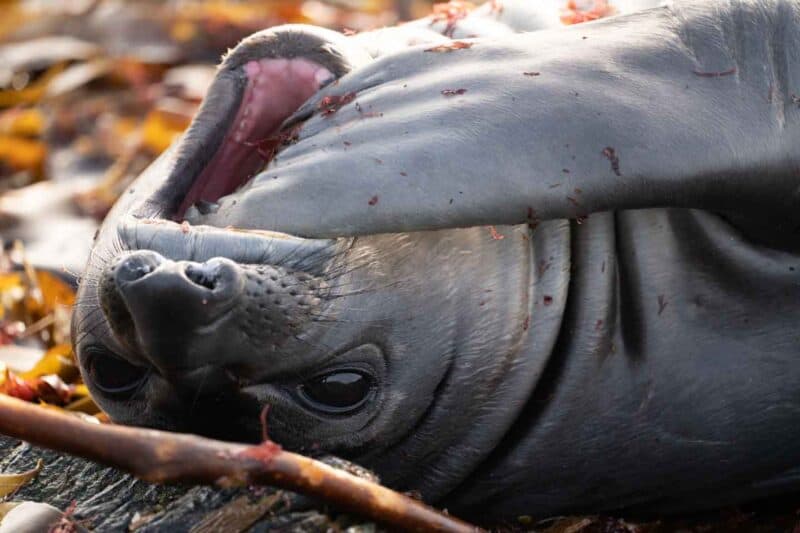
Sunrise on the Northern Beach – I am more of a sunset person, but here, I made sure to set an alarm to wake up with the sun and spend the morning on the beach. During this time of the day, the soft light is very nice for photos, and I came back with some of my favorite shots of the trip. The elephant seals and penguins must have also set their alarms because they were all out playing on the beach.
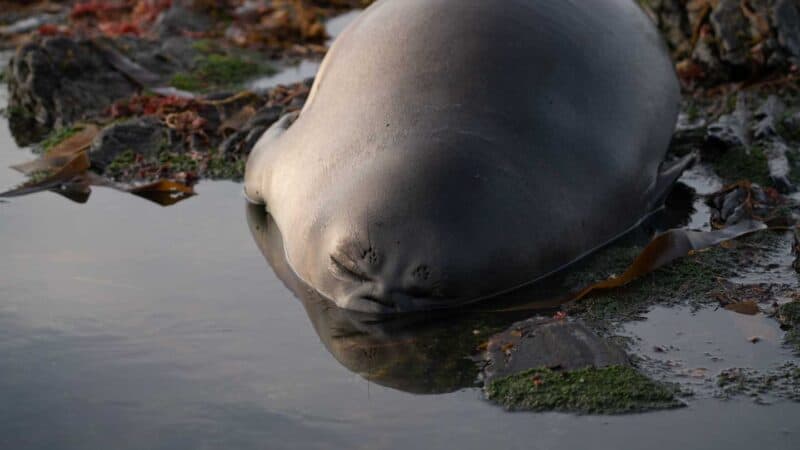
Orca Pools – One of the main reasons I woke up early every morning here is because of a few shallow inlets locally known as the Orca Pools. The Orcas or Killer Whales here have devised a unique technique to hunt seals here on Se Lion Island.
When the tide is right, the pools created by rocks fill just enough for an orca to swim in and catch a seal pup splashing around in the shallow waters. It’s usually known to happen in the mornings, but it’s rare to see it happen. We did, however, see a few tall dorsal fins lurking around the pools, but we didn’t get to see this amazing feat in person.
Elephant Seals – The locals jokingly say the island should have been named Elephant Seal Island because the beaches are absolutely covered in them. They outnumber the sea lions substantially and have become one of the main draws to the islands.
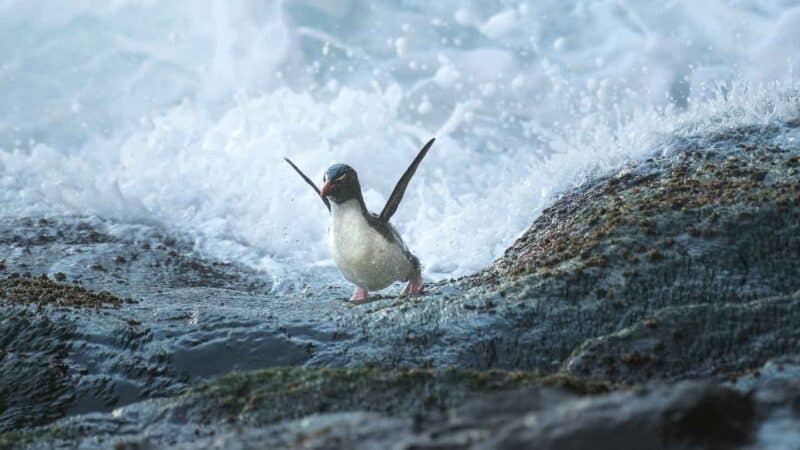
Rockhopper Penguins – We spent hours just watching the rockhoppers come and go from fishing. Making it out to sea and back is no easy task for the rockhopper penguins in Sea Lion Island. They have to make their way up and down a tall, steep cliff with waves crashing against a rock wall.
It was amazing to watch them do it. For as chubby and unathletic as they look, they are actually amazing animals, you end up cheering for them to make it back up and fight against the odds.
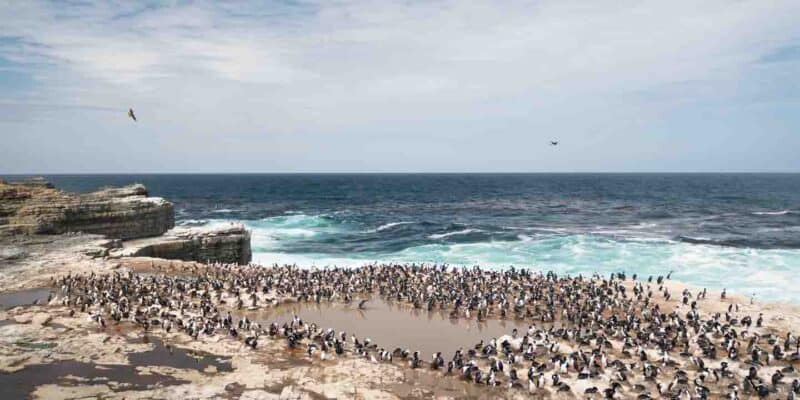
Cormorants – On Sea Lion Islands, the cormorants have one of the most picturesque homes on the island. They’ve chosen to form a colony on the top of a rugged cliff overlooking the sea. The rocks here have split and cracked, creating all sorts of interesting formations, and it’s amazing to take photos from up here.
Rocky cliffs on the north – The central northern shores of Sea Lion Islands are bordered by tall dramatic cliffs dropping sharply into the sea. They are home to all kinds of birdlife and some great wildlife viewing. In addition to the animals that live here, the rock formations themselves are quite impressive and picturesque – a must visit while on Sea Lion Island.
Gentoo Penguin Colonies – Well inland, several colonies of gentoo penguins have built their nests and were patiently waiting for their eggs to hatch during our early December visit.
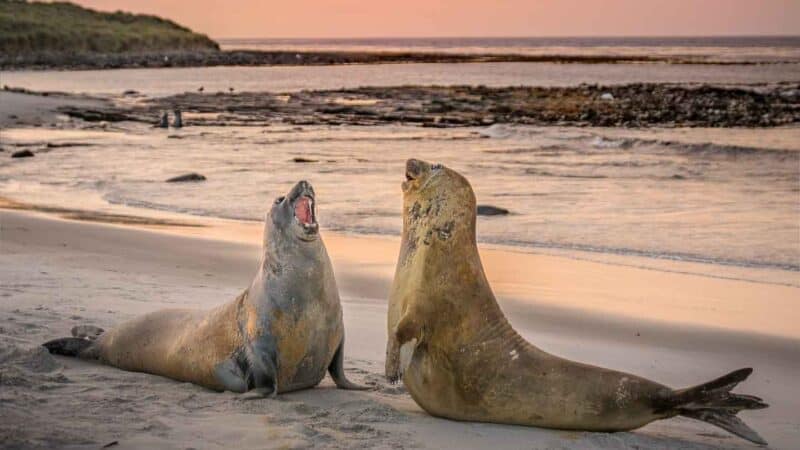
Sunsets on the Beach – Another special time on Sea Lion Island is sunset. In the hours before dark, many of the penguins are coming in from fishing and seals, and their pups are gathered on the beach in large numbers. The soft light at the end of the day makes for another great photo opportunity. We had a few spectacular sunsets during our time here, with pastel skies and active wildlife.
So active, we were stuck on the beach for an hour longer than expected, caught between watching two adult elephant seals battling and our path back to the lodge. We didn’t mind a little bit of a Falklands-style traffic jamb at the end of the day, and we got some great photos of the action.
Evenings at the Lodge – One of the aspects I grew to really enjoy was the time after the sun had set and everyone visiting the island gathering for dinner. The conversations that came from our time in the lodge I really enjoyed. You are surrounded by people from around the world, all with common interests in wildlife, photography, and travel.
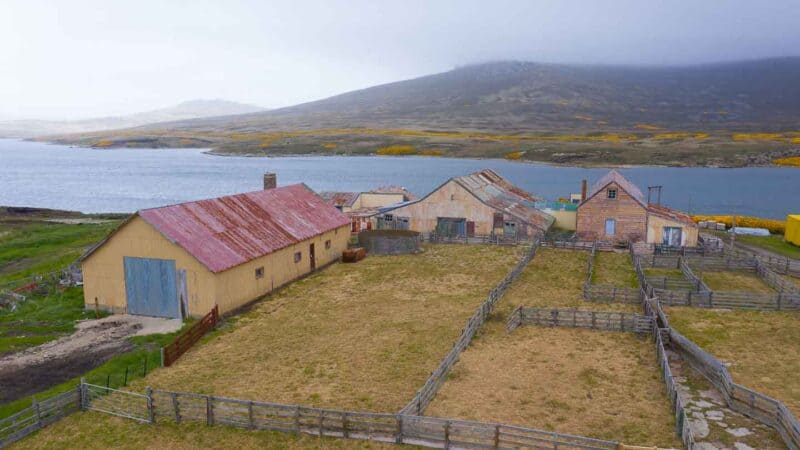
Weddell Island (2 Nights)
The largest island after East and West Falkland is Weddell Island in the far west of the archipelago. Weddell Island is roughly five times larger than Manhattan and is reportedly the largest privately owned island in the entire world. During the time of our visit, there were three people here. The sense of remoteness found in Weddell Island is going to be hard to top.
In addition to having such a huge space virtually all to yourself, the other appeal here is the unique species found on the island. One of the original owners of the island, in which it gets its namesake, introduced a lot of exotic species to the island, some of which are still around nearly 100 years later. Some of the most famous residents are the Patagonian foxes and Reindeer.
Highlights of Weddell Island
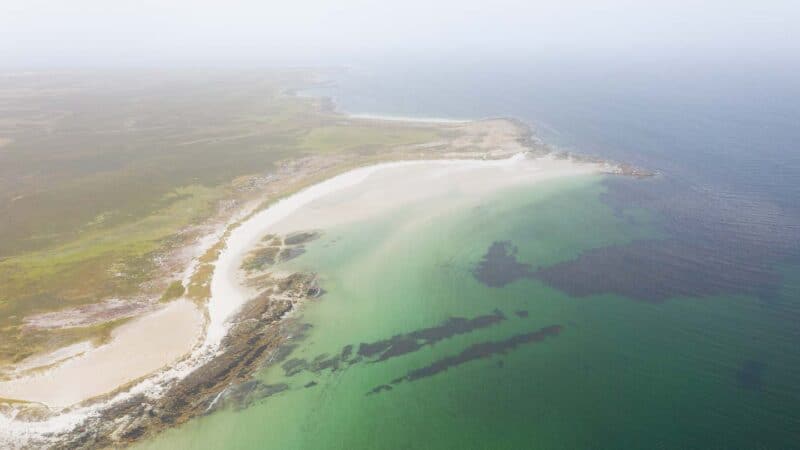
Loop Head – Walking the beaches on the northeast peninsula, known locally as the Loop Head, feels like you are walking on beaches that haven’t seen human footprints in a long, long time. Green grass pastures with sheep gazing on top of short bluffs give way to white sand beaches and turquoise waters.
Mount Weddell – Impressive to look at and intense to climb, towering over the old settlement is Mount Weddell. In November and December, the base of the mountain is covered in bright yellow gorse that gives way to patches of green grass and massive stone runs scattered in between. If you stare long enough at the piles of gray rocks, you can begin to see shapes like whales and other imaginary figures.
Patagonian Foxes – A highlight of any trip to Weddell Island is to spot a fox. Found only on Weddell Island (fortunately or unfortunately) due to being introduced by humans, the Patagonian foxes can still be found around the island. We found a few in the distance from the seat of the Land Rover, but they were a bit too quick to get a good shot of them.
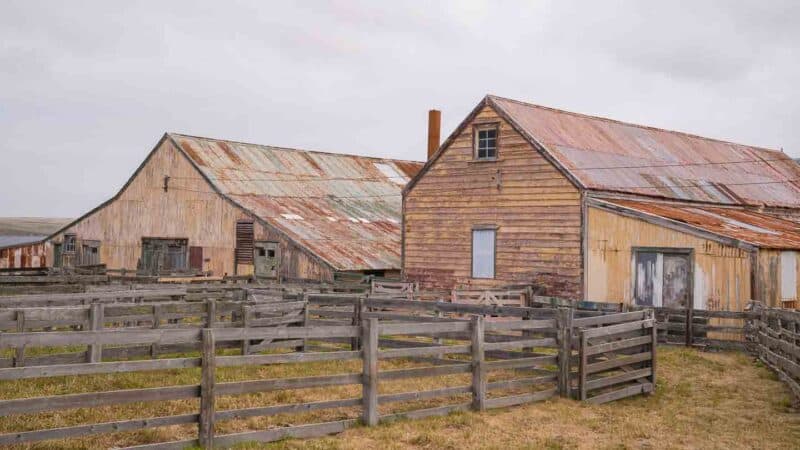
Old Farm Buildings – One of my favorite parts of Weddell Island was the old farm buildings. The colorfully painted wooden buildings had just the right amount of wear and peeling paint that made them super photogenic.
Volunteer Point – (Day Trip From Stanley)
With a trip full of amazing wildlife experiences, our day trip to Volunteer Point was a highlight among the highlights of our trip to the Falkland Islands. The beautiful King Penguins in this beautiful setting is a wildlife encounter of a lifetime.
Make sure to read our detailed Volunteer Point guide and see all the amazing wildlife we saw. Volunteer Point is the highlight for those visiting the Falklands on an Antarctica cruise. Tours sell out fast. We recommend booking this tour in advance to secure a spot.
Highlights of a trip to Volunteer Point
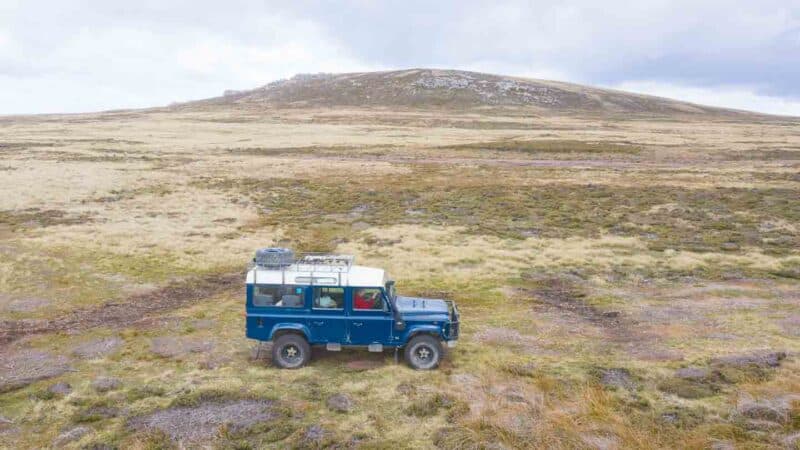
The Drive – Notorious among locals and visitors that have made the journey, the road, or lack thereof, is part of the experience of visiting Volunteer Point. From Stanley, the ride will take you around 2-2:30 hours.
The first 30 minutes from Stanley is easy on a well-maintained gravel road, but things quickly change to a bumpy and boggy track through a sheep farm on the way to Volunteer Point. Even the best drivers occasionally get ‘bogged,’ stranding their highly capable Land Rovers in the muddy peat bogs up to the top tread of their tires.
The landowners have no intention of making the road any better than it is. It’s part of the experience, and it makes seeing the king penguins even more special once you make it there. Embrace the journey. If you happen to get bogged down, help is never too far away – plus, you have a story to tell back home.
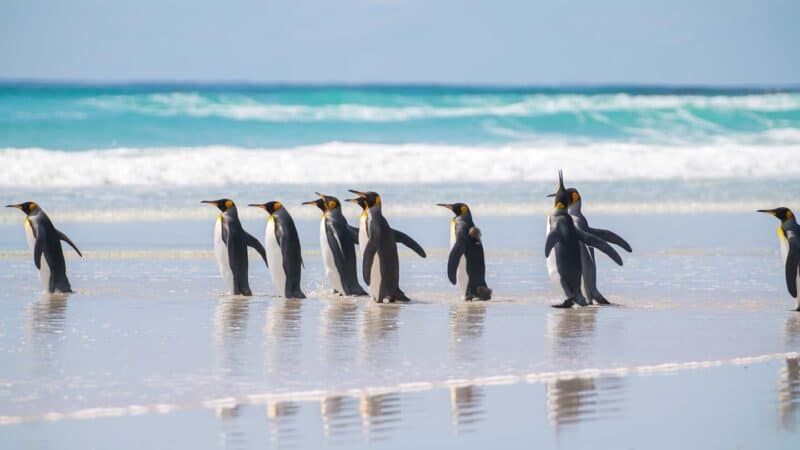
King Penguins on the Beach – This is the perfect vision of the Falklands King penguins waddling down the white sand beach and diving into turquoise waters. Volunteer Point is nothing short of magical.
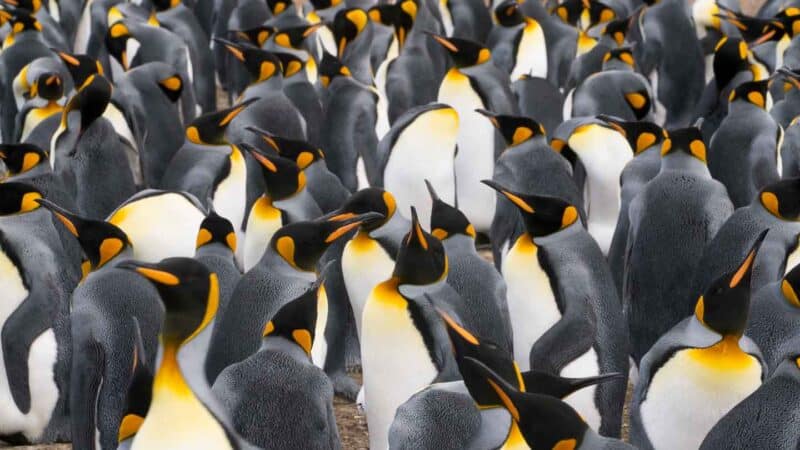
King Penguin Rookery – Following the squawking, your ears will lead you to an area just inland from the beach that the King penguins have chosen for nesting grounds. Here, you’ll find hundreds, even thousands of penguins.
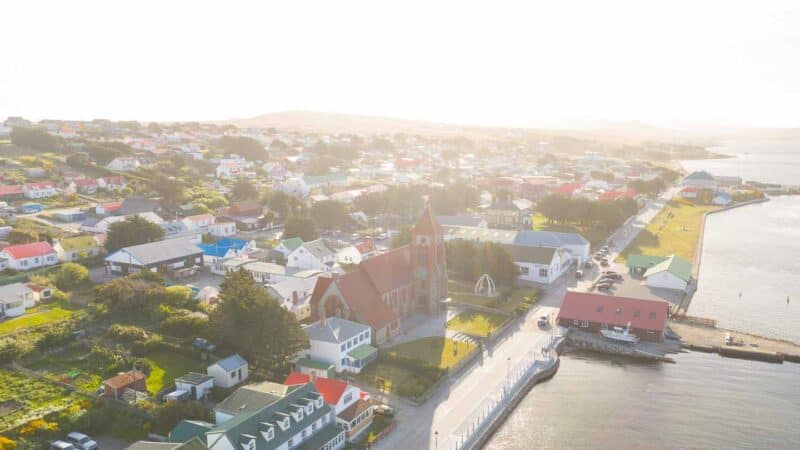
Stanley (3-4 Days)
The last stop of our two weeks in the Falklands was to the big city of Stanley. Over 90% of the population lives in Stanley, which is around 3,000 residents. However, just because it’s the biggest city doesn’t mean there aren’t plenty of adventures and things to do in and around Stanley.
It’s best to plan your time in Stanley toward the end of your trip so you are in town and ready to make your flight out of the Falklands from the main Mt. Pleasant Airport.
3-4 days might seem like a lot of time for the main city, but you’ll want about that much time to see everything here, especially if you take a day trip to Volunteer Point , which we highly recommend.
Best Stanley & Berthas Beach Private Tour
Stanley highlights.
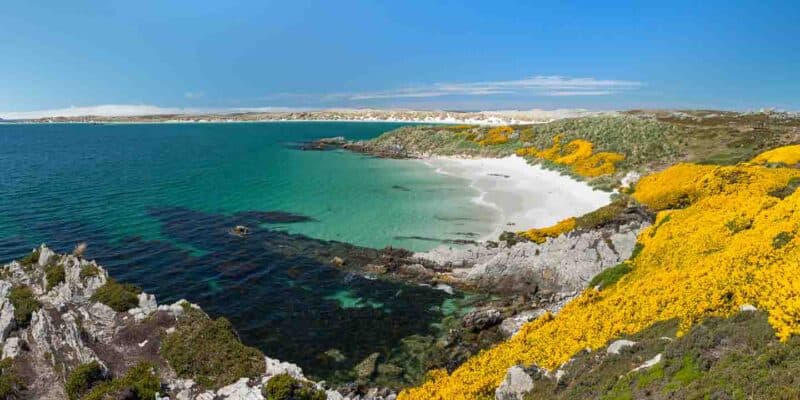
Gypsy Cove – One of the top sights in Stanley is the stunning white sand beach and turquoise waters of Gypsy Cove. This is my favorite tour in Stanley . It is a private tour where you pay one price for the whole vehicle, not per person. It visits some of the best things to do in the Falkland Islands: Gypsy Cove, Bertha’s Beach, Yorke Bay, Lady Elizabeth Shipwreck, and Stanley city tour.
If you visit in November and December, the hills should be covered in bright yellow gorse, adding an extra pop of color to your photos. Here, you’ll also find plenty of Magellanic Penguins nesting in the hills and sunning on the beach.
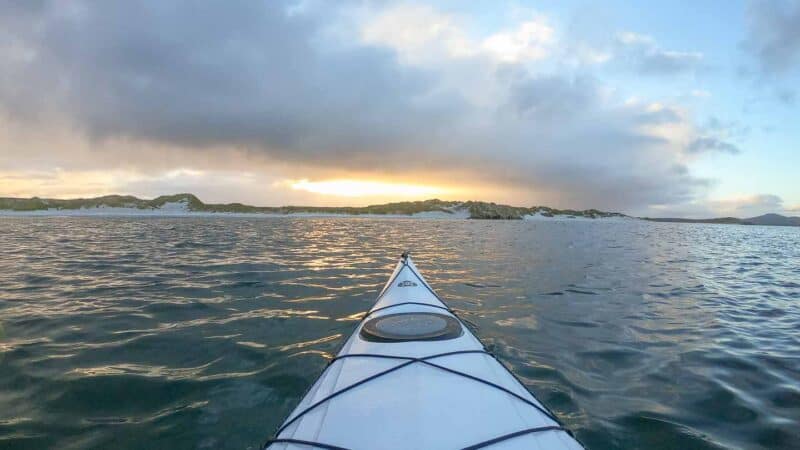
Sea Kayaking – One of my favorite adventures we went on in the Falklands was a sea kayaking trip around the islands near Stanley with Dan from Falkland Outdoors. We cruised around the uninhabited islands near the city and found curious sea lions, great landscapes, and plenty of wildlife.
We also took our kayaks up to the beach of Gypsy Cove for another angle at this famous spot. Check out this and other tours offered by Falklands Outdoors .
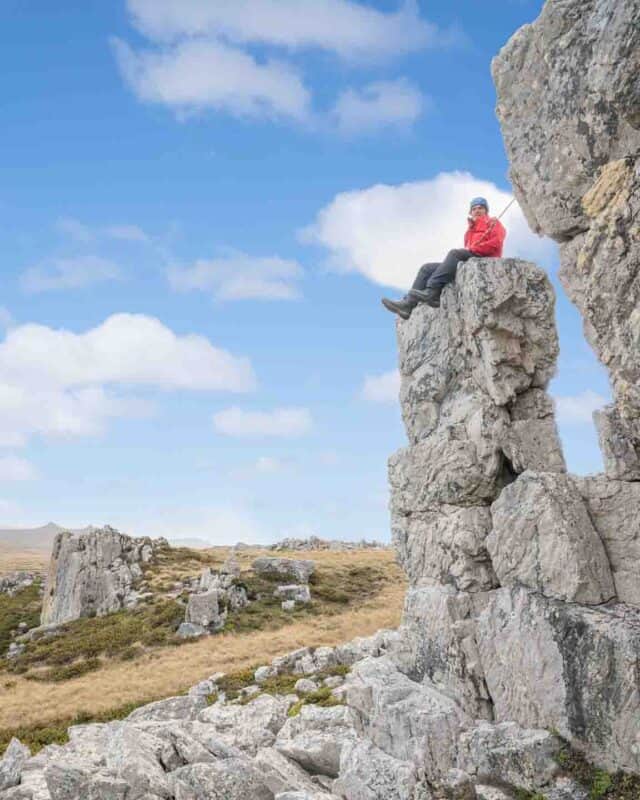
Rock Climbing in the Stanley Mountains – Another adventurous thing to do in Stanley is to gear up and go rock climbing in the mountains just outside the city. Many of the mountains in the Falklands are topped with outcroppings of rocks that are perfect for climbing. This is another adventure tour offered by Falklands Outdoors worth putting on your list of things to do in the Falklands.
Visit the Stanley Museum – The Historical Dockside Museum – A stop here will give you a great insight into the history of the islands, which is probably even more interesting than you expected. Don’t miss the Video on the Falklands War. It helps to put a voice and picture behind the things that happened here.
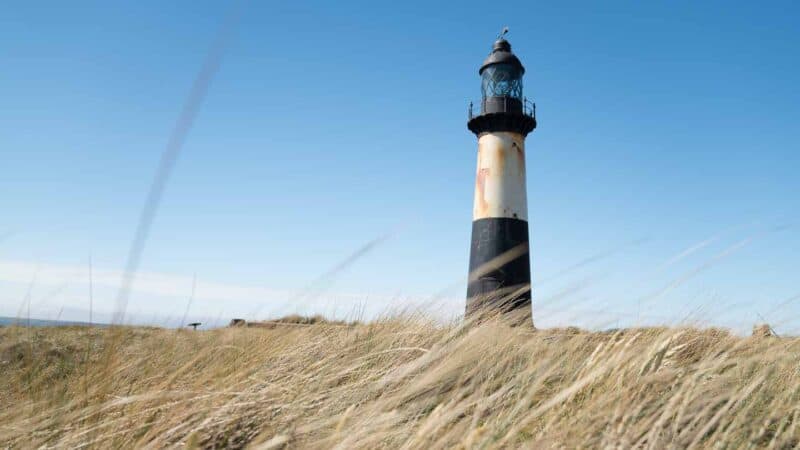
Cape Pembrook – Another great stop in Stanley is the lighthouse of Cape Pembrook. Here, you’ll find a classic white and black lighthouse that guided many ships safely in and out of the Falklands. It was damaged in the war and has since been retired, but it still stands as a symbol of the maritime heritage of the islands.
Stanley Mountains Battle Field Tour – A hike up Mt. Longden is a slow, gradual climb back into the year of 1982. Here, high in the hills outside of Stanley, you can still see many reminders of the war scattered about.
Visit the Lady Elizabeth Ship Wreck – Scattered around the harbor in Stanley are a few old shipwrecks that were damaged while sailing and laid to rest here. In earlier times, they were placed in the harbor and used for storage.
Most have broken down over the years, but the iron ‘Lady Liz,’ as the locals call her, is the last relatively intact hull still standing. There are two more wrecks that are closer to town, but there isn’t much left from their wooden hulls above the surface anymore.
If you want to visit Lady Elizabeth Shipwreck and some Stanley attractions, including Gentoo penguins, Magellanic Penguins, King Penguins, and more. We suggest booking this Stanley Falkland Islands tour , which visits all those Falkland attractions.
Further Travel Information and Tips for Visiting Falklands
Wi-fi in the falklands for visitors.
The main source of internet in the Falklands comes from prepaid internet cards that can be purchased in several places in Stanley and a select few of the settlements. Most of the lodges I visited had a hotspot to connect to the internet.
For 5 Falkland Islands Pounds, you could connect for 45 minutes. The service seemed to be totally dependent on time rather than data usage. So, to conserve your credits, you can type messages and emails before connecting and send them after logging in.
Once connected, the internet speeds were usable, faster than I had expected. I could complete most tasks online and even send pictures and short video clips. However, connecting seemed to be the issue. There are apparently only so many slots, and once those are filled, you won’t be able to connect. I found it difficult to connect, but especially just after work hours, around 5-7 p.m. seemed to be the worst.
The cards work by connecting to a hotspot and then entering the serial number and passcode revealed by a scratch-off panel on the back of the card. You may log on and off with the cards using your 45 minutes.
Best Weather Apps and Forecasts in the Falkland Islands
Weather forecasts are hard to come by at the ends of the earth, but there are a few good apps you should use to get some pretty accurate information.
Don’t Forget to Pin Me for Later
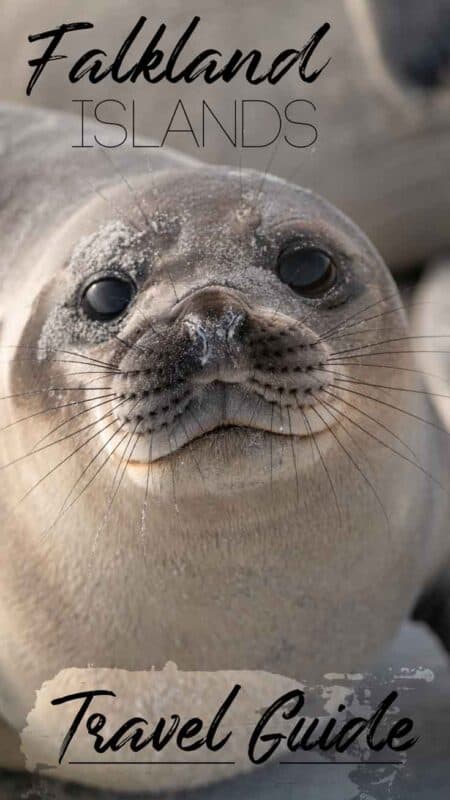
- Work With Me

- Sierra Leone
- South Africa
- United States
- New Zealand
- Falkland Islands
- Netherlands
- Accommodation
- Electrical Gear
- Essential Gear
- Working Abroad
- Blogging Resources
Falkland Islands , South America
21 things to know before you visit the falkland islands.
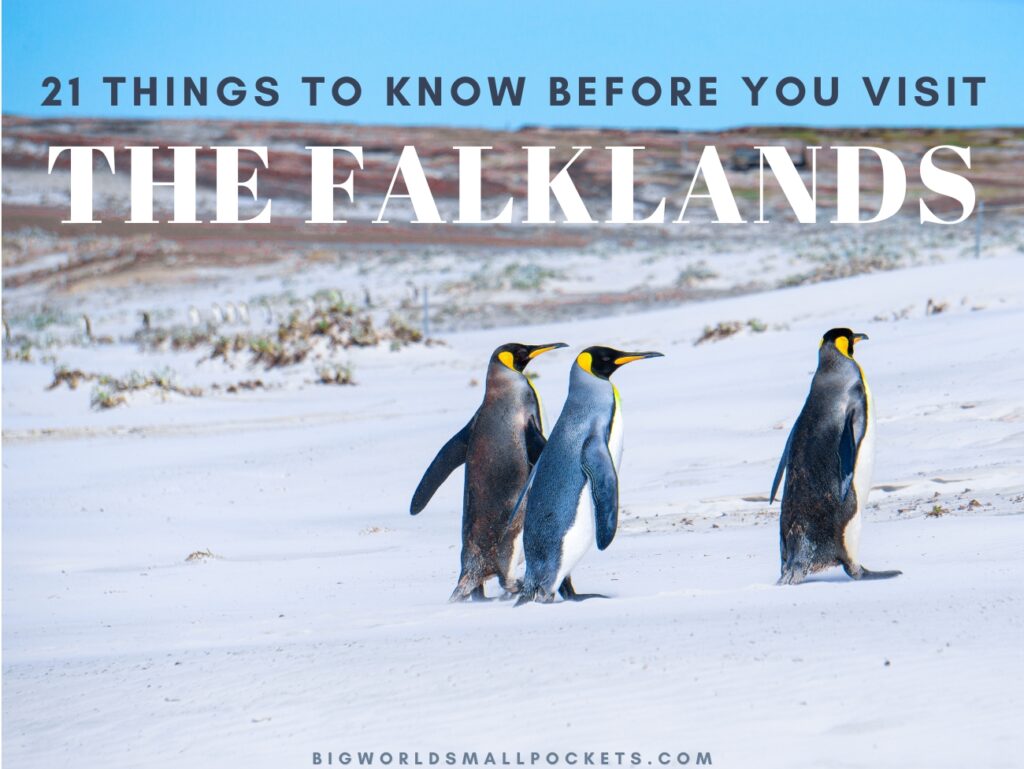
I think it’s pretty fair to say, there isn’t much practical info online about visiting the Falkland Islands!
In fact, when I was planning my trip there it was almost impossible to easily discover many of the barebones facts of what it takes to plan a trip there, especially if you’re trying to visit this amazing archipelago independently.
Which is exactly why I’m bringing you this post – hoorah!
Filled with all the info needed to prep your visit to the Falkland Islands, these 21 things to know cover all aspects of your travels there, including the best time to visit, how long to spend there, what to do when you’re there, where to stay and what to expect.
I hope you find it useful!
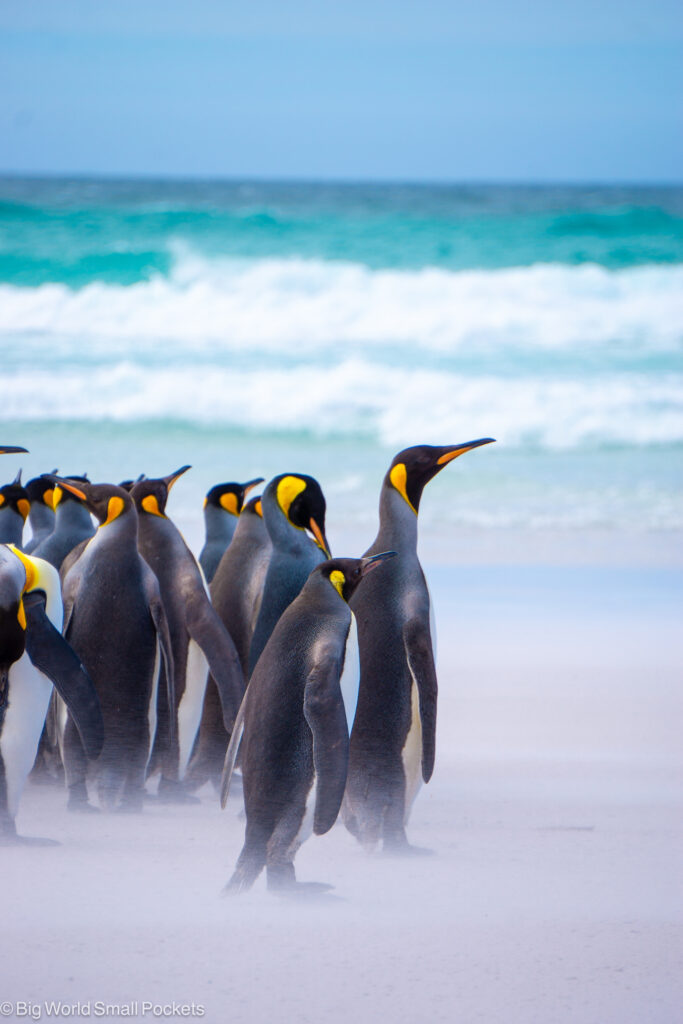
Related Posts
- Top 13 Things to Do in the Falkland Islands
- All You Need to Know about Travel to Sea Lion Island, Falklands
- 20 Best Things to Do in Stanley, Falkland Islands
Planning a Falkland Trip
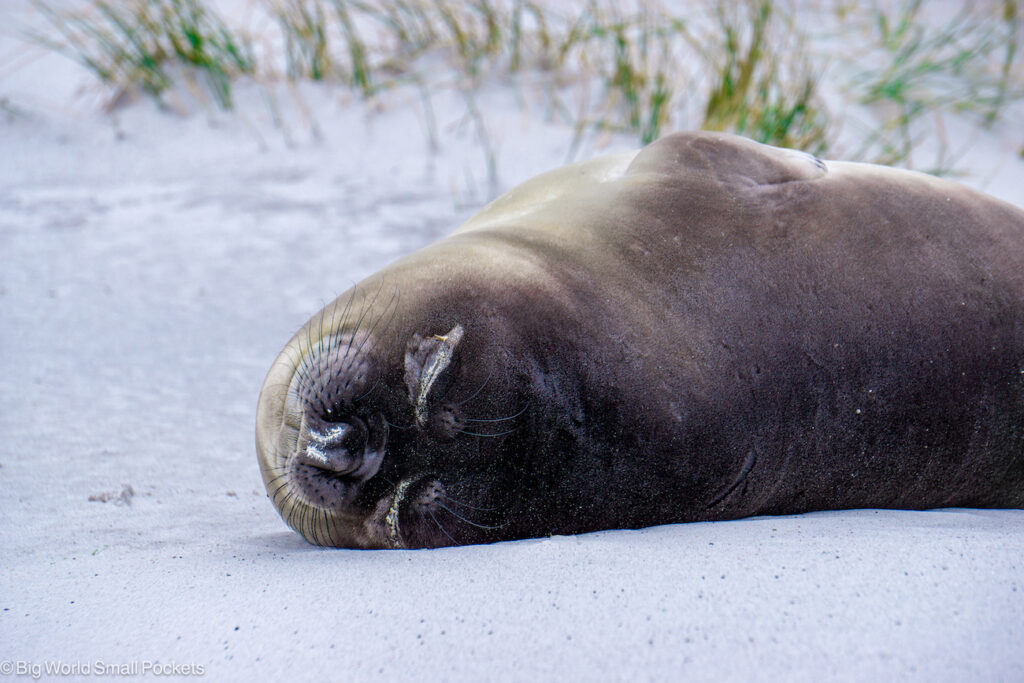
#1 Best Time to Visit
The best time to visit the Falkland Islands is definitely during their spring or summer season, which falls between the months of November and March.
This is when the weather is at its most travel friendly (i.e. you’ll get the least flight disruption!) and it’s the breeding season for many of the island’s top wildlife populations – which means you’ll get the best sightings and snaps of the animals too.
#2 How Long to Spend There?
I suggest you spend at least 7 days in the Falkland Islands to get a good flavour of this incredible destination.
If you can afford 2 weeks, even better!
Because of the limited flights to the islands – see below – it’s often better to plan your trip in week-long slots (to fit the flight patterns).
While this will allow you to spend 7 full days on the islands, don’t forget to factor in a minimum of 2 days either side of your time there for travel to and from you home country.
This means most trips to the Falkland Islands will last a duration of 11 days in total – 2 days travel there, 7 days on island, plus 2 days travel back.
#3 Ideal Falkland Itinerary
If budget allows, I really recommend getting out of Stanley to experience many of the smaller islands, as this is where the best wildlife and remote Falkland experiences can be enjoyed.
Anywhere outside of Stanley in known as “camp” in the Falklands, and you’ll hear this expression a lot!
1-2 nights on each outer island is a good shout.
The number of islands you plan to visit will largely depend on 2 factors…
- your trip budget
- lodge availability
This is because, with limited accommodation on most of the outer islands, things are both expensive and get booked up early.
Outside of that, I’d plan to have at least the first and last night of your Falkland trip in Stanley to ensure damage limitation to your plans in the case of disruptive weather.
#4 Money & Currency
The Falklands, as an overseas British territory, use Pound Sterling as their currency.
They do however, have their own notes and coins with Falkland imagery.
Falkland notes and coins can only be used in the Falklands, but you can use traditional sterling anywhere here.
If you’ve been to Jersey in the Channel Islands (where I grew up!), it’s a similar thing!
Most places in the Falklands, however, allow you to pay on card, so you don’t even really need much cash.
If you do find yourself in an emergency, then there’s one bank on the Falkland Islands in Stanley.
It has an ATM.
#5 Climate & Weather
The Falkland Islands lie in the South Atlantic off the coast of southern South America.
In relative terms, the islands are not that far from the Antarctic Peninsula!
This means they get some pretty wild weather and things definitely shift quickly out here.
In the winter (from May to Sept) the islands are cold and wet and grey.
Average temperatures are only around 2 degrees Celsius at this time and, although they do dip below zero especially at night, snow is not that common in the Falklands, given its generally low-lying terrain and plethora of the sea and salt air.
Weather patterns however, do play havoc with travel, so many lodges and tourism services shut down during the winter months here.
In the summer (from Nov to Mar), the islands are warmer and drier, but still only hover at an average of around 10 degrees Celsius.
Blue skies days are common, but the wind picks up something crazy, so you’ll still want to bring plenty of warm clothing layers!
#6 What to Pack & Travel Insurance
And on that note, we’ll segue perfectly into what to pack for the Falkland islands!
Almost everyone will visit this archipelago during the summer, so this complete Falkland packing list I wrote covers everything you need to bring for travel in that season.
If you’re looking for a short hand version however, then it’s hiking boots, warm socks, windproof jacket, good base layers, sunglasses, sunscreen, decent camera, warm hat and gloves, active trousers, fleeces and a good daypack.
Alternatively, if you’re a long-term traveller, digital nomad or frequent remote worker seeking travel health cover, check out Safetywing’s Nomad Insurance policies.
#7 Wifi & Data
Sure are the network providers in the Falklands and while they do have roaming agreements with some UK providers, such as Vodafone, it’s incredibly expensive to use your phone or data connection here,
So too is wifi connection in the Falklands, so don’t expect any accommodation or cafe you visit to have free wifi!
Your best bet in the Falklands is to buy some of Sure’s wifi cards, which can be scratched off to reveal a code that allows you internet access at island wifi hotspots.
Most settlements and hotels here have these hot spots.
Wifi cards are available in £5 or £10 denominations and available at most shops and the tourism office in Stanley, as well as lodges in camp.
The £5 card will give you 50 minute of consecutive wifi access, so get your value for money by logging on and checking emails, social and Whatsapp all at once!
The wifi thing is a bit of a nightmare in the Falklands, so I suggest you see it as digital detox trip and embrace that.
Personally, I loved being almost entirely offline for a week – it was a real treat and allowed me to enjoy this amazing remote location even more.
Travelling to the Falkland Islands
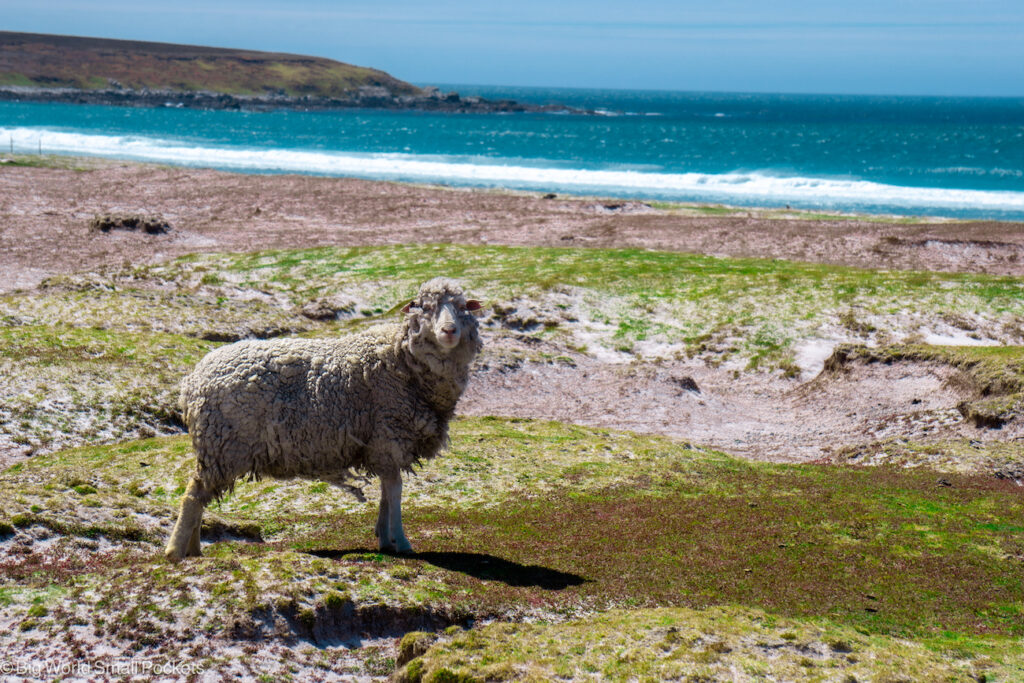
#8 Visas for the Falklands
As a British Overseas Territory, you do not need a visa to enter the Falklands if you do not need a visa to enter the UK.
Conversely, if you do need a visa for the UK, you’ll need one for the Falklands too.
Regardless of where you’re from, even if you’re a British national, stays in the Falkland Islands are capped at 30 days, unless you have a permit to stay, live or work there.
Everyone must therefore travel to the Falklands with a valid passport, that has at least 6 months of remaining validity and 1 blank page.
This is because you’ll receive a stamp when you enter and exit the Falklands (at the airport immigration point), which shows the amount of time spent there.
The best thing about this stamp is that it has a penguin on it!
#9 Flying to the Falklands
There’s 2 main routes you can use to fly to the Falklands.
An MOD route direct (ish) from the UK and a commercial route with LATAM via Chile.
There’s a lot of info to take in about these quite peculiar flight options, so I’ve written a huge post about flights to the Falklands you can check out for more info.
Otherwise, the key things to know are that you need book early, pay a lot and expect disruptions!
I might not be selling it, but trust me, the effort to get to the Falklands is MORE than worth it!
#10 Cruising / Sailing to the Falklands
The other way many people visit the Falklands is as part of a cruise or sailing boat – usually an epic voyage through Patagonia or on to South Georgia and Antarctica, if you’re looking to take in the Falklands as part of a longer voyage of discovery in the South Atlantic region, check out these fantastic options .
Arriving in the Falklands
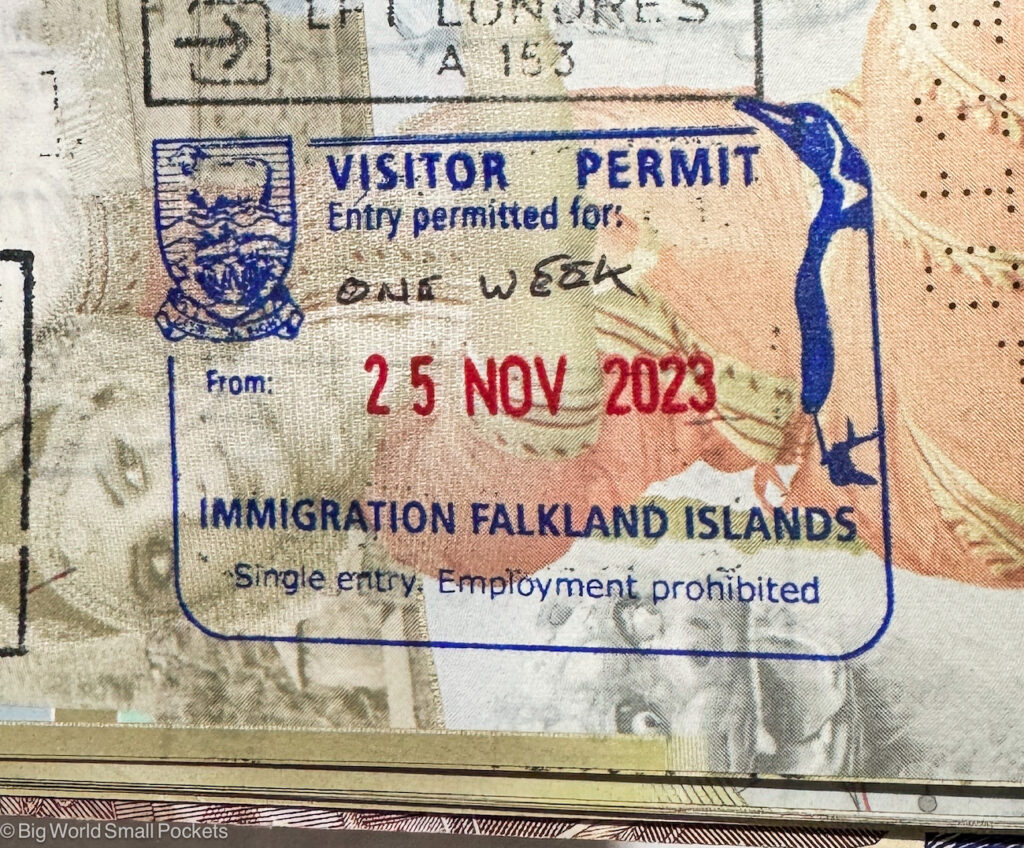
#11 Mount Pleasant Airport
If you’re arriving by plane to the Falklands, you’ll land at the International Airport, which is located in Mount Pleasant.
It operates as both a commercial and military airport, run by the UK Defence Force.
This makes it pretty unique!
In particular, you’ll see a heavy police presence here, you’ll also have to queue for a long time, as baggage facilities are pretty limited.
You’ll have to pass through immigration, get your stamp and fill in a form, as well as clear a bio-security check point.
All this can take a long time, so expect to spend at least 1-2 hours at Mount Pleasant Airport to clear all formalities after landing!
On the flip side, as you depart the islands, you’ll also have to get there around 4-5 hours before your flight for the reverse formalities, so don’t plan too much on your last day here!
You’ll also need to pay a departure tax when leaving the islands too.
#12 Getting to Stanley
It’s about a 90 minute drive from Mount Pleasant Airport (MPA) to the capital of Stanley.
As there’s only max 3 flights a week landing in the Falklands, it’s easy to group shuffle travellers between the 2 places.
After all, you should not expect taxis to be at the airport, or any public transport!
Instead, you’ll need to speak to your accommodation, either about getting a lift or, more likely, being booked on the coach that shuttles pretty much everyone from the airport and then drops them off at their registered accommodation in the capital.
This is the easiest and cheapest way to get to Stanley, although not the quickest because you have to wait for everyone to clear airport formalities before you depart!
#13 Bio Security
At the airport, you’ll pass bio security.
This will likely involve you having to stand in a tub of disinfectant and also have your luggage checked for any fresh produce or your boots and tents checked for mud, seeds etc.
This is to protect the unique ecosystem and wildlife of the Falkland Islands, particularly from Avian Flu.
There are also biosecurity points on each of the smaller islands when you fly to them.
Usually these are disinfectant tubs outside the lodges.
Make sure you use them and always scrub down your boots well too.
Getting Around the Falklands
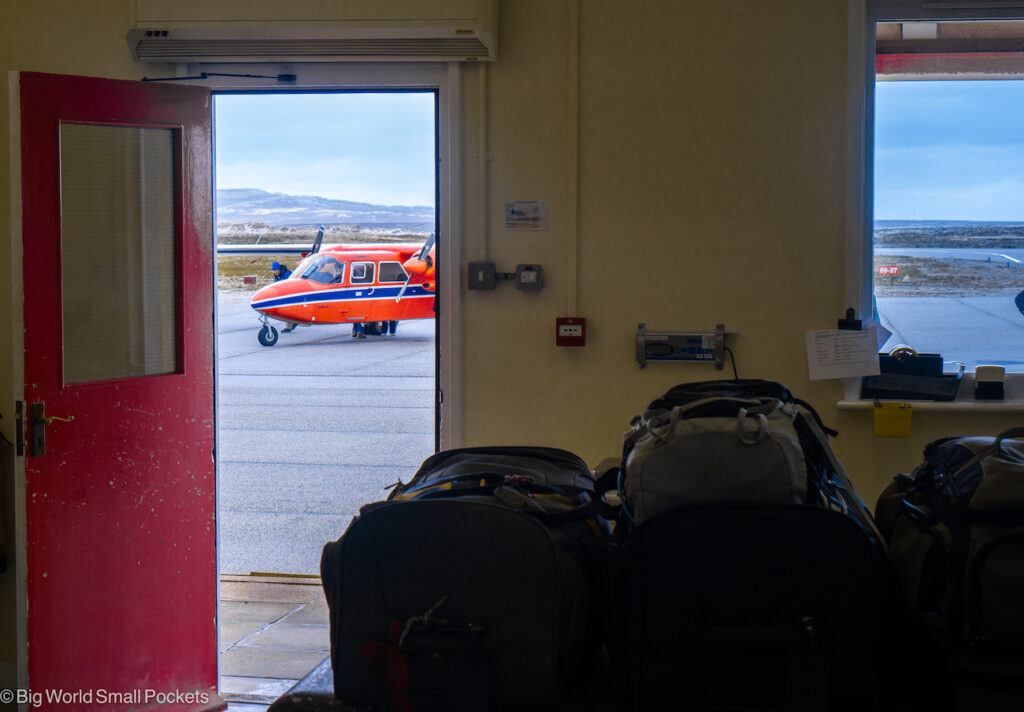
#14 Car Rental
It is possible to rent cars on the Falklands from a couple of small, local firms, such as Moody Enterprises Vehicle Hire.
These companies are based in Stanley, so you’ll have to travel there to collect the vehicle and compete the paperwork.
As a heads up, car rental is only really useful if you’re staying on East Falkland, as you can’t take vehicles to the smaller islands – you have to fly there.
You may be able to take your rental car to West Falkland, via the ferry from New Haven to Port Howard, as they do allow vehicles, but do check this with your hire firm first.
You’ll also need to check where you can drive with your rental car.
If it’s gravel roads only, you will be limited even in East and West Falkland!
If you need a taxi in the Falklands instead, contact Letty Taxis .
#15 Falklands Ferry
As I mentioned above, there is a ferry service that runs between the 2 main islands of East and West Falkland.
Cheaper than flying between the 2 islands, the ferry runs a few times a week and takes around 90 – 120 mins.
The service is operated by Workboat Services Ltd, who use the MV Concordia for the journey.
Both foot passengers and vehicles need to book in advance .
The ferry is a great option for those wanting to explore the Goose Green and Darwin, as well as Port Howard areas of the 2 islands – but do remember it can take several hours to drive from there to other spots on both East and West Falkland such as Stanley or Hill Cove.
If you’re looking to get around efficiently and see as much as possible, flying is the better option.
#16 Using FIGAS
Which leads me on nicely to talking about FIGAS.
Standing for the Falkland Islands Government Air Service , this incredible network transports passengers and freight around the islands every day from dawn until dusk.
With landing strips in most settlements across the Falklands (i.e. where people live), you can use this service to get almost anywhere.
You just have to book and pay in advance for a certain route on a certain day and then wait to hear your flight time the day before.
This info is available on the radio on via the FIGAS Facebook page .
It’s quite an amazing system and you can learn all about my experience of it, as well as how to book and sort flights yourself in this article I wrote.
#17 Taking Tours
You can also use tours to get around the islands and explore more deeply.
Particularly helpful if you’re journeying around the Falklands independently, tours as a great way to visit places with locals and learn more about their life, the islands and the flora and fauna.
Tours also allow you to get places that some pretty heavy duty 4WD skills are required!
Tours are available on most of the smaller islands (especially Pebble and at Hill Cove), as well as on the main islands of East and West Falkland.
If you want to see some of the great wildlife spots around Stanley – like Volunteer Point or Kidney Island – or you want to learn more about the history of 1982 conflict here and visit some of the memorial sites, tours are a great idea.
Check out these recommended tour guides .
#18 Access Permit on the Falklands
Guides are also useful when exploring the Falklands because they tend to secure access permits for you.
And permit access is required for just about anywhere is the Falklands, as pretty much the whole archipelago is privately owned.
This means to visit places without tours, especially on the main islands, if you want to go hiking, war memorial finding, penguin spotting or anything else, you’ll need a permit from the land owner.
Don’t just expect to rock up on the day and be granted one either (or even find anyone to talk to!) – this all needs to be arranged well in advance.
Landowners need to be called and paid.
You can find their details through the Tourism Office, but just a heads up, this all takes time!
The only place you don’t need permits are the self-guided trails around Stanley, as these are on government-owned land.
Details of the trails can be found on leaflets available from the Tourism Office by the jetty in Stanley.
Staying & Eating in the Falklands
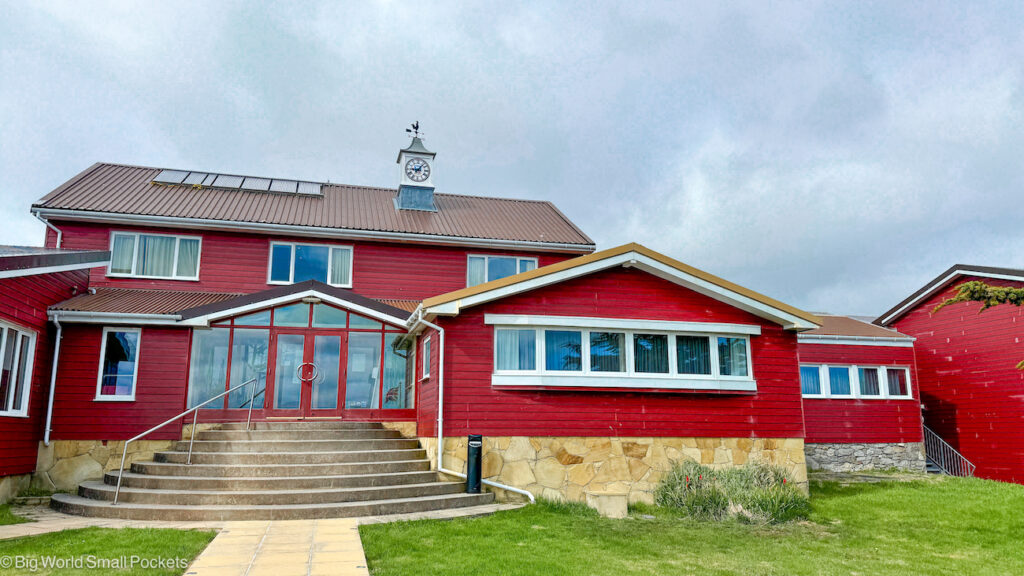
#19 Falklands Accommodation
There’s 2 main types of accommodation across the Falkland Islands:
- purpose built hotel and lodges
- farmhouses or homes that have been converted into guesthouses or self-catering spots
Across most of the more popular small islands, such as Pebble Island and Sea Lion Island , lodges are available and offer fantastic homely accommodation that is specifically designed for tourists.
They generally include 3 meals a day, transfer from the landing strip, free tea and coffee daily, afternoon cake, as well as maps and info about the island.
Many also offer tours to guests to see the wildlife etc.
In Stanley, there’s a couple of purpose built hotels, namely the Malvina House Hotel and the Waterfront Boutique Hotel .
The other type of accommodation on the Falklands are conversions.
Tu Guesthouse in Stanley is a great example of this, where locals have turned their home into an accommodation provision.
Elsewhere there are self-catering spots at Hill Cove, Darwin & Goose Green, Fox Bay, Saunders Island and Weddell Island.
Hill Cove also boasts the Falkland’s first glamping cabin – Boxwood Pod.
You can read about my time there .
Most of the food in the Falklands (outside of lamb, some dairy and few vegetables) has to be shipped in.
This means it can be very pricey and choices can be limited.
To be fair, I think it’s an ok price to pay if you want to travel this remotely!
There’s 2 supermarkets in Stanley where you’ll need to stock up for self-catering.
I wouldn’t count on any other stores anywhere else across the archipelago!
There’s also a few good restaurants and cafes in Stanley – I tried Groovy’s and the Teaberry Café. Both did the job.
The best restaurant in town is thought to be either at the Malvina House Hotel or at the Waterfront Boutique Hotel.
On the smaller islands, the lodges will provide you with 3 meals a day usually, which is the easiest option!
I’m a vegetarian and I more than survived on the islands.
Just don’t come expecting gourmet food!
#21 Drinking
In Stanley there’s a number of good pubs – from classic English pub, The Victory, through to the fancy new wine bar Unwined and the craft brewery Beerworks.
There’s also a local gin distillery located by the Tourism Office.
Both the distillery and Beerworks are well worth checking out to sample the local tipples and to tipple with the locals!
Alcohol is very cheap in the Falklands, as there’s no alcohol tax, but if you want to get up early for all those wildlife sunrise shots, it’s best not to overindulge!
Most of the island lodges have honesty bars, so you can enjoy a glass of wine with dinner here.
Alcohol isn’t included in the lodge rates and can be paid on departure using cash or card.
PIN IT TO PINTEREST!
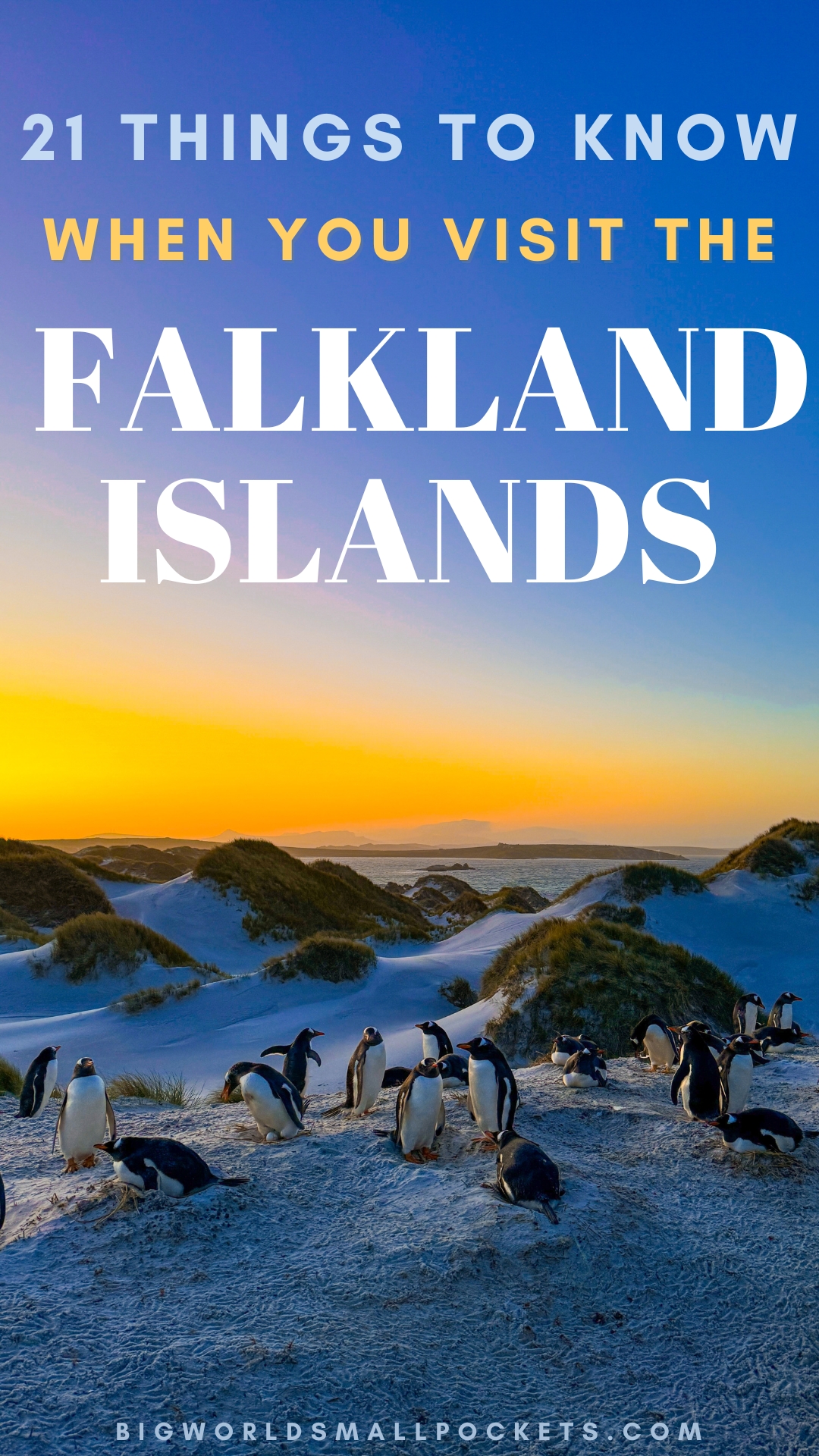
So there you have it, my full guide to the 21 things you need to know before you visit the Falkland Islands.
I hope the info was helpful and I’ve convinced you to head to this stunning spot!
Still have questions about travelling here?
Don’t hesitate to drop them into the comments box below and I’ll get back to you…
My trip to the Falkland Islands was kindly sponsored by Falkland Island tourism but, as always, all views are my own.
This page contains affiliate links meaning Big World Small Pockets may receive a small commission on any purchases at no extra cost to you.
Creator of Big World Small Pockets, Stephanie Parker is a travel addict! Originally from Jersey in the Channel Islands, Stephanie adventures the world collecting tips, advice and stories, to share with a smile
Leave a Reply Cancel reply
Your email address will not be published. Required fields are marked *
This site uses Akismet to reduce spam. Learn how your comment data is processed .
Visiting the Falkland Islands
Accommodation.
In common with other countries, before entering the Falkland Islands, all visitors are required to provide the Customs & Immigration team with details on where they will stay for the duration of their time here.
The Falkland Islands Tourist Board has a range of accommodation options available on their website, from cosy cottages in the countryside, to lodges on the Outer Islands or five-star hotels in Stanley.
Wherever you stay, you will be assured of a warm welcome and will quickly discover why Falkland Islanders are renowned for their generosity and hospitality. For more information, please visit the Falkland Islands Tourist Board website: www.falklandislands.com/accommodation
Getting here
There are a range of ways to reach the Falkland Islands, although due to the ongoing pandemic, visitors should check with their travel operator as some of the usual routes are not currently in operation.
Information on how to travel to the Falkland Islands is available on the Falkland Islands Tourist Board website: www.falklandislands.com/getting-here
All visitors require a passport that is valid for the length of their stay and land-based travellers should also have travel insurance (inclusive of medical evacuation), a return ticket, evidence of accommodation and sufficient personal funds for their time here.
Departure tax must be paid at the airport when leaving the country. This costs £26 and can be paid in cash (FKP, GBP, EUR or USD) or via Visa or Mastercard debit cards.
Not all nationals require visas to enter the Falkland Islands, but please check the Customs & Immigration page for more information.
For any other questions about entering the Falkland Islands, please:
- Visit the Customs & Immigration website: www.fig.gov.fk/customs
- Call Customs & Immigration on +500 27340
Key facts about the Falklands
The Falkland Islands are a place unlike any other, which is why we thought it might be helpful to provide a list of key facts to bear in mind when visiting our beautiful home.
If there are any questions that you have about visiting the Falkland Islands which you cannot find on this page or elsewhere on the website, please contact the Communications and Media Office .
Please note: the Falkland Islands Government is not responsible for the content of external links.
Our Countryside Code exists to protect our environment, including our wildlife, so please ensure that you follow it when visiting the Islands, as failure to do so may constitute an offence and could result in a fine
You may have heard the term ‘Malvinas’ used to describe the ‘Falkland Islands’ – some people incorrectly believe that this is the Spanish or Portuguese translation, however it is a word that Argentina uses to assert their sovereignty claim over our home and therefore using it is considered highly offensive here; in Spanish please use Islas Falkland and in Portuguese Ilhas Falkland
Broadband in the Falklands can be very slow at times and you will generally not be able to access the internet on your phone unless you have a local mobile contract or connect to a WiFi hotspot .
WiFi hotspots exist in many locations across the Islands but are not free to use – you will need to purchase a local Wi-Fi ‘scratch card’ to access the service
‘Camp’ is the term used in the Falkland Islands to refer to any area outside of Stanley and is derived from the Spanish word ‘campo’ for ‘countryside’
Most areas within Camp do not have tarmacked roads, so if you choose to travel by vehicle you will be driving on tracks or off-road; alternatively, you may choose to fly around the Islands – see the ‘Travel’ section for more information
Weather conditions can change quickly in the Islands and it is not unusual for us to experience ‘four seasons in one day’ – so please pack layers of clothing in your luggage to allow for this, including the all-important waterproof jacket
For footwear, you will need strong boots if you want to walk outside of Stanley
Also don’t forget your face – sunscreen is essential as it is very easy to burn here
If you plan on bringing a drone with you, you will first need permission from the Civil Aviation Authority and must pay a fee of £50 – failure to do either of these is an offence here and could result in a fine
Also, as much of the land in the Falkland Islands is privately owned, if you wish to use a drone over private land then you will need permission from the landowner
Our electricity supply is 240v, 50hz and our sockets take a standard UK three-pin plug, so don’t forget to bring an adaptor if your appliances are not compatible
The Falkland Islands has a police force , and a fire and rescue service , both of which can be contacted by calling 999
The King Edward VII Memorial Hospital (KEMH) also operates an Accident and Emergency department which is open between 8:30am and 4:30pm from Monday to Friday. Outside of these hours the casualty nurse is on-call for emergencies or ambulance call outs, and can be contacted via 28052.
Our healthcare facilities are based at the King Edward VII Memorial Hospital (KEMH) in Stanley where medical staff are qualified to UK standards and include a full surgical team and intensive care unit
Camp settlements and farms are equipped with medicine chests to take care of minor injuries
Visitors who are not UK residents are required to pay for any medical services received in the Islands and travel insurance (inclusive of medical evacuation) is needed to visit and to stay in the Islands
Over-the-counter medicines can be easily purchased in local supermarkets, but if you take prescribed medicine it is highly recommended that you bring sufficient supplies for your stay
The Falkland Islands have been officially ‘mine free’ since November 2020, however there is still the outside possibility that you may come across an unexploded device, for example if one has been brought in from the sea
If you come across a suspicious device that may be a landmine or other explosive device then please contact the Royal Falkland Islands Police on 999, providing the position if possible or using the What3Words mobile app for your specific location
It’s important to remember that no civilians have ever been injured or killed by a landmine in the Falkland Islands, so the chance of that happening is very remote
The official language of the Falkland Islands is English, but many nationalities are present in the Islands and so you will also hear people speaking Spanish, Filipino and Shona (a Bantu language from Zimbabwe)
If you have a contract phone, you may be able to use the local Sure mobile network with your own SIM, but first check their website for the list of their roaming partners
A pay-as-you-go service is a cheaper option if you are visiting for more than a day, but you will need a SIM-free unlocked mobile handset to use this service
Mobile coverage varies, but is generally good in Stanley and patchier Island-wide; Stanley has three public phone boxes which can be used with pre-paid local phone cards
The Falkland Islands has one cash point located at the Stanley Services refuelling station on Bypass Road, it is only available during usual business hours
We also only have one bank, Standard Chartered Bank, which is located on Ross Road opposite the police station, which is open on weekdays from 9am-3pm
At the bank you can change money, transfer funds and issue cash advances against Visa and Mastercard – charges apply and photographic identification is essential
Some local shops can provide you with cashback if you pay by card – the fee for this service is £3 in The West Store and Chandlery, but currently free in Kelper stores
Local currency has the same value as UK sterling and both are used freely and interchangeably in the Islands
US dollars and Euros can be used in some places, however Argentine pesos cannot; similarly, some credit and debit cards can be used at certain locations – it’s a good idea to check with the server at the till before you pay and carry cash where possible
The Falkland Islands has one post office which is located within the main Town Hall building on Ross Road, it is open from 9am to 5pm, Monday to Friday and more information on their services are available on the postal services webpage
One of the ways people get around the Falkland Islands is via the local air service, which is called FIGAS (Falkland Islands Government Air Service)
FIGAS operates a fleet of Britten-Norman Islander aircraft, which are small two propeller planes – you will need to sit where the pilot tells you for weight distribution and please be aware that you may share your flight with livestock!
Your flight time will not be confirmed until the day before your flight, as the schedule is arranged according to passenger and freight demand on any one day, this means it may be an early start but you will know the timings the night before
There is also an inter-Island ferry service provided by Workboat Services and more information on their schedule can be found on by visiting www.workboat.co.fk
Alternatively, you can travel around the Falkland Islands by vehicle and there are a range of local businesses that provide car rentals, including four-wheel drive
Please visit the Falkland Islands Tourist Board website for more information on getting around the Falkland Islands: www.falklandislands.com/visitor-information/getting-around/figas-car-hire-ferry
- Privacy Policy
Copyright © Falkland Islands Government. All rights reserved.
- Search Please fill out this field.
- Manage Your Subscription
- Give a Gift Subscription
- Sweepstakes
- Island Vacations
A Guide to Vacationing on the Falkland Islands
Get ready for penguins.
:max_bytes(150000):strip_icc():format(webp)/alex-schechter-author-pic-651b0cd898b347eeb531e559498d9b83.jpg)
Just a few decades ago, the Falkland Islands were embroiled in a bitter war when Argentina invaded the U.K.'s territory. The conflict, which eventually restored the islands back to British control, lasted for 10 weeks and inspired films, documentaries, and television shows.
Today, this archipelago of more than 750 islands and islets is a tourist destination for bird watchers, wildlife seekers, and anyone hoping for a taste of the “deep south” in this gateway to Antarctica.
A nature lover’s paradise, the Falklands show signs of life everywhere you look: from crags dotted with seabirds, to beaches swarming with penguins (the Falklands are home to five different species), to vast watery depths where whales, walruses and seals compete for space off-shore. There’s even an entire island named for sea lions .
Located deep in the Southern hemisphere, summer here falls from November through February, and this is the best time to visit, as you’ll enjoy warmer weather and a better chance at spotting wildlife. If animals are a big factor in your decision to come here, check out this handy Wildlife Calendar , which offers an overview of what happens when. (For example, while October is when Gentoo and Magellanic penguins lay their eggs, in December you’ll be able to witness those eggs hatch. Later, in March the penguin chicks “fledge,” or shed the remainder of their soft baby feathers.)
What to Bring
Keep in mind these islands are remote: Don’t expect the same amenities you’d find in a big town or city. There are no ATMs in the Falklands, according to the tourism board , so travelers need to carry British pounds or U.S. dollars with them to cover incidentals.
Pack water-resistant clothing, warm layers, and sturdy walking shoes, as there is plenty of exploring to do on foot. However, don’t let the Falkland Islands' polar location fool you: While it’s geographically within the Antarctic zone, temperatures are milder than what you’d expect. The weather here is similar to the U.K., but with less rain.
What to See
“The density of wildlife on the Falkland Islands is like nowhere else on Earth,” said Wendy Smith, head of polar adventures at boutique tour operator Intrepid Travel .
Not only does the archipelago boast five different penguin breeds , but penguins actually outnumber people here by the hundreds of thousands. To see them, head three hours north of Stanley to Volunteer Point . Home to the largest colony of King penguins in the Falkland Islands, this peninsula has a gorgeous white sand beach stretching for two miles—it’s here where you’ll spot several hundred penguins, tottering in groups of ten or twenty along the smooth shoreline.
This is a popular cruise stop, so be sure to ask your tour guide to time your visit before (or after) the mob descends.
Where to Stay
The 22,000-acre estate of Pebble Island Lodge is probably as close as you’ll ever come to sleeping on your own private island. With a prime location in the center of Pebble Island, the hotel goes out of its way to help guests explore. Guided tours are offered on a regular basis, in 4-wheel drive vehicles (necessary for traversing the crude, hilly landscape and getting onto the sandy beaches). Bird watchers, in particular, love it here, with plentiful sightings of Peregrine Falcons, Night Herons, native Rocky penguins (known for their goofy-looking mohawks), and more. The lodge itself is in a large 1928 white brick farmhouse, cozily furnished, which sleeps 11 people, in six rooms, all en suite.
What to Know
Stanley is the capital of the Falkland Islands, a well-weathered port town that’s home to about 2,100 inhabitants (which is most of the Islands' population). Settled in the 1840s, it was once an important stop for English explorers and whalers, hence the striking whalebone arch — constructed from the jawbones of two blue whales — that marks the entrance to Christ Church Cathedral .
Step into the past at the Historic Dockyard Museum , a former 19th-century storehouse, smithy, and telephone exchange building that now tell the full story of the Falklands, with old maritime relics (many ships were stranded here during early attempts at exploring the Antarctic), exhibits about the 1982 war, taxidermied animals, and tools from the farmers, blacksmiths, and carpenters, and of course fishermen who once lived here. (Need something a little more light-hearted? Stop by Kay’s , a whimsical B&B whose gnome garden has become an attraction all to itself.)
At roughly 400 miles off Argentina’s southern coast, the only way to get to the Falkland Islands is by plane. LATAM flies once a week (on Saturdays) from Santiago, Chile into Mount Pleasant Airport on East Falkland. Although this is actually a military facility, it also doubles as an international commercial airport.
From the airport, it’s about an hour’s drive to Stanley, the capital of the Falklands. Once you’ve arrived at the archipelago, the easiest way to get around is in a 4-wheel drive vehicle (usually accompanied by a tour guide), or via FIGAS , the island’s government-operated air service. Fares start at £55, or about US$69.
Falkland Islands

- 1 Settlements
- 3.1 History
- 3.2 Economy
- 3.3 Flora and fauna
- 3.4 Terrain
- 3.5 Climate
- 3.6 Holidays
- 3.7 Tourist information
- 5.1 Visa requirements
- 5.2 By plane
- 5.3 By ship
- 6.1 By plane
- 6.2 By boat
- 6.3 By taxi
- 6.4 By Land Rover
- 14 Stay safe
- 15 Stay healthy
The Falkland Islands consist of two main islands and several hundred smaller islands in the south Atlantic Ocean , off the east coast of southern South America . They are a British Overseas Territory, but nearby Argentina claims jurisdiction under the name Islas Malvinas . Most visitors to the islands come between October and March (Southern Hemisphere summer) to enjoy the spectacular wildlife and hardy rural lifestyle.
Settlements [ edit ]
"Town" is a relative term in the Falklands. While the population of Stanley hovers near 2,000, the populations of other settlements usually range from the single digits to perhaps 20 people with a noticeable increase during the busy sheep shearing times. In comparison, the average medium-sized village in the United Kingdom has a population of around 3,000 and this is nearly the total population of the entire Falkland Islands.
- -51.694444 -57.852778 1 Stanley – the capital and port, and the only town in any normal sense of the word. Highlights include the cathedral and its whale bone arch, a history museum, the governor's residence and the penguins at nearby Volunteer Point.
- -51.828833 -58.969167 2 Goose Green – a small settlement with numerous remnants of the 1982 war on East Falkland; this was the site of an eponymous battle in that conflict. Although accommodation is limited, it serves as a better base for exploring the southern region of Lafonia than Stanley.
- -51.617 -59.5 3 Port Howard – a 200,000-acre (800 km²) sheep farm on West Falkland: the only way to access from Stanley is by air, landing in a nearby field, or the ferry service twice a day from East Falkland. Port Howard is an extremely tranquil part of the world, with far-reaching views and great hiking opportunities.
- -52.1256 -59.3679 4 North Arm – largest settlement in Lafonia and residential centre of North Arm Farm.
Islands [ edit ]
Life in the Falklands can be divided between living in Stanley or living in camp , i.e. anywhere outside the capital. The two main islands of the territory are East Falkland and West Falkland, with numerous smaller islands providing additional destinations.

Understand [ edit ]
The Falklands are a UK Overseas Territory. The archipelago is roughly the size of Wales or, in North American terms, Connecticut , but extremely sparsely populated; penguins outnumber humans by a hundred to one. The islands are also claimed by Argentina as the Islas Malvinas and were the site of a major conflict between the two countries in 1982.
History [ edit ]
Although first sighted by an English navigator in 1592, the first recorded landing took nearly a century more by an Englishman in 1690. The French established a settlement later still in 1764 that was later given to Spain. The French called the islands les îles Malouines , after the port of Saint-Malo in Brittany, from where the Falklands' first settlers originated. It is from this that the Spanish name, Malvinas , is derived.
A British settlement followed shortly in 1766 and the islands became the subject of ongoing territorial disputes between Britain and Spain, which subsequently became a dispute between Britain and Argentina. Although the islands have a complex history of settlement and abandonment by various nations, it is generally accepted that since 1833 the islands have been under British control. During most of the 19th century who did or should govern the islands was a non-issue in Argentinian and international politics, and there are even some semi-official maps from that era that show the islands as British. However beginning in the 20th century, nationalist voices in Argentina demanded the islands to be "given back" to Argentina based on the tenuous Spanish claim, that Argentina claimed to have "inherited" and an even shakier claim of Argentinian administration and settlement of the islands prior to 1833, that was violently ejected according to those Argentinian claims.
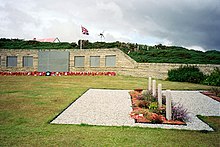
Open conflict between Britain and Argentina began on 2 April 1982 when Argentina's military junta ordered the invasion of the islands. The British responded with an expeditionary force that landed seven weeks later. After fierce fighting in what is often known as the Falklands War, the Argentine occupation force was forced to surrender on 14 June 1982. Nonetheless, today Buenos Aires still refuses to give up Argentina's claim to the territory, and continues to push for a peaceful transfer of sovereignty, though most Falkland Islanders consider themselves to be British with no interest in joining Argentina. There was a referendum held on the question in 2013, in which 99.8 % voted to remain a British territory.
Economy [ edit ]
The economy of the Falklands used to be based on agriculture (mainly sheep farming) but today fishing contributes the bulk of economic activity. Income from licensing foreign trawlers totals more than US$40 million per year with squid accounting for 75% of the fish taken. Agricultural activities mainly support domestic consumption with the exception of high grade wool which is exported. Surveys have revealed oil deposits within a 200 mile oil exploration zone around the islands and exploratory drilling is under way. The British military presence provides a sizeable economic boost.
Tourism is being actively encouraged and increasing rapidly with about 66,000 visitors in 2009; a large part of the increase is from visiting cruise liners. The majority of visitors are from the UK but efforts are being made to encourage wildlife and adventure tourism. The main season is November to March but angling for sea trout is most favourable outside of this period.
Flora and fauna [ edit ]
The most popular reason to visit is for the scenic beauty and the flora and fauna. Conservation is high on the islands' agenda. Bird and marine species are the most prevalent fauna and include five species of penguin, four species of seal, albatross, petrels, the Falkland flightless steamer duck ( logger duck ), other duck species, geese, hawks and falcons. The striated caracara ( johnny rook ) is a rare bird of prey found only on the Falkland Islands and some islands off Cape Horn . Porpoises and dolphins are often sighted with the occasional sighting of whales .
Terrain [ edit ]

The terrain is rocky and hilly, with some boggy terrain. Peat is found throughout the islands, leading to potentially dangerous fire conditions; once ignited, a peat fire can burn for months. The deeply indented coast provides good natural harbours. The highest point in the islands is the 705 m Mount Usbourne.
Climate [ edit ]
Strong westerly winds are a constant in many parts of the islands. It is more likely to rain in the southeastern part of the islands with the far western islands getting very little yearly precipitation. Temperatures are cool and snow may occur at any time except for January and February, although accumulation is rare. Most visitors come to the islands between November and March.
The Falklands is a victim of the Antarctic ozone hole, so it is important to wear sunscreen on sunny days during the early summer.
Holidays [ edit ]
- HM the Queen's Birthday, 21 April
- Liberation Day, 14 June (1982)
- Battle Day, 8 December
Tourist information [ edit ]
- Falkland Islands Falkland Islands Tourism . Jetty Visitor Centre, Stanley, ☏ +500 22215 , fax: +500 22619, [email protected]
Talk [ edit ]

Falkland Islanders speak English . Some native islanders have a peculiar accent, which can sound like a mixture of Westcountry English with something more New Worldy or Southern Hemispheric: Australian, Kiwi or South African. However, a large number of islanders grew up in Great Britain, and have kept their accents. Falklands English is mostly the same as British English , but there are a handful of words unique to the islands. For instance, camp refers to anywhere in the islands outside Stanley; the word derives from the Spanish campo , meaning countryside . Kelpers are the islanders themselves, and the term refers to the seaweed; this nickname whilst traditionally not a pejorative, has been used disparagingly by Argentinians and so it is advisable to avoid its use. Benny is a pejorative nickname for Falkland Islanders coined by British soldiers, to avoid giving offence it should be not used by visitors.
Knowledge of Spanish as a foreign language is fairly widespread, as it is a compulsory subject in school, being the lingua franca in much of continental South America. As the schools follow the English education system, European Spanish as prescribed by the Real Academia Española in Madrid is taught, rather than a South American variety of the language, but Falkland Islanders may use seseo pronunciation typical of South American dialect. There is a small population of Hispanophones in the islands, consisting mostly of Chileans, and the language is also present in some placenames. Falklands English borrowed some Spanish words.
Get in [ edit ]

Visa requirements [ edit ]
With the exception of those arriving by cruise ship who will not be spending a night on land, all visitors to the Falklands must show that they have a return ticket, accommodation and sufficient funds to cover their expenses while in the islands. A major credit card will be accepted as proof of funds. A departure tax of £22 is charged when leaving the territory from Mount Pleasant airport.
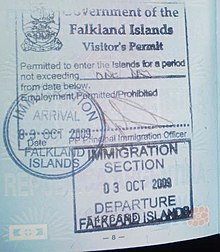
A visa is required except in the following cases:
- Visitors arriving on board a cruise ship and do not spend a night in the islands.
- Visitors who hold a passport from the following countries: Andorra , Argentina , Australia , Austria , Belgium , Bulgaria , Brazil , Canada , Chile , Cyprus , Czech Republic , Denmark , Estonia , Finland , France , Germany , Greece , Hong Kong , Hungary , Iceland , Ireland , Israel , Italy , Japan , Latvia , Liechtenstein , Lithuania , Luxembourg , Malta , Netherlands , New Zealand , Norway , Paraguay , Poland , Portugal , Romania , San Marino , Slovakia , South Africa , South Korea , Spain , Sweden , Switzerland , Taiwan , United Kingdom , United States , Uruguay , Vatican City .
- Visitors who have a passport or international travel document issued by the Red Cross or United Nations.
Visas can be obtained from a British embassy or consulate , or, if you are in the UK, the Falkland Islands Customs and Immigration Department, ☏ +500 27340 .
By plane [ edit ]
There is also an airport in -51.685672 -57.777644 2 Stanley Airport ( PSY IATA ) but it has a smaller runway and is used primarily for flights within the Falklands.
It is expensive to get off the islands and a return flight to Santiago (the nearest airport interchange hub) costs approximately £800 per person and is a 7-hour flight. It costs £1,600 for a return ticket to the UK if you are eligible for discount (you need to be a Falkland Islands Government employee) otherwise it costs £2,100. Veterans of the 1982 conflict and widows of those killed can get a very generous discount on RAF flights, with tickets costing as little as £150, however, such passengers have the lowest priority on place allocations; serving military personnel, islanders and fully paying customers (in that order) have higher priority on seat allocation, which is often only definitive on the day of departure. The RAF contracts two flights per week which are subject to military priorities. For tickets, you should call the Falklands Island Government Office in London at ☏ +44 20 7222-2542 .
The Mount Pleasant airport is 56 km (35 miles) from Stanley. Falkland Island Tours & Travel ( ☏ +500 21775 , [email protected] ) operates a shuttle bus that meets all flights and that can take visitors to and from the capital for £15 per person (one-way). Taxis also take passengers to and from the airport, and these must be booked in advance.
By ship [ edit ]
Large cruise ships stop at Stanley 's port throughout the island's summer months (October - April). These boats may also stop at some of the outlying islands. While cruise ships can dock at Stanley you should be prepared to come ashore on a zodiac (also called a rigid inflatable boat, or RIB) when landing on most other islands. It is also typical for expedition ships en route to Antarctica to include a stop at the Falkland Islands in their itinerary.
Get around [ edit ]

Travelling between islands in the Falklands is generally done using the Falkland Islands Government Aviation Service (FIGAS) . The planes are Britten Norman Islander aircraft, capable of carrying eight passengers plus pilot. Passenger load may be reduced depending on the condition of the airstrips being visited. With the exception of Stanley and Mount Pleasant, all airstrips in the Falklands are either dirt strips or grassy fields. Be prepared for slight delays while livestock is cleared from airstrips prior to takeoff or landing!
FIGAS flights leave twice daily from the airstrip just outside of Stanley and travel to a variety of locations throughout the islands. There is a baggage limit of 20 kg per person which is strictly enforced; you and your baggage will be weighed prior to boarding in Stanley. There is an additional charge of £1.40 per kg, space permitting. Unless the plane is flying to an island with a very poor landing strip there are almost never weight constraints that would prevent travelling with a few extra kilos of baggage.
Reservations are required for travel and should be booked at least 24 hours in advance. Booking reservations can be done either by calling the airport ( ☏ +500 27219 ), emailing [email protected] or visiting the airport in person when it is open (hours vary depending on flight schedules but mid-morning is usually a good time). Flight schedules, including the names of passengers booked on each flight, are announced the night before departure on Falklands Radio, and are also available via a fax service. Most lodges will post the schedule as soon as it is announced.
Flights can be paid for in cash or with credit card. Fares vary by destination but sample fares (one-way) from November 2009 were:
- Stanley to Sea Lion Island: £59.46
- Stanley to Port Howard: £58.75
- Saunders Island to Pebble Island: £25.38
- Pebble Island to Stanley: £64.43
By boat [ edit ]
While it is possible to get around the Falklands by boat, as of March 2010 there was no regular service available to tourists travelling in small groups to the outer islands; (contrary to reports in guide books, the Golden Fleece does not taxi passengers around the islands). For large groups it may be possible to charter a boat in advance thus providing a great way to visit some of the less-travelled islands. Per-passenger landing fees are charged on many of the islands; contact the island's owner before visiting.
However there is a regular passenger ferry between New Haven, 2 hours car journey from Stanley to Port Howard . Ferry tickets must be booked in advance from Workboat Services on 22300. As of December 2008 example prices were: foot passage single £10; car passage single £25.
Large cruise ships are the most common means for people to visit the Falklands, and most will make several landings at various islands. Note that aside from Stanley all landings from cruise ships are done using zodiacs (small inflatable boats), and in many cases the lack of docking areas will require a quick wade from the zodiac onto shore.
By taxi [ edit ]
Within Stanley there are two taxi services that can be hired for travel throughout the town and surrounding areas, including the Mount Pleasant airport.
By Land Rover [ edit ]
Land Rover rental may be possible from Stanley. Contact either the Falkland Islands Company or Stanley Services ( [email protected] ) for information. Roads in Stanley are paved, but elsewhere road conditions range from well-maintained dirt roads to boggy mud streams. Unless your travels specifically require having your own vehicle, renting a Land Rover is neither necessary nor a particularly good idea.
See [ edit ]
- Museum - on Holdfast Road.
- Watch the nature, specially the species of penguins living there.
Do [ edit ]
- Fishing . The fishing season runs from September to April, and it is a good chance for fishing enthusiasts to catch sea trouts and mullets.
Buy [ edit ]
Money [ edit ].
The official Falklands currency is the Falkland Islands pound (FKP) whose value is set equivalent to that of one British pound (GBP).
Banknotes of the Falkland Islands are issued in denominations of £5, 10, 20 and 50. Coins of the Falkland Islands are issued in denominations of 1, 2, 5, 10, 20 and 50 pence, 1 (12-sided, yellow ring with silver center) and 2 pounds.
Money can be exchanged at the only bank in the islands which is located in Stanley across from the FIC West store. The bank doesn't have an ATM, but there is one in Stanley Services on the bypass (the only one on the islands as of 2021). British pounds will generally be accepted anywhere in the islands. Within Stanley, credit cards, euros and U.S. dollars are also often accepted. On the outlying islands credit cards will probably not be accepted, although euros and U.S. dollars may be taken; check with the owners in advance to determine what is an acceptable payment method.
It is nearly impossible to exchange Falklands currency outside of the islands, so exchange money prior to leaving the islands.
Eat [ edit ]

Meals in the Falklands are primarily traditional British. Fish and chips, roast beef, mutton and tea are standard fare. There are some Spanish influences such as Milanesa and Casuela. While in camp many of the lodges provide home-cooked meals in very generous portions and their food is generally better than is found in Stanley's pubs and cafés. However, Stanley does have a few good restaurants.
It is difficult to find fresh fruit and vegetables, and they are generally very expensive. A banana will cost £1 and a small orange or one single plum will cost 90p. Cabbage and cauliflower costs around £4.50 for half a portion. Half a portion of lettuce costs around £3.50 and a small cucumber costs £4. Tomatoes for some reason are very expensive, for example 2 small tomatoes cost around £2.50. There is no fresh milk available and all milk is UHT/long life milk. The only fresh meat on sale in the supermarket is mutton. A frozen chicken costs around £12 for a 2-kg bird.
Local specialities include diddle-dee jam, made from red crowberry or diddle-dee (empetrum rubrum), which grow wild on the heaths. If you can stomach the bizarre, translucent appearance, boiled penguin eggs are a delicacy available in the fancier hotels.
Drink [ edit ]
While most items in the Falklands are expensive due to the cost of importing, there are no taxes on alcohol making beer prices fairly reasonable. Pubs and lodges offer a wide selection, although most drinks will usually come from a can or bottle rather than a tap. There are also a few local microbreweries that provide local drinks inspired by the surrounding areas. These can be bought in gift shops, and some are available on tap in various bars around Stanley.
Sleep [ edit ]
Accommodation in Stanley includes numerous bed and breakfasts as well as a handful of hotels. Buildings are generally older and the warm hospitality also seems to come from a bygone age. While in camp lodging includes everything from old farmhouses to lodges built specifically for tourism. Camping may be permitted with permission of the landowner. Many places are self-catering meaning supplies will need to be purchased in either Stanley or from a local source, if one is available. When in camp it is essential that lodging be reserved in advance; in Stanley it is generally possible to find lodging without a reservation but it is still recommended that reservations be made.
Work [ edit ]
A work permit is required for any foreign national, including UK citizens, working in the Falklands. Work permits must be applied for prior to coming to the islands and will require an employer's sponsorship. Medical information is also required for the government to approve you work permit.
Like everything in the Falklands, living expenses will be very high. Kerosene (the only form of heating available to most housing here) costs £200 to £300 or more per month to heat a small 3-bedroom house. The internet is very expensive and it costs around £80 per month for a limited data package of 38GB per month. Overall the cost of living is at least 2 times higher than the UK. However this is counterbalanced by the low cost of fuels and meat and the low taxes.
Stay safe [ edit ]
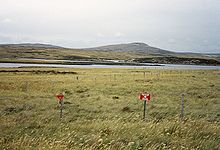
Crime is relatively unknown in the Falklands, although one should still take the normal precautions of not leaving items unattended or travelling alone late at night. If problems are encountered the police force should be helpful. Dial 999 in an emergency situation.
Many animals in the islands can be dangerous when cornered or with young. Elephant seals, sea lions and fur seals are probably the most dangerous; keep a safe distance when viewing these animals. A general rule is that if the animal seems to notice your presence, you are too close. In the long pampas grass on beaches or dunes, it is entirely possible to come across even huge animals without noticing them until you're practically tripping over their bodies, so do take care! Nesting birds, particularly terns and skuas, are quite aggressive when you get too close to their nesting sites, and will mob, scratch and even peck you until you leave their territory. Johnny rooks (striated caracaras) are fearless around humans, unafraid to get very close, and have an unsettling habit of following walkers for miles as though waiting for you to fall into their trap; however they are not dangerous, but are interesting and characterful birds to observe. On the other hand, they do have a habit of stealing items, including phones, cameras, and hats.
The Falklands, being at a far southern latitude, may be affected by the Antarctic ozone hole from August until December. During this time be sure to wear sunscreen on sunny days, as the risk of sunburn is increased significantly. During other months of the year the ozone hole shrinks and the danger from the sun is not significantly greater than anywhere else on the planet. However, it is wise to wear sunscreen as the burning effect of the sun is usually masked by the wind and therefore underestimated by visitors to the islands.
Land mines and other unexploded ordnance (UXO) were a major hazard in the Falklands for almost 40 years after the 1982 conflict. However, in October 2020, the last minefield was successfully cleared and every part of the islands is now free of UXO.
Stay healthy [ edit ]
There are no special medical requirements for visiting the Falklands. There is a large hospital in Stanley, but outside of the capital there are no medical facilities. For serious injuries, the costs of being airlifted out of the islands are very high. Your travel insurance must cover the costs of medical evacuation.
Tap water is safe to drink.
Respect [ edit ]

Since the population has British roots, customs tend to follow those of the United Kingdom , although in many ways the islanders are more conservative than in Britain. Drugs are not tolerated. Margaret Thatcher, the prime minister in 1982, is viewed extremely positively, rather than as the 'marmite' figure she has become elsewhere.
Attitudes towards LGBT people are overwhelmingly positive; same sex marriage was made legal in 2017, and Stanley hosted the islands' first pride event in the same year. Furthermore, all discrimination on the basis of sexual orientation is illegal.
Among some residents there is still a mistrust of Argentines stemming from the 1982 conflict. You should never refer to the islands as Argentine. In a 2013 referendum, 99.8% of the turnout voted to remain British, and many residents were there during the 1982 war. This should give you a good idea of how likely you are to cause offence, as calling the islands Argentine is virtually guaranteed to irritate and potentially start a fight.
In addition to the above concerns, there exists a Country Code that should be followed by visitors to the islands:
- Always ask permission before entering private land.
- Keep to paths wherever possible. Leave gates open or shut as you found them.
- Be aware of the high fire risk throughout the Islands. Be extremely careful when smoking not to start fires. Take cigarette butts away with you.
- Do not litter; take your rubbish home with you.
- Do not disfigure rocks or buildings.
- Do not touch, handle, injure or kill any wild bird or other wild animal.
- Never feed any wild animals.
- Always give animals the right of way. Remember not to block the routes of sea birds and seals coming ashore to their colonies.
- Try to prevent any undue disturbance to wild animals. Stay on the outside of bird and seal colonies. Remain at least six metres away. When taking photographs or filming stay low to the ground. Move slowly and quietly. Do not startle or chase wildlife from resting or breeding areas.
- Some plants are protected and should not be picked.
- Whalebones, skulls, eggs or other such items may not be exported from the Falklands.
Connect [ edit ]
For all emergencies, including police, fire, ambulance and bomb disposal, dial 999 free of charge.
The country code for dialling the Falklands is +500 .
The local phone company, Sure, sells phone cards which can be used throughout the territory but international calls cost £0.90 per minute. Broadband internet access now exists island-wide although speeds are much closer to dialup, 56 Kbps or less. Several hotels, as well as the visitor centre offer computers that accept Sure internet cards and there are an increasing number of Wi-Fi hotspots. Phone and internet cards can be purchased from the Sure office in Stanley (on the hill past the War Memorial), as well as in some of the shops in town. The larger lodges will also sell phone cards and may have internet cards. There is a 4G mobile phone network that has a decent coverage, however outside of settlements, it can be hard to find signal.
The postal service in the Falklands is reliable and letters can be posted easily from Stanley and most settlements. The main post office is located in Stanley town centre across from the FIC West store.
- Previous Destinations of the month
- Has custom banner
- Has map markers
- Has mapframe
- Maps with non-default alignment
- Maps with non-default size
- Airport listing
- South America
- All destination articles
- Has Geo parameter
- Outline countries
- Outline articles
- Country articles
- Pages with maps
Navigation menu
- Inspiring Bucket-List Adventures
- Start a Travel Blog
- Work With Us/Contact Us

- South Korea
- United States of America
- Falkland Islands
- Bosnia and Herzegovina
- Czech Republic
- Northern Ireland
- Book New Zealand Activities
Falkland Islands , South America
A practical guide to visiting the falkland islands.

The Falkland Islands remain a real untouched gem in the South Atlantic Ocean. A true nature lovers paradise, wildlife enthusiasts will be in their element in this southern archipelago.
If you’re well versed on the top reasons for visiting the Falklands , no doubt you’ll be wanting to book a trip there for yourself! But before you go brandishing your credit card, here’s everything you need to know about visiting this serene and spectacular island destination.
When to Visit the Falkland Islands
The summer months of December to February are the most popular time to visit the Falkland Islands . The weather at this time of the year is mild, there are longer daylight hours, and the island’s wildlife is at its peak.
As always though, travelling in the shoulder season also has its benefits. It’s generally cheaper, there are fewer people around to compete for that perfect photo op and there’s still plenty to see and do!
Seal pups start appearing on the beaches from September and consequently, this is also when Orcas are spotted offshore. October is the height of the elephant seal breeding season and a great time to watch these massive mammals congregating on the beach. From October you can find baby ducks and geese, and the the penguin chicks which start appearing in November.
I visited in March – at the end of the prime season – but there was still an abundance of wildlife on the islands.
Migrating birds don’t leave until April, and I spotted many seal pups still clinging to their mother’s sides. It was also a great time to see the penguins. Large colonies stood around moulting and waiting for their plumage to renew, while King penguins were busily looking after their young.
How to get to the Falklands
There are flight two routes you can take to visit the Falkland Islands – one via the UK and the other via Chile and for those looking for a quick introduction to the islands, cruise ships also stop off in this unique part of the world.
The UK flight is a Ministry of Defence* charter flight from Brize Norton near Oxford in the UK (this is how I travelled). Flights leave the UK twice a week on Sundays and Wednesdays. Returning flights leave the Falklands on Tuesdays and Fridays. The flight takes about 18 hours including a quick refuelling stop on Ascension Island.
The Chile flight is operated by LATAM airways and leaves Santiago every Saturday – returning from the Falklands on the same day. Flights stop at Punta Arenas, and occasionally (once a month) at Rio Gallegos, Argentina on the way.
All flights arrive at Mount Pleasant international airport which is approximately 56kms from the country’s capital, Stanley.
For your onward journey, you can take a shuttle bus or taxi into town. It’s best to organise your transport with your travel agent or accommodation provider before arriving in the Falkland Islands if possible.
*Don’t let the military aspect of this flight put you off! Apart from the fact you’re flying out of a military base, the flight itself is like any other commercial flight. There are movies playing and an in-flight service to make the journey comfortable.

What to do in the Falklands
You won’t be short of things to do in the Falkland Islands, but you may be short on time to do them all!
Obviously, watching the wildlife in their natural, unspoilt habitat is an amazing activity that is somewhat unique to the Falklands. From visiting the King Penguin colony at Volunteer Point to watching giant elephant seals battling on the beach – there are opportunities at every turn. But that’s not all the islands have to offer!
Brandish your binoculars for a spot of birdwatching, learn about the Falklands War on a battlefield tour, get creative with your camera, go for a hike to a deserted beach or mountain peak, visit the war cemetery at San Carlos, take a flight to the outer islands with FIGAS or drop into the Historic Dockyard Museum for an insight into the Falklands through the ages.
The Falkland Islands have a lot to offer, especially if you’re happy to go exploring.
Which Islands to Visit
When you arrive, you’ll land on the largest of the Falkland’s 700+ islands, East Falkland. It is well worth spending a few days here, as you’ll be able to visit the King Penguin colony at Volunteer Point, the stunning Gypsy Cove with its resident Magellanic penguins, the lighthouse at Cape Pembroke, the historic settlements of Darwin and Goose Green and will get to know the capital of Stanley.
The most important thing to note when planning which of the outer islands to visit is that very few currently offer visitor accommodation.
The ones that do – Weddell, Sea Lion, Carcass Bleaker, Pebble and Saunders – all welcome guests with friendly island hospitality. They all offer intrepid visitors something unique – from Weddell Island’s resident reindeer population and war remains littering the landscape on Pebble Island, to the masses of seals and sea lions that flock to (the aptly named) Sea Lion Island each year.
Getting Around the Islands
From Stanley airport you can catch a flight to many of the inhabited outer islands or even just hop on a ’round robin’ scenic flight!
FIGAS is the government owned flight service that operates on demand, flying locals and tourists around the islands, whilst stopping off to pick-up and drop-off passengers on the way. Most islands have a grass airstrip and the people who own/live on the island are in charge of hanging the wind wand, and meeting the aircraft on arrival.
Flight schedules are determined the night before the flight and are dependent on demand and flight conditions. From my experience, most flights around the islands left around 8-9am. Although my flight from Weddell was delayed until after 11 due to a passing storm.
Flying experiences don’t get more unique than on the Falklands!
Where to Stay
There are plenty of options to stay in Stanley, from intimate guesthouses to large full-service hotels.
Elsewhere in the Falklands, the choice is limited – often to only one establishment per island. These B&B’s and lodges are checked every year to make sure their accommodations are up to scratch, so you don’t need to worry about quality!
All of the hotels and guesthouses I stayed at were very comfortable. Warm and inviting, with knowledgeable and helpful staff or owners, who would go out of their way to make sure my stay was enjoyable, or to offer advice about what to see and do in the area.
When you stay on the islands, you feel a little like a local exploring – everyone treated me with warmth and made me feel incredibly welcome.
Food & Dining
Something caught me off guard in the Falklands – the high quality of the food offered. I’d read that ‘traditional British fare’ was the norm when it came to eating out, but what I experienced was much better than Yorkshire puddings and mashed potato (although those are good too)!
Everything from the delicate flavours of a Moroccan tagine at Malvina House, to homemade vegetable ravioli in a herby tomato sauce at Pebble Island and a delicious Indian curry made from homegrown vegetables at Weddell Island. Every dinner was a sumptuous surprise.
You’ll find that accommodation providers on the outer islands offer a full board option for good reason – there is nowhere else to buy food! Fortunately though, in my experience, what you are offered is spot on.
The only supermarket in the Falklands is in Stanley, so stock up there if you’re planning on self-catering.
Internet Access
Most of the hotels, both in Stanley and the Islands have WiFi hotspots.
You can purchase a card from your accommodation to use the internet. Prices vary and can cost as much as £10/hour on the islands, to £15/12 hours in Stanley.
The only island I visited that didn’t have a WiFi hotspot was Weddell Island, but Jane and Martin were very kind in allowing me to use their internet connection in the lodge – as long as I did so sparingly.
Essentials to Pack
- Camera gear – You’ll need lots of storage for all the photos you’ll take – so make sure to bring backup memory cards for your camera. A 200 or 400 mm lens is ideal for capturing wildlife from afar, and a wide-angle lens will do justice to the amazing uninterrupted scenery.
- Warm clothes . This is a must, regardless of which season you’re visiting, as the weather can be wild and unpredictable at any time of the year. Make sure to bring plenty of layers so you can layer up/down as needed. There are, as they say, “four seasons in one day” on the islands.
- Good walking shoes . The best way to explore the Falklands is by foot, so make sure to bring good walking shoes/boots. Waterproof is best for exploring the coastal areas and boggy fields.
- Medicines . This isn’t the place to get caught out without any of your regular prescribed medicines. There is a pharmacy in Stanley for simple items such as painkillers or cold remedies.
A few last things to know before you go!
All visitors arriving in the Falklands must have accommodation booked and a return ticket paid for. You’re also advised (although it’s not mandatory) to have adequate travel insurance that will cover you should you need to be airlifted out of the islands for medical care. You don’t want to be left with a hefty bill should trouble arise!
Certain nationalities will need a visa to enter the Falklands. To see if your country is exempt, check the Falkland Islands government website . Remember to also review visa requirements for any countries you plan on having a stopover in (i.e. Chile or Ascension Island). Also, as the RAF Airbridge operates out of the UK Ministry of Defence facilities, unfortunately, people of certain nationalities are restricted from flying on this service.
The Falklands also have strict biosecurity regulations to ensure their environment is protected. Things to watch out for include food and outdoor equipment (fishing gear, hiking shoes) so be sure to brush up on the restrictions before you begin packing.
The Falkland Islands are wild, unique and an amazing insight into life as it was many years ago when we all knew our neighbours and help was readily on hand. Locals are friendly and wildlife is abundant.
It’s just waiting for you to explore!

Thank you to Blogilicious and the Falkland Islands Tourism Board for making Nadine’s trip possible. All thoughts are her own.
Nadine Maffre
Nadine is a semi-nomadic Kiwi currently living in the South of France with her husband Julien and young son Arthur. She's passionate about responsible travel and loves it when luxury and eco-cred collide! An expert at discovering lesser-known attractions, she's loving getting to know her adopted country in depth, while enjoying short breaks around Europe and beyond.
Leave a Reply Cancel reply
This site uses Akismet to reduce spam. Learn how your comment data is processed .
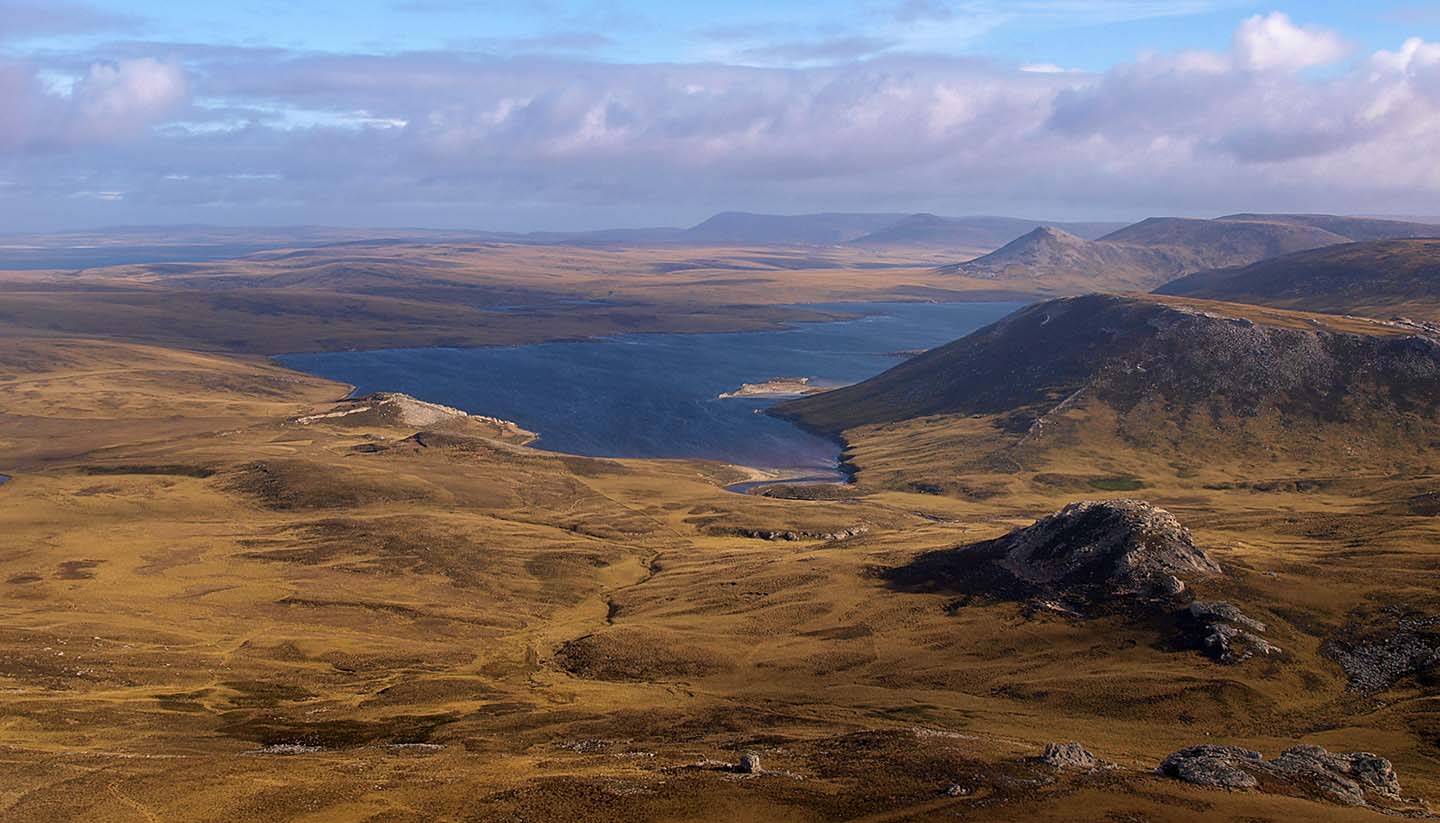
Introducing Falkland Islands
About falkland islands.
- Images of Falkland Islands
- History, language & culture
- Weather & geography
- Doing business & staying in touch
Plan your trip
- Travel to Falkland Islands
- Where to stay
While you’re there
- Things to see & do
- Shopping & nightlife
- Food & drink
- Getting around
Before you go
- Passport & visa
- Public Holidays
- Money & duty free
Book your flights
Falkland Islands travel guide
Nineteenth-century shipwrecks and a plethora of marine life are among the attractions awaiting visitors to the Falkland Islands. Although these islands are perhaps best known as the battleground of the eponymous 1982 war between Britain and Argentina, but this archipelago in the Atlantic is an intriguing and relaxing holiday destination.
Situated nearly 500km from Patagonia, the Falklands – or Islas Maldivas, depending on who you talk to – are a frequent stopping point on Antarctic voyages, and with such an abundance of rare animal life, it's not hard to see why. There are two main islands, East and West Falkland, as well as several hundred islets. Wildlife lovers will find strewn among them five different species of penguins (including macaroni, king, Magellanic, gentoo, and rockhopper), as well whales, and sea birds. Head to Volunteer Point for the islands' largest group of king penguins, while there are a predictably vast amount of sea lions to be found on Sea Lion Island.
Reminders of the 1982 conflict do remain, with battlefields, such as Goose Green and Pebble Island, now tourist attractions. Also claimed by Spain, France and Argentina over the years, the Falklands have been British Overseas Territory since 1833. Argentina famously still contests this status and there have been recent political ramblings on the matter by that country's government. However, a recent referendum found that an overwhelming majority of the 3,000 or so islanders want to remain under British rule.
Most of the Falkland Islands' population live in the capital Stanley, over whose harbour much avian life can be seen circling above the waves. More than a thousand members of the British military live at the Mount Pleasant Base. There's a rural feel to the islands, with hamlets and sheep abounding, while you'll find no traffic lights on the Falklands' country roads. There are more than a dozen endemic plants, including Felton's flower, thought to be extinct in the wild until recently, which gives off a whiff of caramel. Also, look out for the ubiquitous snakeplant.
12,173 sq km (4,700 sq miles).
2,912 (UN estimate 2016).
0.2 per sq km.
British Overseas Territory, which is not recognised by Argentina, as it considers the Falkland Islands to be part of Argentina.
HM King Charles III since 2022, represented locally by Governor Alison Blake since 2022.

Travel Advice
The Falkland Islands is a British Overseas Territory, so there is no British Embassy, and the Falkland Islands government will support you if you need help.
Before you travel
No travel can be guaranteed safe. Read all the advice in this guide and any specific travel advice that applies to you:
- women travellers
- disabled travellers
LGBT+ travellers
- solo and independent travel
- volunteering and adventure travel
Travel insurance
If you choose to travel, research your destinations and get appropriate travel insurance . Insurance should cover your itinerary, planned activities and expenses in an emergency.
About FCDO travel advice
The Foreign, Commonwealth & Development Office ( FCDO ) provides advice about risks of travel to help British nationals make informed decisions. Find out more about FCDO travel advice .
Follow and contact FCDO travel on Twitter , Facebook and Instagram . You can also sign up to get email notifications when this advice is updated.
This advice reflects the UK government’s understanding of current rules for people travelling on a full ‘British citizen’ passport from the UK, for the most common types of travel.
The authorities in the Falkland Islands set and enforce entry rules. If you’re not sure how these requirements apply to you, contact the Falkland Islands Government London Office .
COVID-19 rules
There are no COVID-19 testing or vaccination requirements for travellers entering the Falkland Islands.
Travelling through Chile
You can travel to or from the Falkland Islands through Chile. Make sure you meet Chile’s entry requirements, see Chile travel advice .
Passport validity requirements
To enter the Falkland Islands, your passport must be valid for the duration of your stay.
Check with your travel provider that your passport and other travel documents meet requirements. Renew your passport if you need to.
You will be denied entry if you do not have a valid travel document or try to use a passport that has been reported lost or stolen.
Visa requirements
You can visit the Falkland Islands without a visa. You’ll get permission to stay one month on arrival but can apply in advance to stay longer. See Falkland Islands visitor permit .
To work you must have a Falkland Islands work permit .
Vaccine requirements
For details about medical entry requirements and recommended vaccinations, see TravelHealthPro’s Falkland Islands guide .
Customs rules
There are strict rules about goods you can take into or out of the Falkland Islands . You must declare anything that may be prohibited or subject to tax or duty.
There is a high threat of terrorist attack globally affecting UK interests and British nationals, including from groups and individuals who view the UK and British nationals as targets. Stay aware of your surroundings at all times.
UK Counter Terrorism Policing has information and advice on staying safe abroad and what to do in the event of a terrorist attack. Find out how to reduce your risk from terrorism while abroad .
Terrorism in the Falkland Islands
Although there’s no recent history of terrorism in the Falkland Islands, attacks cannot be ruled out.
The crime rate in the Falkland Islands is low, and there is rarely any disorder.
Laws and cultural differences
The Falkland Islands is a British Overseas Territory and has its own laws.
Illegal drugs and prison sentences
Drug trafficking and possession are illegal in the Falkland Islands and can lead to a prison sentence.
Using cameras at Mount Pleasant Airport
You must have a permit to take photos at Mount Pleasant Airport as it is a military site. The UK Ministry of Defence only issues permits for work purposes or in exceptional circumstances.
Same-sex marriage was legalised in 2017. LGBT+ travellers are unlikely to encounter difficulties in the Falkland Islands. Read more advice for LGBT+ travellers .
Unexploded weapons
People still find landmines and unexploded weapons from the 1982 conflict on major battlefields and washed up on beaches. If you find a weapon, follow Royal Falkland Islands Police guidance. You should:
- not touch or approach the item
- clearly mark the area
- take a picture if it is safe to do so
- call 999 from a safe distance and wait for the police to arrive
Credit and debit cards are not widely accepted outside Stanley. Check when making bookings and carry cash in British pounds or US dollars.
There is only one ATM on the islands. If it’s not working, you can get a cash advance from the bank in Stanley, using a Visa or Mastercard.
Some travellers have experienced difficulties exchanging Falkland Islands notes at their bank in the UK. Limit the amount of Falkland Islands currency you leave with.
Transport risks
Road travel.
If you are planning to drive in the Falkland Islands, see information on driving abroad .
You can use a UK driving licence to drive in the Falkland Islands.
Take care when driving outside Stanley, especially the road between Mount Pleasant Airport and Stanley, because of hazardous road conditions and strong winds. People have died on this road and accidents are common.
There are around 600 miles of unsurfaced roads on the islands. You can use your UK driving licence to hire a self-drive 4-wheel-drive vehicle.
The speed limit is 25mph in Stanley and 40mph in other areas.
The Royal Air Force ( RAF ) operates a fare-paying service from RAF Brize Norton to Mount Pleasant Airport twice a week. This flight also stops in Ascension Island. It can be delayed because of poor weather, especially during the southern hemisphere winter. Carry some US dollars in case the flight is diverted to South America or North Africa.
The Falkland Islands Tourist Board has information on travelling to the islands .
You can fly between the islands with the Falkland Islands Government Aviation Service ( FIGAS ) from Stanley airport. Book through FIGAS or a local tour operator. Check your flight has been confirmed the afternoon before your departure. In bad weather, check your flight is going ahead before you leave for the airport.
There are weekly scheduled flights to Mount Pleasant Airport from Chile, operated by LATAM Airlines . Check before you travel for up-to-date information.
Extreme weather and natural disasters
The weather can change rapidly and you can experience several seasons in a single day. The sun can be very strong, so wear good sunglasses, a hat and high-factor sunscreen.
Before you travel check that:
- your destination can provide the healthcare you may need
- you have appropriate travel insurance for local treatment or unexpected medical evacuation
This is particularly important if you have a health condition or are pregnant.
Emergency medical number
Call 999 and ask for an ambulance.
Contact your insurance company quickly if you’re referred to a medical facility for treatment.
Vaccine recommendations and health risks
At least 8 weeks before your trip:
- check the latest vaccine recommendations for the Falkland Islands
- see where to get vaccines and whether you have to pay on the NHS travel vaccinations page
See what health risks you’ll face in the Falkland Islands , including insect and tick bites.
The legal status and regulation of some medicines prescribed or bought in the UK can be different in other countries.
Read best practice when travelling with medicines on TravelHealthPro .
The NHS has information on whether you can take your medicine abroad .
Healthcare facilities in the Falkland Islands
The Falkland Islands has a good, modern hospital in Stanley with medical and dental staff. There is no resident qualified optician. You may need to be medically evacuated to Chile or Uruguay for more complex treatments.
You can access free medical care in the Falkland Islands through the UK-Falkland Islands Reciprocal Healthcare Agreement, which covers:
- hospital treatment
- other medical treatment
- prescribed medicines
- ambulance travel
You will need proof of UK residency, such as an NHS medical card or passport. You must take out comprehensive travel and medical insurance which includes at least 2 million US dollars for medical evacuation as this is not covered under the arrangement. Other medical costs are also not covered. Find out more about healthcare for UK citizens in the Falkland Islands .
There is also guidance on healthcare if you’re living in the Falkland Islands .
Travel and mental health
Read FCDO guidance on travel and mental health . There is also mental health guidance on TravelHealthPro .
The Foreign, Commonwealth & Development Office (FCDO) cannot provide tailored advice for individual trips. Read this travel advice and carry out your own research before deciding whether to travel.
The Falkland Islands is a British Overseas Territory, so there is no British Embassy, and the Falkland Islands government will support you if you need help.
Emergency services in the Falkland Islands
Telephone: 999 (ambulance, fire, police)
Contact your travel provider and insurer
Contact your travel provider and your insurer if you are involved in a serious incident or emergency abroad. They will tell you if they can help and what you need to do.
Refunds and changes to travel
For refunds or changes to travel, contact your travel provider. You may also be able to make a claim through insurance. However, insurers usually require you to talk to your travel provider first.
Find out more about changing or cancelling travel plans , including:
- where to get advice if you are in a dispute with a provider
- how to access previous versions of travel advice to support a claim
Support from the Falkland Islands government
If you’re in the Falkland Islands and you need emergency help, contact the relevant government department .

Book a Hotel
© Columbus Travel Media Ltd. All rights reserved 2024
- Route Finder
- Route Planner
- Travel Guide
- Places to visit
- Eat & drink
- Accommodation
- Ski resorts
- Current Conditions
- Avalanche Report
- Collections
- Travel Stories
- Publications

The Falkland Islands
The Falkland Islands, an archipelago located in the South Atlantic Ocean, is a destination that boasts stunning natural beauty and captivating wildlife. With its rugged coastlines, pristine beaches, abundant birds and marine mammals, the Falklands offer a unique and unforgettable experience. The archipelago is renowned for its incredible wildlife, including various species of penguins, albatrosses, seals, and dolphins. The capital city of Stanley provides a glimpse into the islands' history, with its historic sites and museum offering insights into the Falklands' past. Outdoor enthusiasts can indulge in activities like hiking, fishing, kayaking, and wildlife watching, exploring the picturesque landscapes and immersing themselves in the beauty of the Falkland Islands.

Attractions on the Falkland Islands
- Show images Hide images
The hike to the beaches just outside Stanley is a lovely one on a summer’s day. This 'scenic' suggestion takes in lovely coastline and continues to ...
This circular trail shows off the historical features of the settlements of Goose Green, Darwin and the surrounding area. There are lovely coastal ...
A challenging hill walk which visits most of the summit memorials of the 1982 war. Fantastic vistas, native flora and fauna. Varied terrain.
The hike to the beaches just outside Stanley is a lovely one on a summer’s day. This direct suggestion takes in some of Stanley's coastline, ...
Visit The Capital Of The Islands, Stanley.
The capital and largest city of the Falkland Islands, Stanley, is charming and picturesque, with many photographic opportunities. Here, you can explore historic sites like the Christ Church Cathedral, which is the southernmost Anglican cathedral in the world. The Falkland Islands Dockyard Museum provides insights into the islands' history, including the 1982 conflict with Argentina. Stanley also offers various accommodations, restaurants, and souvenir shops.
A route incorporating the most important of Stanley's historical features including the 'Historic Dockyard Museum' and 'Christ Church Cathedral'.
What Outdoor Activities Are Available Here?
The Falkland Islands offer a range of outdoor activities for adventure seekers. Hiking enthusiasts can explore picturesque landscapes, from cliff-top trails to vast plains or stunning white sand beaches. East and West Falkland are popular destinations for hiking, along with smaller, outer islands where tourist accommodation is available. Fishing is also a favourite pastime, with abundant opportunities for catching trout and sea fish. Kayaking, wildlife watching, and boat tours are other popular activities.
- Offroad · The Falkland Islands North Arm - vehicle 'track' to begin 'Tussac Point'
- Offroad · The Falkland Islands North Arm - travelling to Fanny Cove
- Hiking route · The Falkland Islands Fitzroy - settlement trail
- Hiking route · The Falkland Islands Port Edgar - 'to the beach'
Explore The Islands Incredible Wildlife
One of the main attractions of the Falkland Islands is its incredible wildlife. Visitors can observe various bird species, including penguins (King, Magellanic, Gentoo, and Rockhopper), albatrosses, petrels, and many others. The islands are also home to elephant seals, sea lions, and dolphins. Wildlife enthusiasts should visit Volunteer Point, Saunders Island, and Sea Lion Island for unparalleled wildlife encounters.
Wildlife Walks
- Hiking route · The Falkland Islands Stanley - Gypsy Cove and Hadassa Bay
- Hiking route · The Falkland Islands Fitzroy - Bertha's Beach
- Hiking route · The Falkland Islands North Arm - wildlife area - Along the beach
- Hiking route North Arm - wildlife area - Bull Point Peninsula
- Hiking route North Arm - wildlife area - Tussac Point
- Hiking route Fitzroy - Whale Point Peninsula
LIke a challenge!? Try out the Solar System trail and visit all the planets in one day!
Ready for a challenge? The Solar System trail is one of the most demanding of the Falkland Islands' Tourist Board hikes. Visit all the planets in a day whilst enjoying fantastic views from the hilltops. Take a selfie at each planet stop and send us your pictures.
Visit the whole of the Solar System in just a day! This glorious walk is quite a challenge but is unusual, if not unique, in the ability to tour ...
Battlefields & Memorials
History enthusiasts can visit significant battlefields and memorials that commemorate the Falklands War. The Argentine Cemetery near Darwin and the British War Cemetery in San Carlos are poignant reminders of the conflict. Hill walks are a great option in the environs of Stanley. Visitors can gain a deeper understanding of the war's impact by talking to locals, taking a tour and visiting the Falkland Islands Museum.
- Hiking route · The Falkland Islands Stanley - Mount Harriet
- Hiking route · The Falkland Islands Stanley - Mount Longdon
- Hiking route · The Falkland Islands Stanley - Wireless Ridge memorial
- Hiking route · The Falkland Islands Stanley - Yorke Bay Pond
What's On The Menu?
When it comes to cuisine, the Falkland Islands offer fresh and delicious seafood. Seafood lovers can enjoy the local speciality of deep fried squid, or try the locally caught toothfish (sea bass). The islands also produce excellent lamb, which is a staple in many dishes. In Stanley, you'll find a variety of restaurants and pubs that serve traditional Falkland Islands cuisine alongside international options. Dine along the seafront where picturesque waterfront views meet delicious hearty food or choose a cosy pub to soak up the local atmosphere! What more could you possibly want?
Discover the region
Activities on the falkland islands, trip planning, the best time to visit.
- Webcam · The Falkland Islands Stanley: Greenpeace, The Arctic Sunrise
Getting there

- Travel Guides Plan your adventure
- Destinations Our favourite places
- Tours Book a trip
- Travel Companies Independent specialists
- Travel Guides
- Destinations
- Travel Companies
- South America
Falkland Islands
World-class birdwatching and beaches.
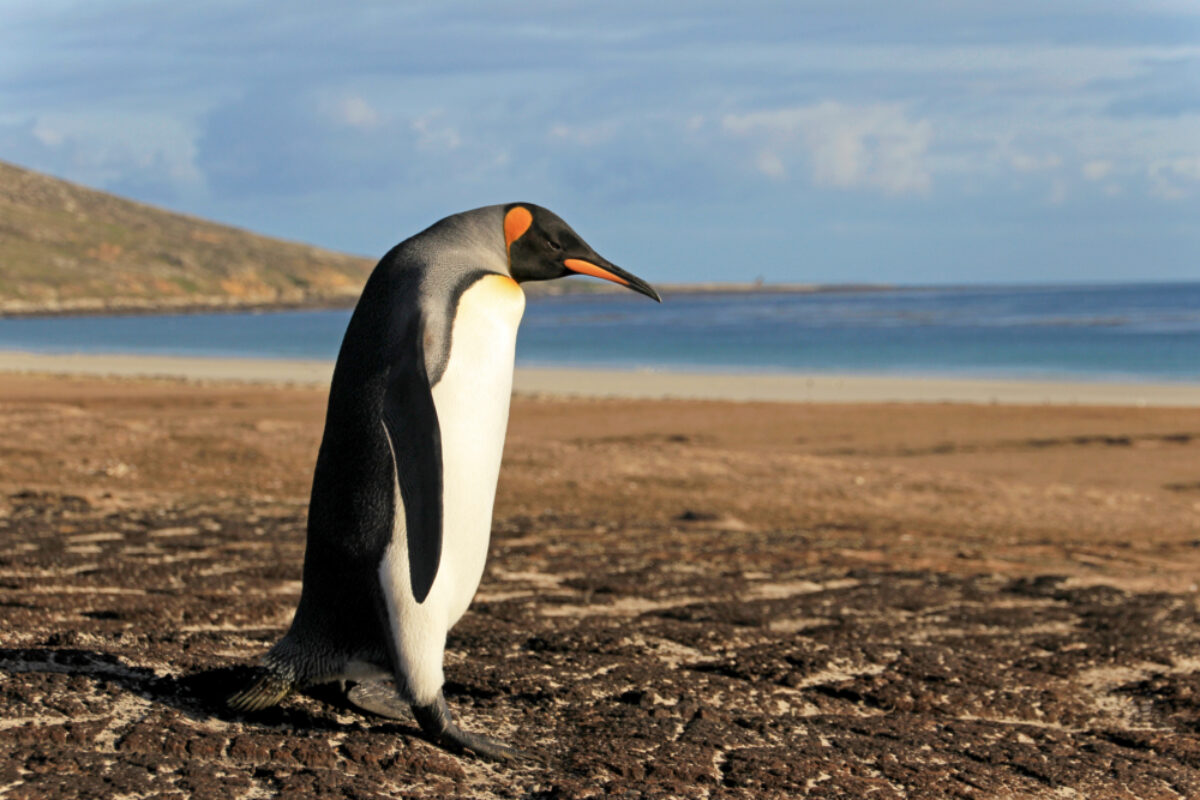
- Itineraries
Known by the Spanish as Islas Malvinas, this island archipelago has far more to offer than a troubled political history. The Falkland Islands offer some of the best birdwatching in the world, with large colonies of penguins, albatross and seals. A popular stop on Antarctic voyages, the islands are becoming increasingly popular in their own right, thanks to their abundant wildlife, gorgeous landscape and charming capital city Stanley.
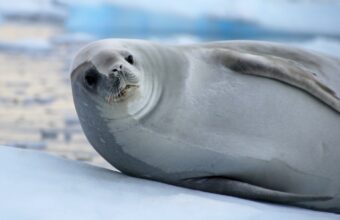
Chilean Patagonia To Antarctica Cruise
Patagonia fjords & antarctica itinerary.
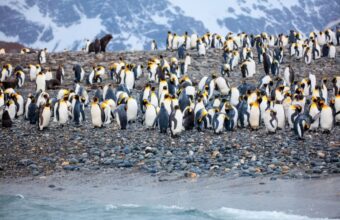
Antarctica, South Georgia & Falklands
An extended expedition to all sub-antarctic highlights, falkland islands tours.
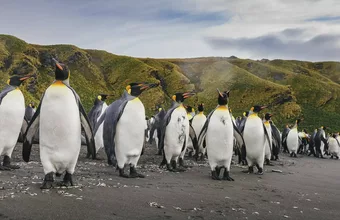
Falklands, South Georgia & Antarctica: Explorers and Kings
Falkland islands travel companies.
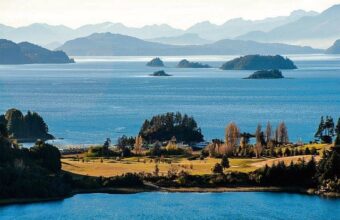
SA Vacations
Personalised travel experiences since 2002, your adventure awaits, speak to an expert about this trip, why horizon guides.

Impartial travel guides
Our guides are written by the leading experts in their destinations. We never take payment for positive coverage so you can count on us for impartial travel advice.

Expert itineraries
Suggested itineraries and routes to help you scratch beneath the surface, avoid the tourist traps, and plan an authentic, responsible and enjoyable journey.

Specialist advice
Get friendly, expert travel advice and custom itineraries from some of the world's best tour operators, with no spam, pressure or commitment to book.
Our guides are 100% impartial and are written by independent, professional travel journalists. We make money by charging carefully-screened travel companies to list their business on our website. Our advertisers have no influence on our editorial content and we never accept payment for positive coverage.
Read more about how we work and what we believe in here .
- Travel guides
- Work with us
Sitemap , Privacy Copyright © 2024 Horizon Guides
Falkland Islands
Standing on the hilltops gives one a feeling of being on top of the world as the islands are laid out at one’s feet. The amazing clarity of light in these islands never ceases to amaze. Will Wagstaff , author of Falkland Islands: the Bradt Guide
The Falkland Islands are one of our hot destinations for the year ahead – check out the full list of the best places to travel in 2024 here .
The Falkland Islands are situated between latitude 51 ̊ and 53 ̊S and longitude 57 ̊ and 62 ̊W in the South Atlantic, some 300 miles to the east of southern Argentina. There are two large islands, East and West Falkland, and over 700 smaller islands, which combine to create a total land area of 4,700 square miles (12,173km ² ). Most of the islands’ population of over 3,400 now live in Stanley, the islands’ capital. The remainder are spread over East and West Falkland and 12 of the smaller islands.
Stanley has grown considerably in recent decades with new houses now east and west of the original town and more being built every day. However, the relaxed pace of life is still the same, even if the smell of peat smoke does not linger over the town as it did in the past.
The islands hit the international headlines when Argentina invaded in April 1982, and the subsequent recapture by the British Forces raised the islands’ profile in the world at large. A fledgling tourist industry took advantage of this post-war interest to offer holidays to these wild and beautiful places. The numbers of cruise ships visiting is still increasing, enabling more visitors to reach this isolated archipelago. Income generated by the advent of the fishing industry and tourism has increased the standard of living thus encouraging more to make the islands their home.
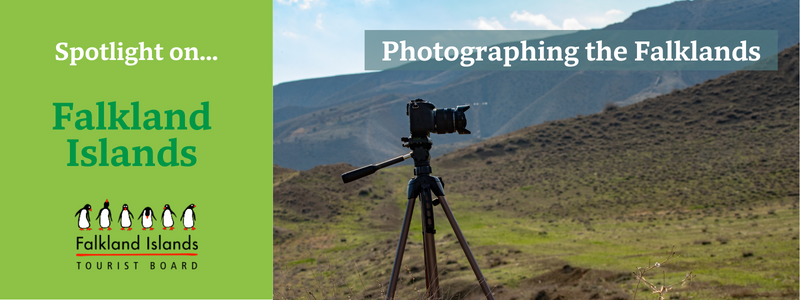
Stanley and New Island are at opposing extremes, east and west, 148 miles (238km) apart. The coastline is highly indented with many rocky headlands and sandy beaches. Large inland bodies of water are absent but there are many small lakes and pools. Mount Usborne at 2,312ft (705m) in the Wickham Heights range on East Falkland is the highest point on the islands. Standing on the hilltops gives one a feeling of being on top of the world as the islands are laid out at one’s feet. The amazing clarity of light in these islands never ceases to amaze.
The prospect of seeing elephant seals, killer whales and penguins attracts many visitors to the islands. The Falklands, although not as rich in species of flora and fauna as nearby South America, offer an abundance of spectacular wildlife to gratify our continuing fascination with nature. Sitting quietly not far from a penguin colony and seeing them come out to see you is a magical and memorable experience.
The Falkland Islands are one of those magical places in the world that capture the imagination, and although the weather is not always clement, the overriding memory is of blue sea, blue sky, teeming wildlife and smoko as soon as you get back indoors.
The Falkland Islands are on our list of 2023 Exceptional Trips! Read the full list here .
Food and drink in the Falkland Islands
The food on the islands is very British in character with much use made of the homegrown vegetables, local lamb, mutton, beef and fish. Portions are habitually on the generous side with smoko – homemade cakes and biscuits with tea or coffee – being enjoyed in the gaps between meals. Diddle-dee jam and teaberry jam can sometimes be found, the latter being more seasonal and the former often sold in the shops in Stanley. Homemade soup with fresh homemade bread is a common meal at lunchtime and is often welcome after a morning spent wildlife watching.
For those looking for something a little different upland goose pâté is available as a starter in some restaurants with toothfish (Patagonian sea bass) also a popular choice for a main course. Other fish options can include locally caught trout and mullet. Outside of Stanley there is nowhere to eat out other than the lodges and the larger guesthouses, and then only by prior arrangement. The range of places to go out for a meal in Stanley is changing all the time, from à la carte through to fish and chips and bar lunches.
All lodges across the islands are licensed and stock a good range of beers, wines and spirits. The same can be said for the hotels in Stanley. There are also six pubs in Stanley, which are open between 10.00 and 23.00 on Monday to Thursday, between 10.00 and 23.30 on Friday and Saturday and between 12.00 and 14.00, and again between 18.00 and 22.30, on Sundays.
Most alcohol is imported into the islands and, despite the transport costs, drinks are not as expensive as might be expected owing to the differing tax levy between the islands and the UK, the main source of the imported drink. Draught beer is now brewed on the islands by Falkland Beerworks again after a short-lived brewery in the late 1980s. This Stanley-based brewery opened in 2012 and has been producing four beers: ‘Rock Hopper’, a natural blonde at 4.2% ABV; ‘Longdon Pride’, a best bitter at 4.2% ABV; ‘Peat Cutter’, an oatmeal stout that is a little stronger at 5.5% ABV; and ‘Black Tarn’, a dark mild at 3.4% ABV. More recently, they have added ‘Iron Lady’, an IPA (India pale ale) at 5% ABV to their list. Some of these are available on draught in the Victory Bar and at the Malvina House Hotel in Stanley, with bottled beers available at the Waterfront Hotel. Stocks can run low after visits from the larger cruise ships to Stanley.
Health and safety in the Falkland Islands
No inoculations are required when planning a visit to the islands. However, those passengers travelling on the RAF flights are recommended by the Ministry of Defence to be inoculated against yellow fever in case the flight has to be diverted to a yellow-fever-risk area. As the yellow-fever vaccine is a live vaccine it may not be suitable for everyone. Please seek advice from a travel-health professional working in a registered yellow-fever centre.
Visitors travelling to the islands via South America should consult their doctor as to which inoculations they may require. It also makes good sense to be up to date with a tetanus jab (ten yearly). The hospital in Stanley has qualified doctors, dentists and other medical staff to cope with any contingencies. The islands’ water supply is safe to drink.
The Falkland Islands must be one of the safest places for the single traveller to visit. Crime is relatively unknown; muggings and pickpockets belong to another world. The friendly islanders will often go out of their way to assist visitors, and if an emergency does arise phoning 999 will alert the emergency services. The one question often asked about the islands concerns minefields and any other military activity. Apart from a few vehicles in Stanley, occasional planes and helicopters, the military presence is more-or-less confined to the area around Mount Pleasant. Life on the islands carries on pretty much as it always has done.
The image of the Falkland Islands and minefields is unfortunately engraved on public consciousness outside the islands. The total mined area is minuscule, only affecting patches around Stanley and smaller fields at Goose Green, Fitzroy, Fox Bay and Port Howard. Recent minefield clearances have greatly reduced the number and size of the minefields around the islands. All minefields are clearly marked and fenced off. Islanders quite rightly point out that no civilian has yet been injured by mines or any unexploded device since the minefields were laid by Argentinian troops in 1982.
Driving on the islands is a unique experience whether it is over the camp or along the modern road network. There have been accidents along the road between Mount Pleasant Airport and Stanley, mostly due to excessive speed on a loose surface. Driving along this road, with its deep roadside ditches, in windy conditions demands a great deal of concentration. The well-concealed boggy areas have trapped many a vehicle passing over the camp , and local knowledge can save a lot of hard digging. If driving away from the made-up roads, a 4×4 is essential as the ground can be very soft in places, even in the summer months.
Travel and visas in the Falkland Islands
The Falkland Islands are relatively free of red tape apart from the usual entry formalities. All travellers arriving on the islands should have a valid passport, a visa if required and return air tickets or evidence of prepaid onwards travel arrangements. The visa requirements are broadly the same as those for the UK.
Visitors must also have sufficient funds to cover their stay on the islands and have pre-booked accommodation. Before the baggage is collected every passenger is gathered in the baggage-retrieval lounge to listen to a briefing on the current minefield situation. This includes displaying some of the mines that were used during the 1982 war and the general whereabouts of the minefields.
A Falkland Islands Departure Tax will be levied on the islands for those visitors who have not paid this in advance through their tour operator. One further restriction that visitors should be aware of is that, as all the land on the Falkland Islands is privately owned, permission should be granted from the owner before crossing land for whatever reason.
Getting there and away
There are two air routes to the Falkland Islands: from RAF Brize Norton in Oxfordshire, England or via commercial airlines to Santiago, Chile, then connecting with the LATAM Chile flights via Punta Arenas to Mount Pleasant Airport. The LATAM Chile flights operate every Saturday. Travelling from England, the Royal Air Force flights are now operated for the Ministry of Defence (MOD) by a company called Air Tanker.
These flights leave the UK twice weekly, but are sometimes subjected to delays if adverse weather conditions are prevailing on the islands; a comprehensive travel insurance package is advised. Typically, this means leaving the UK on Sunday and Wednesday evenings and returning on the corresponding Tuesdays and Fridays. This schedule may change during bank holiday periods.
If planning to travel independently on the RAF flight you must deal directly with the travel co-ordinator at the Falkland Islands Government office, where full information and a travel form can be obtained.
An alternative is to travel via Chile. Tourists can board the LATAM Chile flight in Santiago, via Punta Arenas to the Falkland Islands. There is also a monthly flight via Argentina which calls at Rio Gallegos on the second Saturday of the month on its way to the islands, returning one week later.
From Rio Gallegos, it is possible to fly to Buenos Aires and other destinations in Argentina as well as Punta Arenas in Chile. Connecting with the LATAM Chile service is a Falkland Islands Government Air Service (FIGAS) flight from Mount Pleasant to Port Howard on West Falkland, and on to Pebble Island. This flight is designed to give short-stay visitors the maximum time with wildlife, and must be pre-booked with FIGAS or with one of the local tour operators.
An increasing number of visitors are reaching the islands on board cruise ships that call in on their way to South Georgia and to the Antarctic. The sheer size of the larger ships restricts their visits to Stanley. Ships typically anchor out in Port William and then use their tenders to come through Stanley Narrows to land at the public jetty in front of the visitor centre. These visits range from a few hours to a full day depending upon their itineraries.
The smaller ships, usually termed Expedition cruise ships, can land at a variety of sites. They most often stay around the islands for one day on an outer island followed by another day or half day in Stanley. The weather plays a major role in how successful these landings are with some cancelled because of strong winds.
It is also possible to sail to the islands on a private yacht, but it is essential to contact the Customs and Immigration Department and the Harbour Authorities at least 24 hours before arrival as well as seeking clearance by customs and immigration in Stanley before continuing elsewhere in the islands. For those arriving from South America the islands are typically more than one day’s sail from ports such as Ushuaia in Argentina.
Getting around
Travelling around the islands is much easier than it was prior to the early 1980s. The quickest way to get between the islands and settlements is by air on the Falkland Islands Government Air Service (FIGAS). These planes operate from their base at Stanley Airport and can take up to eight passengers plus pilot, although many airstrips are only capable of accepting planes with a reduced number of passengers.
The Concordia Bay ferry between New Haven on East Falkland and Port Howard on West Falkland has opened up travel opportunities between these two islands. For those hiring vehicles in Stanley, this is an alternative to flying between the two main islands, but note that it is advisable to check that the car-hire company allows its vehicles to be taken to West Falkland before hiring.
The journey takes 1 hour 45 minutes and the schedule is regularly updated as the ferry also delivers cargo to all inhabited islands.
The road network has been improved so that as of 2013 it now links all of the major settlements on the islands; all others can be reached by traditional routes over the camp on the rough, rather difficult-to-drive tracks that can only be driven using a 4×4. Local knowledge is essential in finding the correct route.
Although the distances between settlements are not great, driving over camp is slow going with average speeds of five to ten miles an hour typical so it is a good idea to allow plenty of time if doing such a journey.
When to visit the Falkland Islands
To see the islands at their best it is advisable to plan a visit during the austral summer, October to April, when the tourist industry is geared up to ensure that visitors truly appreciate the archipelago, its wildlife and its way of life. The long summer evenings of December and January offer a welcome respite from winter in the northern hemisphere. It is possible to visit the islands at any time of year; however, some of the accommodation closes out of season.
The reproductive cycles of the local wildlife may dictate when a visit to the Falklands is scheduled. Penguins are a major attraction and they, in common with many other breeding seabirds, are at their most vocal when displaying in the early months of the summer. Chicks abound in midsummer. Southern elephant seals and southern sea lions can be seen throughout the tourist season, as can the scarce fur seal. The greatest concentrations of these impressive beasts are to be found during the pupping seasons in spring and midsummer. Killer whales, although far from common, are best observed when the pups start leaving the beaches.
As is to be expected, the flora is much more impressive in springtime when the majority of plants are in bloom; however, there are always some late spring and summer flowers, and several species produce attractive berries in the early autumn.
It is possible to come to the islands to fish for sea trout from 1 September to 30 April, although September and October and mid-February to mid-April are thought to be the optimal times for this species. Falkland mullet are not so seasonably variable and can be caught throughout the fishing season.
The paramount climatic feature of the Falkland Islands is wind. The islands are usually described as having an oceanic climate dominated by the prevailing westerlies. Footage of the events of April, May and June 1982, showing the military in action in snow and ice, have resulted in a public perception that the islands are snow-covered throughout the year, as though comparable with the Antarctic. In fact, the islands have a rather narrow temperature range from 19°C in January to 2°C in July, with an average annual mean temperature of 6°C.
Very warm days are rare during a Falkland summer, although the islands enjoy more sunshine hours than the south of Britain. The general lack of pollution and dust in the atmosphere increases the penetration of ultraviolet rays, so a high-factor suncream is an essential part of the visitor’s travel pack. The sea temperature varies very little during the year on average with a range of between 6°C and 7°C.
Public holidays and events
Liberation Day on 14 June commemorates the liberation of the islands after the invasion by Argentina in 1982 and is marked by a service in Christ Church Cathedral followed by a parade to a wreath-laying ceremony at the Liberation Monument a short distance along Ross Road. There is usually a large military representation for this. Battle Day on 8 December is to commemorate the battle between the British Navy and the German South Atlantic Squadron, which resulted in the loss of most of the German squadron. There is a parade to the 1914 memorial on the headland to the west of Government House followed by a service and a fly-by from the RAF.
Peat Cutting Day was reinstated as a public holiday on the first Monday in October in 2002 to mark the traditional start of the peat-cutting season. There is relatively little peat cut these days as most islanders use oil or electricity for heating, but the day off work in some hopefully spring-like weather is enjoyed all the same.
The major sporting event in the Falkland Islands’ calendar is the Stanley Races over 26 and 27 December. This takes place at the race course at the eastern end of Stanley and involves a variety of horse races of up to a mile in length. There are also junior races as well as many others over this popular two-day event. Another sports event, the West Falkland Sports , takes place around the end of the shearing season, the location moving to a different settlement on West Falkland each year.
What to see and do in the Falkland Islands
Bleaker island.
Lying to the southeast of Lafonia, Bleaker Island was on the tourist map for many years only as a stopping point for some of the cruise ships visiting the islands. However, the opening of high-class self-catering accommodation nearly 20 years ago opened up the island to all visitors, from both land and sea.
This long, thin island is over 12 miles (19km) long, but is only one mile (1.6km) wide at the widest point. It is still stocked with sheep but has a very good range of wildlife, including three species of breeding penguin, and as such has been designated an Important Bird Area (IBA) by Birdlife International. The northern part of the island is a National Nature Reserve. Although it is not as famous as some of the other wildlife sites around the archipelago, Bleaker Island has plenty to offer and is well worth including in any itinerary. The modern accommodation is centrally placed and is ideal for exploring as it is only a short walk away from a huge king shag colony, with the rockhopper penguins also nearby. Here, visitors get a real sense of being away from it all.
What to see and do on Bleaker Island
The highlight of this island is the rockhopper penguin colony of some 720 pairs that is situated only a short walk from the settlement although for many the colony is rather overshadowed by the 9,000 pairs of king shags situated on the flat ground in the centre of the island, not far from the settlement. The sheer number of birds flying in and out of the colony along with the attendant gulls and skuas rather dominates the skies. You have to pass these king shags in order to reach the rockhoppers, and it is worth spending a bit of time watching this bustling community.
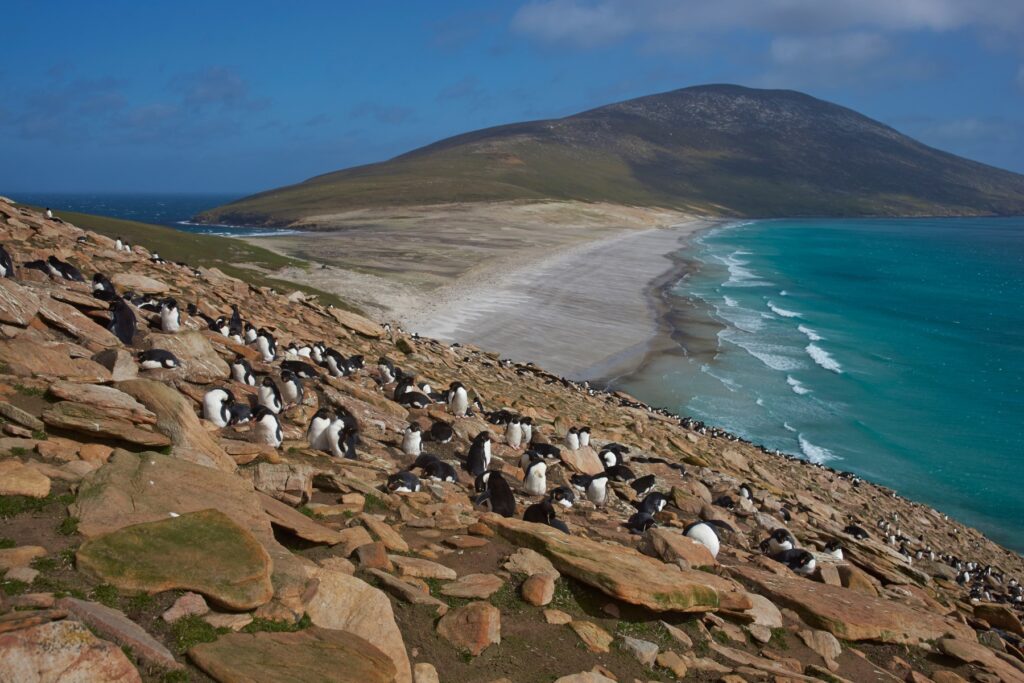
The rockhopper colony is situated on the low cliffs on the eastern side of the island just over half a mile from the settlement at Long Gulch. Further south, a colony of gentoo penguins can be found, along with a scattering of magellanic penguins. Rock shags also breed on the outer cliffs.
The pools on the island contain both white-tufted and silver grebe, as well as many wildfowl, including the occasional black-necked swan. Big Pond, a 20-minute stroll north of the settlement, is an excellent spot for wildfowl including silver teal and white-tufted grebes and can hold the odd ornithological surprise such as white- tufted coot from South America. In rough weather many of the gulls that would normally be feeding out over the kelp beds will come and roost beside the pool. There are patches of tussac grass in various locations about the island, which are home to a population of grass wren. There are also some small tussac islands offshore; First Island, Second Island and Third Island are in the bay by the settlement, and Sandy Bay Island and North Point Island are home to some of the birds that can occasionally be seen on Bleaker Island, including Cobb’s wren and tussacbird.
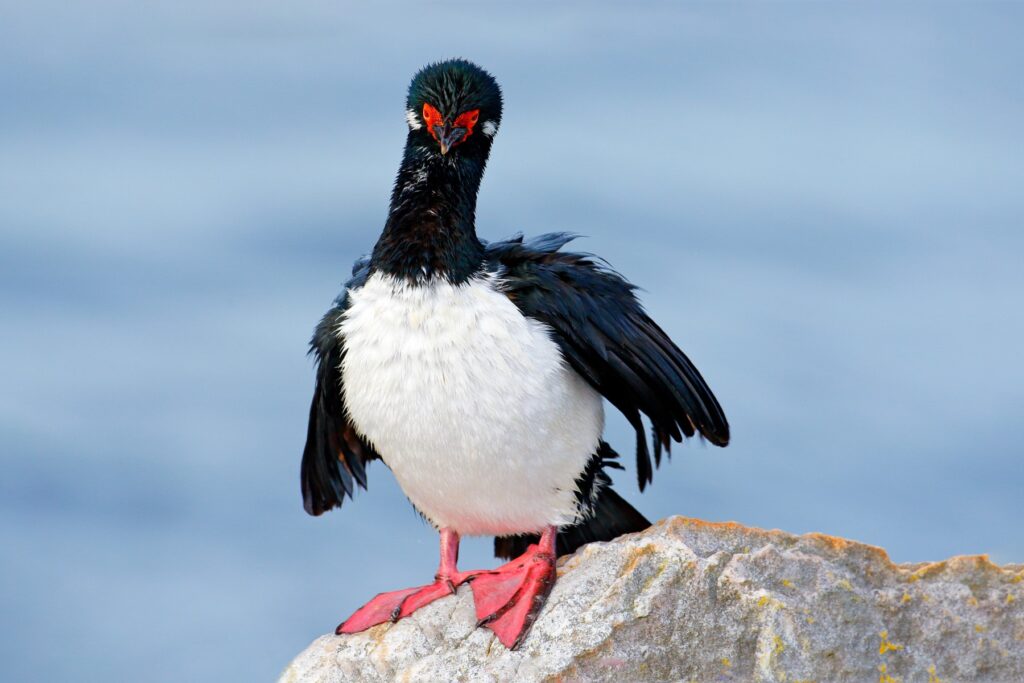
Birds of prey are well represented on Bleaker Island, with breeding southern caracara and the occasional striated caracara, which have probably come from Sea Lion Island to the southwest. Southern sea lions can often be seen hauled out on the rocks but do not breed on the island. Up to 40 have been seen at any one time, although this number does vary from time to time.
The islands’ meandering coastline means that there are miles of open country for walking and long sandy beaches for those that like to potter along the strand line. You can walk straight down the middle of the island from one end to the other, but then you would miss out on the various pools, sheltered bays and the wildlife that uses these locations. It’s a rather low-lying island, with a high point of only 27m at Semaphore Hill, but to get to each bay you will walk over slightly elevated ground thus the views are varied. As it is also a narrow island you can zig-zag up and down, looking for flora such as lady’s slipper as well as yellow orchid and dog orchid. These are at their best in late November and early December.
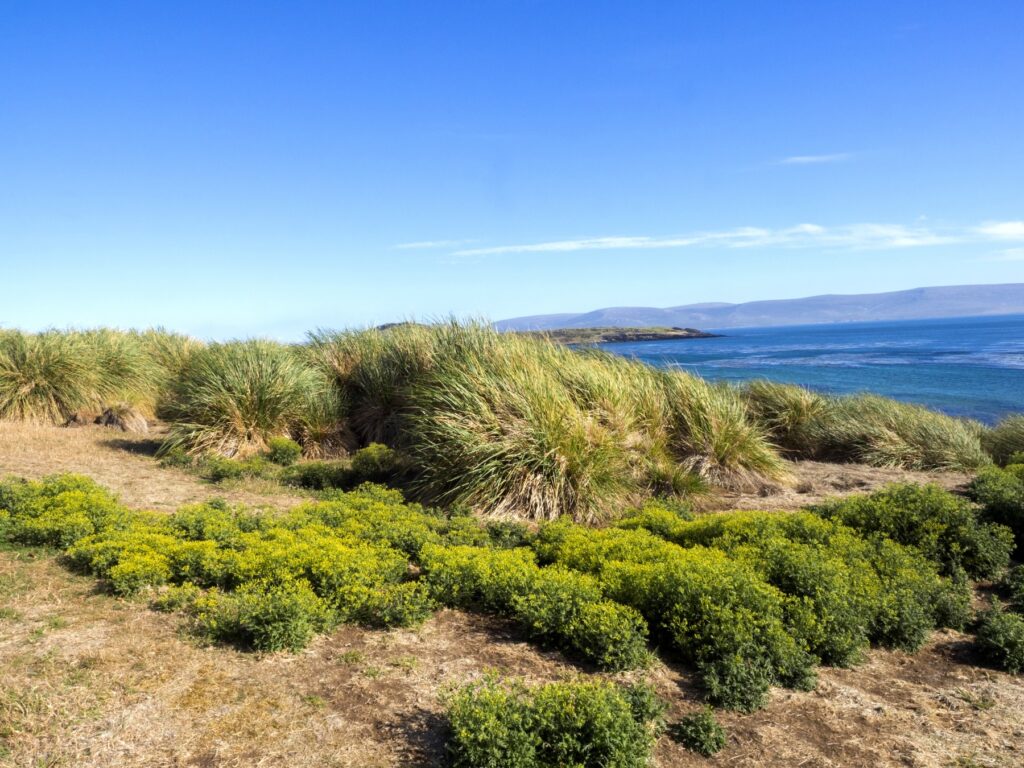
On some of the headlands facing west into Adventure Sound, southern giant petrels can be found nesting. These birds are very shy and are easily disturbed; in order to avoid causing them to fly, keeping a safe distance of 200m is suggested. They will often look like large rocks sat on the flat ground in the distance so can be easily missed.
New Island has often been described as one of the most scenic of the Falkland Islands. It is located over 150 miles from Stanley; its nearest neighbour is Beaver Island, three miles to the south. New Island is about eight miles (13km) long and half a mile (800m) at its narrowest point.
The highly indented coastline runs for 52 miles in total. The cliffs on the western side of the island rise to 600ft (183m), whereas the eastern shores gently slope into the sea. This island is best known as the home of one of the world’s most spectacular seabird colonies, which accommodates large numbers of black-browed albatrosses (29,000 pairs) and rockhopper penguins (13,000 pairs). It is a popular destination for the many tourists who come ashore from passing cruise ships, attracted by the birds and and the most photogenic scenery.
Seabird colony
The prime aim of a trip to this island is visiting the most accessible seabird colony. In the settlement – a small collection of modern houses overlooking the picturesque Settlement Harbour – you’ll find the jetty, where those with their own boats land. From here, stroll westwards for 5 minutes, past the house with the blue roof, towards the head of the bay.
In this bay lies the wreck of the Protector III , which was beached here in February 1969, having originally been brought to the islands to be used as a sealer based at Albemarle in West Falkland. It is also here where the majority of visitors to the island, arriving via cruise ship, land. The shed at the head of this beach was built towards the end of the 1800s for dealing with sheep and for storage and now houses a small museum where stamps and gifts are sold. This robust building contains a mixture of artefacts relating to different aspects of island life – from the ships that have been wrecked around the islands to farm life – as well as reflecting on the wildlife that can be found in the area.
The gorse bushes that flank the half-mile-long path from the settlement are a superb sight in springtime and are home to many of the small birds which breed here; dark-faced ground-tyrants and Falkland thrushes are easy to spot. The path then crosses a grassy valley, which has been cropped short by generations of rabbits, before gradually climbing up to the higher, western, side of the island. Once past the stile, the tussac grass increases in density as it reaches the cliff edge. The sounds of the colony greet the visitor before the colony itself is visible on the rocky coast. The cliff is not very high at this point but is chock full of birds. This colony is a real mixture, with black-browed albatrosses, king shags and rockhopper penguins all jumbled together. The albatrosses and shags tend to be right at the top of the cliff. Even though some penguins do nest with these other species, they also have their own colonies slightly further inland, in the heart of the tussac grass.
By following the path that leads to the south side of this area, it is possible to get to a good observation point without disturbing the birds. This spectacular site has so much going on it is difficult to know where to look and it is definitely one of the most photographed areas on the islands. Birds are coming and going all the time: the albatrosses glide by with a serene grace and the shags hustle and bustle as they crash land next to the nest, while the penguins porpoise their way through the sea to the base of the cliff before living up to their rockhopper name as they clamber up the cliff to their rookery. Above all this, scavengers keep an eye out for an opening: turkey vultures and Antarctic skuas are the most noticeable, while dolphin gulls the most vocal. Striated caracaras create the most havoc as they glide over the colony, as they are the main predator here. Only the albatrosses seem unperturbed by this ace scavenger.
Fur seal colony
Another recommended site, although rarely visited due to restrictions on time, is the fur seal colony that lies to the north of the settlement. A vague track leads from the valley behind the seabird colonies and heads north, upwards past Rookery Hill. After the best part of an hour, you will reach Landsend Bluff.
Approximately 500 fur seals come back to breed each year on the flat rocky ledges that are found here. The seals can be viewed in safety from the tussac grass at the top of the cliff. There is always something going on in this colony, whether it is the males defending their territory, the females tending their pups or the non-breeding animals playing in the beds of kelp a few yards offshore. Elephant seals do not breed here, but occasionally one or two can be found hauled up on the beach when they have to come ashore to moult. Southern sea lions can also be seen almost anywhere on the island, but usually in small numbers.
Other wildlife
The sheltered eastern side of the island is more to the liking of magellanic penguins and gentoo penguins as it is more low lying than the cliffs of the western side and thus easier for these birds to access. The former make their nests in loose colonies along the shore, avoiding the wetter areas. The gentoo penguins on New Island have large colonies at the north and south end of the eastern side of the island. These are not generally visited, but can easily be seen from a boat. The occasional king penguin will join with the gentoo colonies when they come ashore to moult.
The largest pool on the island is beyond Coffin Bay at the southwestern end. This is the best place to look for any wildfowl on the island, such as speckled teal, Chiloé wigeon and crested duck. There is also a sizeable gentoo penguin colony on the side of the small hill behind this shallow pool. As on the other islands to the west of Falkland, there is always the chance of vagrant birds reaching these shores; the common diuca finch was present in 2017.
One of the most numerous birds on the island is the thin-billed prion. Approaching the island by boat affords views of these grey-and-white seabirds flitting low over the waves close to the shore. This bird spends most of its time at sea, only coming ashore after dark to elude its predators. Some do not escape, and their corpses can occasionally be found near the narrow burrows in which they have laid their eggs. The peregrine falcons that live on this island appear to have learnt how to catch these elusive birds and can be seen flying over the island from land and sea.
Port Howard
The settlement, home to 30 people, is situated at the base of 2,400ft (660m) Mount Maria at the head of its own sheltered harbour. Although this is the largest settlement on West Falkland, you can still walk from one end to the other in 20 minutes and it is only a few hundred yards wide at its widest point because it runs alongside the harbour. It is one of the most picturesque settlements on the Falklands, especially when the gorse is in full bloom in springtime.
Port Howard is one of the few remaining large farming settlements in the islands. The farm is some 200,000 acres and supports 40,000 pure-bred Corriedale sheep. Outside of the shearing season of December, January and February, life can be very peaceful here but, when shearing is in full flow, Port Howard is a hub of activity, with the shearing shed the centre of operations.
Staying at Port Howard gives you the opportunity to explore the area around the lodge. A gentle stroll along the main tracks takes in the sites and the settlement’s birdlife, but with a little more time you can walk further to Bull Cove or southwards along Port Howard Harbour. A 4×4 tour allows you to explore the rest of the island and, while the majority of people will visit the sites on West Falkland on a tour organised through their accommodation, Kelper Tours will organise self-catering accommodation and drive visitors on a guided tour around the various sites. Prices start from £150 per person per day for a full day tour.
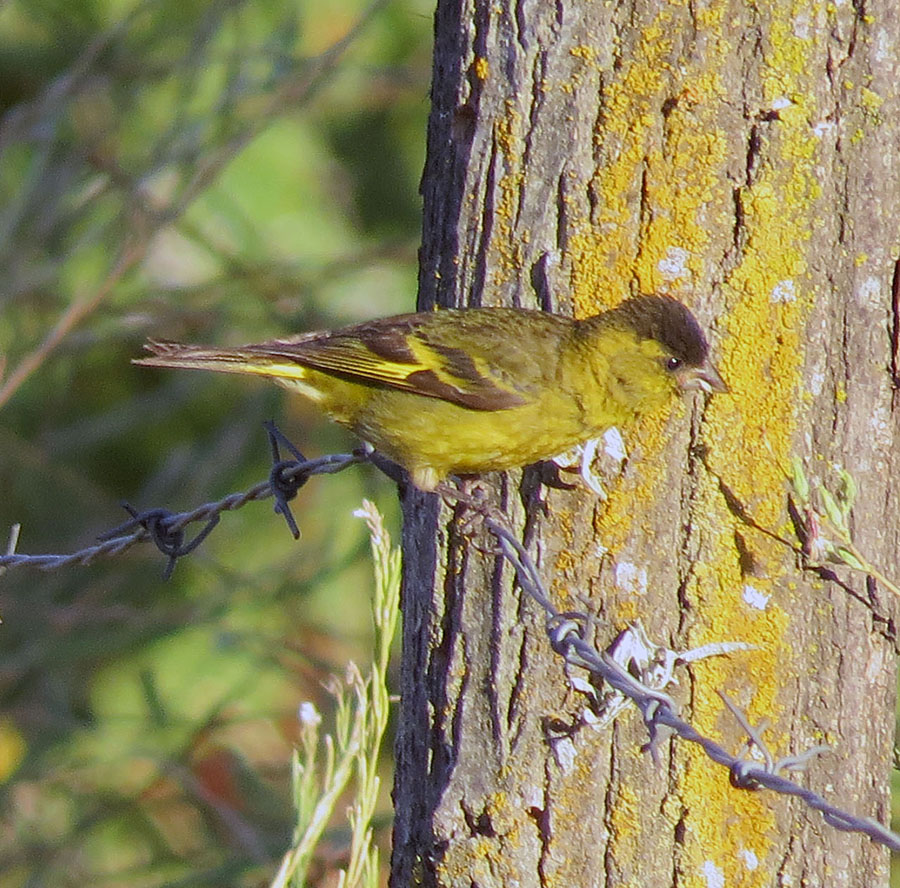
The sheltered gardens of the lodge are a veritable suntrap, and a good place to look for some of the smaller birds – black-chinned siskins often sing from the hedge tops and Falkland thrushes feed on the open grass. On the lawn, beside the lodge is the small museum. Port Howard was occupied by approximately 1,000 troops during the 1982 war with Argentina and much of the equipment left behind after their departure is displayed here. The museum is always open, and the collection gives an idea of what life must have been like during the occupation.
From the museum, the jetty is only a 10-minute direct walk through the settlement, along the track that follows the edge of the harbour. However, you can take your time and spend anything up to a couple of hours wandering around, watching wildlife or just admiring the view. The bridge and ford that cross Howard Stream, a few hundred yards along the track, are a good place to look for black-crowned night herons feeding in the stream. Small groups of black-chinned siskins can be seen in the low bushes on the slope above. Where the stream enters the nearby inlet, a flock of speckled teal are usually feeding in the shallows.
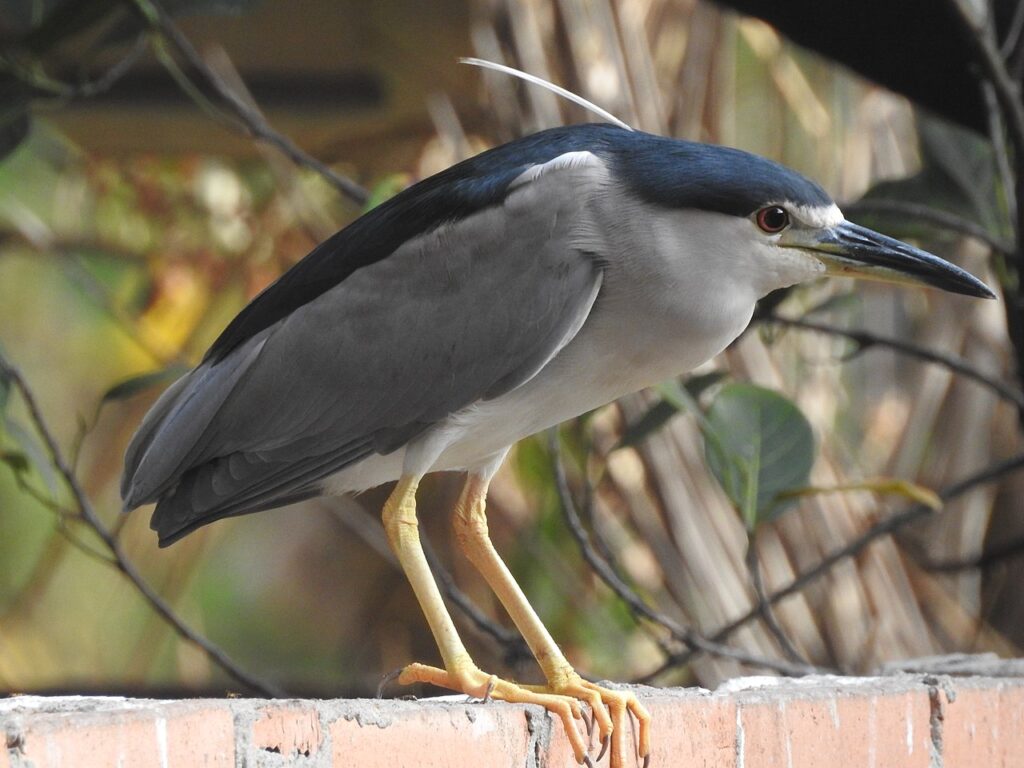
The track winds past the shearing sheds to the quay. The shearing sheds are used several times during the summer, so it is often possible to see how the wool is processed. The track then continues for another 100yds or so before reaching the jetty used by the ferry that links East and West Falkland. From here, it is possible to walk on a short higher track that loops back towards the lodge, passing some of the residential houses, before rejoining the main track before the bridge.
Towards Fox Bay
Another walk takes you northeast from the lodge, along the main road to Fox Bay and the rest of West Falkland. After 100yds, before the newer farm sheds, leave the road and bear right for another 200yds as the track you’re now following rises up towards the airstrip overlooking the settlement. Walk up over the airstrip and along the inlet on the far side of it and, after another 600yds or so, you will reach a small headland and the cemetery where the grave of Captain Hamilton, who lost his life during the Argentinian occupation in 1982, can be found. Bull Stream flows into the far side of this inlet, helping to make a very rich area botanically.
From here, you can retrace your steps or take the track that crosses Bull Stream and return to the main road before heading south back to the lodge, which will take another 15–20 minutes. Alternatively, you can also walk for another 10–15 minutes to overlook Bold Cove and then continue for a similar amount of time up the hill opposite Port Howard – one of the most scenic areas on West Falkland, where there is a cairn to commemorate the 300th anniversary of the first sighting of the Falkland Islands. West from here you can see Port Howard laid out before you and out over the Falkland Sound towards East Falkland on the other side. The highest point on the Falklands, Mount Usborne (705m), is visible on a very clear day.
Beyond the settlement
For those with a 4×4, there are several points of interest that can be reached beyond the settlement. These sites can also be walked, but bank on a full day of walking from the lodge and be sure to carry all supplies you will need with you. The main channel to the south, Port Howard Harbour, is reached by a short, easy walk along grassy tracks by the water or a drive from the settlement. The furthest reaches of the channel are five miles from the lodge. Magellanic oystercatchers and blackish oystercatchers feed along the shore, along with a scattering of two-banded plovers.
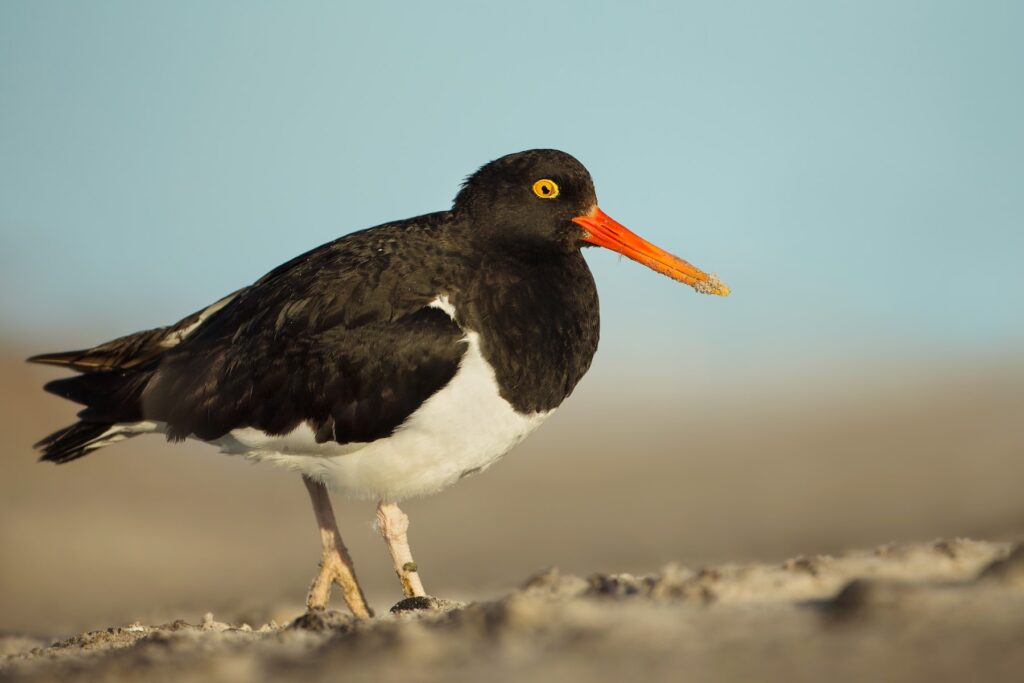
Double River, just over halfway to the far end of Port Howard Harbour, enters the sound in a broad expanse of stone and mud. The views from here are fantastic, looking out from Port Howard Harbour into Falkland Sound. On the return trip, a detour up to Freezer Rocks on the side of Mount Maria is well worthwhile. This line of rocks jutting up through the diddle-dee and ferny vegetation is in a commanding position above the settlement. The views from here are superb – on a clear day you can see over the ridge that is the eastern boundary of Port Howard Harbour, out into Falkland Sound and beyond to East Falkland.
Saunders Island
This island, lying three miles off the northwest coast of West Falkland, comprises 30,000 acres with just over 66 miles of coastline and is operated as one farm. It is historically important in the islands as it was the site of the first British settlement in 1765. The present-day settlement is situated at the base of a range of hills, the highest of which is Rookery Mountain (1,384ft, 422m).
The high cliffs to the north of this range are home to many breeding seabirds, in particular black-browed albatrosses, and rockhopper penguins. These hills are separated from the highest peak on the island, Mount Harston (1,421ft, 436m) by a sandy isthmus known as The Neck. The southwestern part of the island reaches 1,220ft (372m) at the summit of Mount Rees. The lower land between the settlement and Mount Rees has some pools and is the site of the island’s airstrip. The island has become well known as being home to one of the most accessible black-browed albatross colonies on Falkland situated along the northern coasts.
What to see and do on Saunders Island
There is superb walking in the vicinity of both cottages in the settlement. It is possible to book 4×4 excursions from the settlement; both The Neck and the Rookery – the two main sites on the island – are easily reached on day trips from here. Tours out to The Neck are only run for those spending a minimum of two nights in the settlement. At busy times of year on the farm, during shearing periods, for instance, these trips may be curtailed by an hour or so, depending upon other demands on the island owners’ time.
Around the settlement
The settlement contains the main house, the self-catering accommodation, and a mixture of large and small sheds, including the shearing shed that is a hive of activity when the shearing gang are visiting. On an evening walk down to the jetty, visitors will sometimes spot a roosting group of rock shags, and a lucky few have seen a whale or two in the distance in late summer.
A short walk leads you out to the airstrip and then to some pools that have sheltered both silver grebes and white-tufted grebes, a variety of ducks and the occasional black-necked swan. In 1984 the largest of the pools, Big Pond, which is the closest to the settlement, accommodated the largest flock of cinnamon teal that the islands have ever seen when around 20 birds were present. It was thought that they bred there that year. As with any island that lies on the west of the Falklands, there is always the chance that an unusual bird or two will have made its way from South America.
The wildlife colonies below Rookery Mountain
The main attraction of Saunders Island for wildlife enthusiasts is the large colony of black-browed albatrosses that breed along the cliffs on the north coast below Rookery Mountain. The drive out to the colony as part of a day trip from the settlement takes visitors out through the gathering pens before climbing some rather steep slopes to the northeast, through some of the largest areas of Blechnum magellanicum (tall fern) on Falkland before descending to the coast. Depending upon the state of the tide, the track either follows the coastal route or crosses a stream and continues along the beach for a few hundred yards. On the rather low-lying land between this beach and the next, visitors start to see penguins for the first time. Small numbers of magellanic penguins nest on the more arid slopes while gentoo penguins have a small colony a short distance back from the second beach. They can often be seen gathering on the beach in small parties.
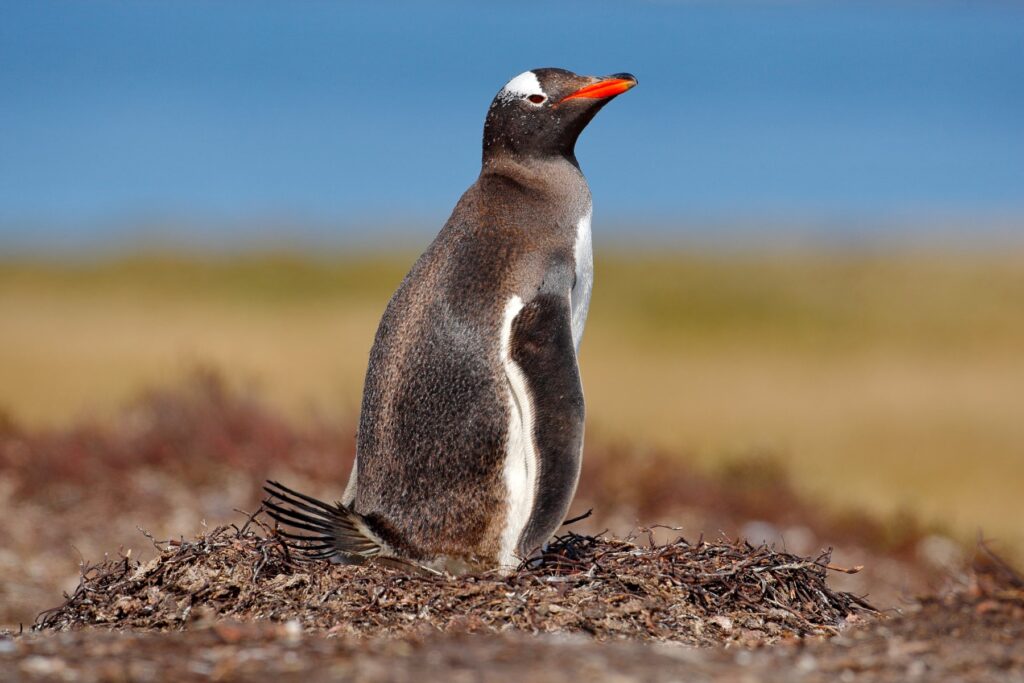
After climbing the steep track at the far side of the second beach, it is approximately a 10–15-minute drive before the black-browed albatross colony is reached. Visitors are usually allowed to remain for at least a couple of hours at this spectacular site. The time spent here will be dictated by the weather and if the owners who are driving you out there have other commitments back in the settlement. Upon reaching the site, the owners usually leave visitors to their own devices, though they usually give a quick briefing before allowing you to explore. A diddle-dee heath runs down from the top of Rookery Mountain to the edge of the cliff.
The albatross colony is situated along the coast on the top section of the cliff. The adults are present between September and April, the eggs are laid during October and fledged young leave the nest between mid-March and early April. The ideal conditions for observing the colony are bright sunshine and an onshore wind. There is then ample opportunity to try and take the ultimate flight shot of these elegant birds as they cruise low over the clifftop. It is possible to sit a few yards from the colony with birds passing low overhead. As with all wildlife, it is advisable to keep a good distance away from these birds (Falklands Conservation’s code of conduct states 6m), so that they are not disturbed and therefore allowed to behave naturally.
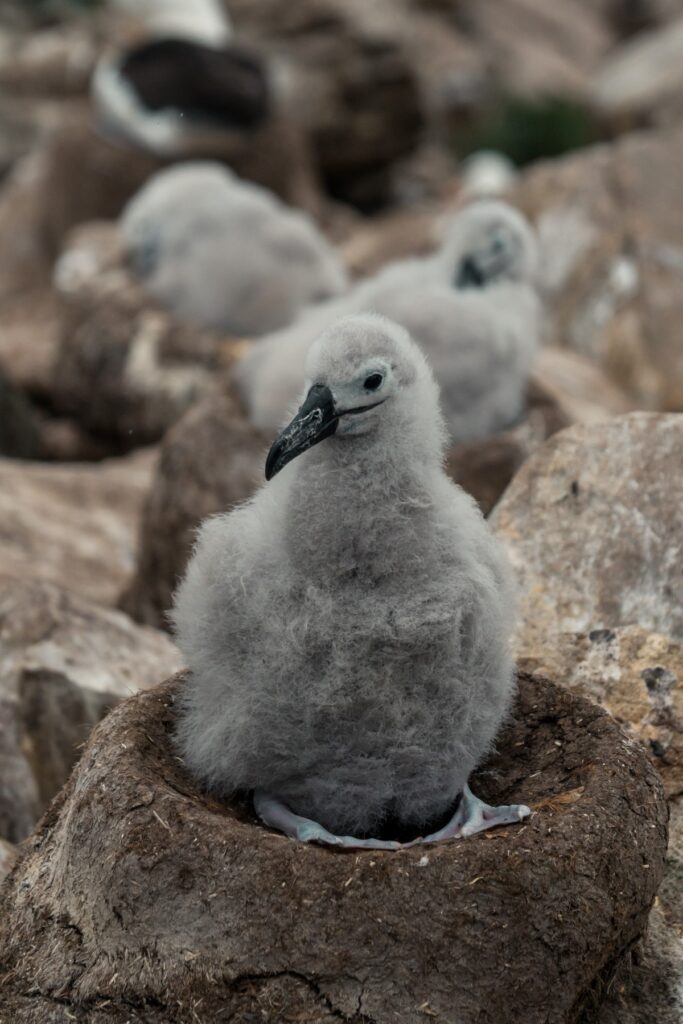
The return trip to the settlement can either follow the same route, if time is limited, or you can follow an alternative coastal track if there is more time. The longer route takes you past the beaches and around a headland to the original location of the Port Egmont settlement. If you park up on the south side of the bay, it is only a short walk of a few yards to see the remains of this historic site. The most visible feature above this shallow valley is the site of the restored graves of the five Royal Marines killed at the end of the 1700s. The largest edifice on the other side of the valley is the remains of a large, stone-built structure lying parallel to the shore. This was once the living quarters and main building for the British forces stationed here in 1766. Visitors can wander around this small site trying to imagine what it would have been like to be stationed here without any modern amenities.
The drive out to The Neck, one of the Falklands’ best wildlife sites, takes an hour or so along the track from the settlement that can be rather rough depending upon the recent weather conditions. This isthmus is only a 10-minute walk – from the foothills of Mount Richards to the southeast and Mount Harston to the northwest. It takes about 5 minutes to cross between the beaches on either side of the isthmus meaning the whole area is very accessible.
The low sandy bank between the hills has been scoured by the wind over many years, making this an ideal breeding site for gentoo penguins and magellanic penguins. The gentoo penguins have at least nine satellite sites for this extended colony. Birds seem to be coming and going from both beaches, which can be easily accessed from the gently sloping grassy inclines either side. In the past, a lone chinstrap penguin was occasionally seen mixing with the gentoo penguins. It was a rather shy bird and would soon disappear upon the arrival of humans. Although this was some time ago, chinstrap penguins can occur in any penguin colony at odd times, so keep a lookout. This flat land is also popular with large numbers of roosting gulls, and small flocks of waders have been noted at times.
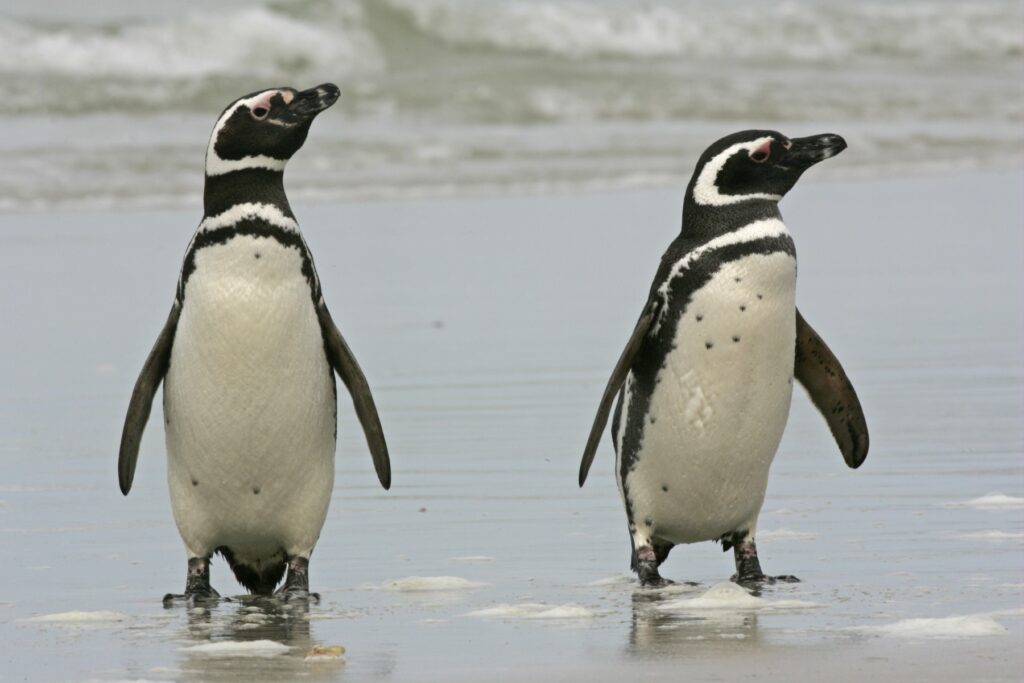
There is no obvious path beyond the king penguins’ territory along the northwest coast. It is worth persevering over some wire fences on the upper slopes. After some 15–20 minutes you will reach a large rockhopper penguin colony on the steeper slopes. As with all grassy cliffs on Falkland, this can be dangerous in wet or windy weather. In the past, this colony has also contained a small number of macaroni penguins – two were present in the austral summer of 2017–18. Large numbers of king shags nest in with the rockhopper penguins so that, apart from the coming and goings of the penguins along their track to the water, there is a constant aerial passage of shags dropping in and taking off from the colony.
Only a short distance away, continuing east along the coast, is the start of the elongated colony of black-browed albatrosses, which extends all the way to the foot of Rookery Mountain. The majority of these birds tend not to fly over The Neck itself but keep out over the open sea. Consequently, although it is still easy to watch the birds on the nest, there are not so many birds to be observed flying by at close range. When up on the higher slopes, either here at The Neck or indeed at the Rookery, on calm days in late summer it is worth keeping an eye out for various large whales, the most likely being sei whale, which can sometimes be seen feeding in the bay.
Sea Lion Island
Sea Lion Island, one of the smallest islands in the Falklands, is one of the most popular destinations for visitors. Lying ten miles (17km) from East Falkland, this island forms a plateau rising to approximately 100ft. It is five miles long and just over one mile at its widest point. From Bull Hill, at the western end, the island slopes gently down eastwards to the open sandy beaches. There are a number of pools on the island. The tussac grass extends around some of the coast away from the cliffs, while inland the habitat is short-cropped turf.
This island has the most accessible breeding colonies of southern sea lions and southern elephant seals. It also has one of the highest densities of breeding birds on the islands. It is one of the best places to see one of the most endangered birds of prey in the world, the striated caracara, locally known as the Johnny Rook.
The sheer abundance of wildlife in such a small area makes Sea Lion Island a must on even the shortest of trips to the Falklands, but especially for those interested in photography: many of the published photographs of Falklands’ wildlife have been taken on Sea Lion Island.
In sheltered spots there is the chance of meeting sleeping sea lions or elephant seals. Upon arrival, visitors are given a rough map of the island from the lodge, on which one area, East Loafers on the southern coast, is marked as being out of bounds as this is the main breeding area for southern sea lions. These are dangerous animals and are best viewed from the top of the cliff. Southern elephant seals, easily seen around the sandy shores of the eastern end of the island, are a different matter as they are less aggressive. However, you must keep a respectful distance from them – the standard advice is to remain at least one of their body lengths from them, and to make sure that they always have access to the sea, never getting between them and the water.
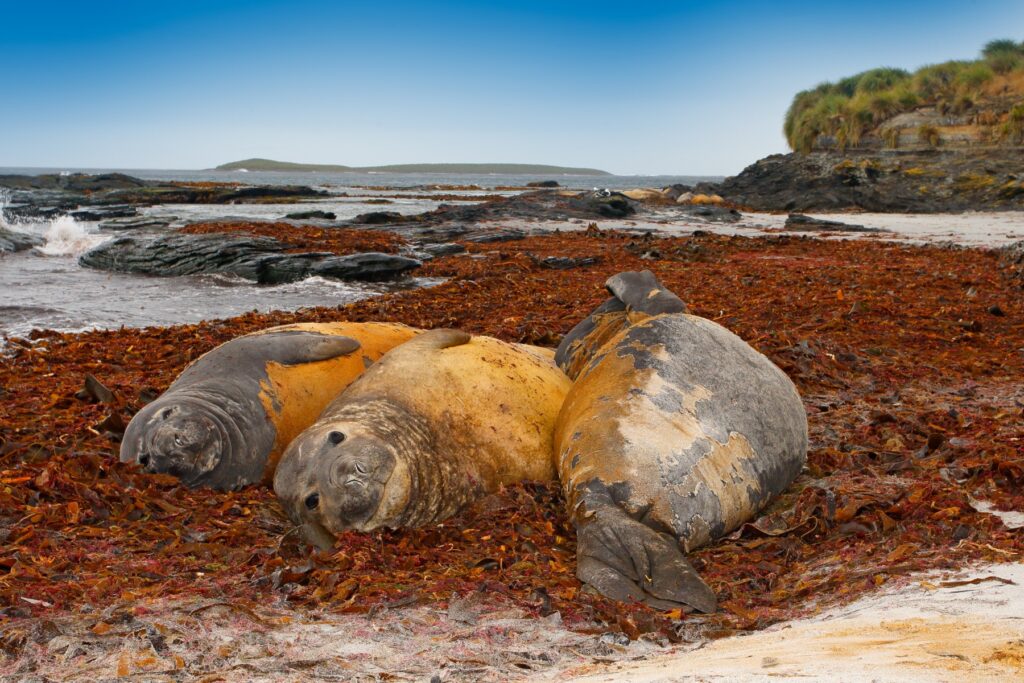
Of the 50-plus species of birds in the Falklands archipelago, two deserve a special mention. The Falkland skua can be very energetic in defence of its territory, by dive-bombing any intruder. Most of the skuas nest in the open grass at the western end of the island, with a few nesting just off the main track from the lodge towards the eastern end of the island. These large birds can be seen on the nest and are best admired from a certain distance. This distance will vary from bird to bird, but when they start to sit up and take notice of you, it is the time to find an alternative route. The other species is the striated caracara – these beautiful, inquisitive birds of prey have a strong liking for shiny or brightly coloured objects so when they’re in the area, it is a good idea to keep a close eye on your possessions.
Walking around Sea Lion Island on the open, grassy turf is fairly undemanding but, as everywhere, there are some essential ground rules. At the lodge, and on the introductory tour, advice is given regarding the ground rules for the welfare of the wildlife. This enables the visitor to approach both animals and birds safely, without causing the wildlife any distress.
Cow Point, North East Point and Elephant Corner
It is possible to explore the eastern end of the island before lunch. The closest beach, Cow Bay, can be reached by cutting across the field to the north of the lodge and continuing down a shallow valley through the tussac grass towards the sand. Many magellanic penguins nest in this area, including one pair often seen using a burrow almost under one of the old stiles. A walk westwards along the beach should find upland geese and kelp geese, as well as several noisy groups of magellanic oystercatchers.
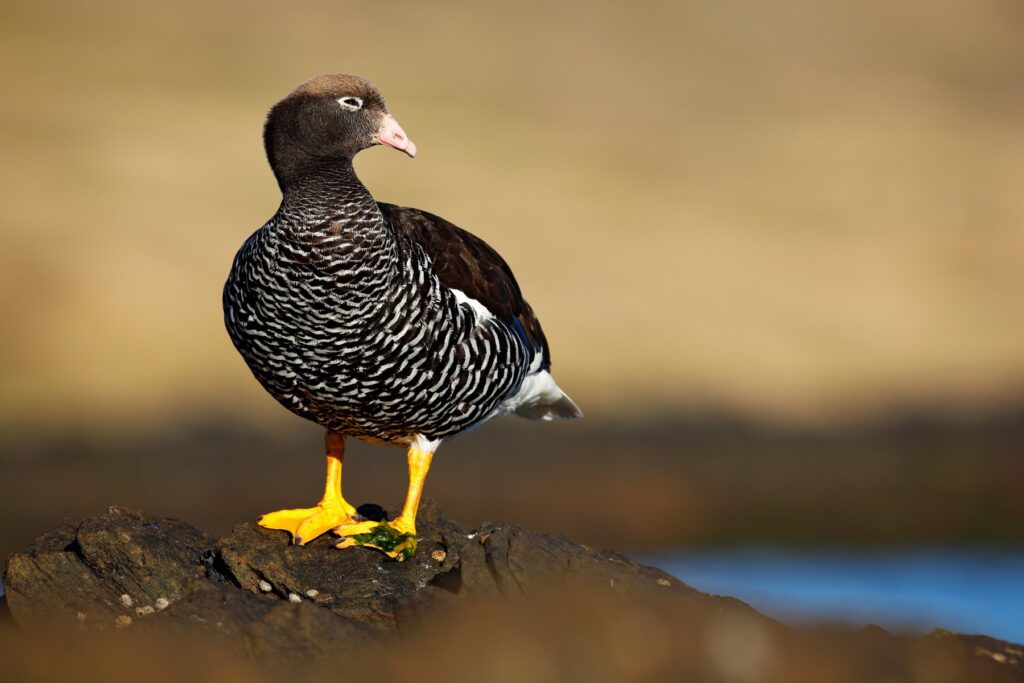
Turning around and heading east, one can walk along the sand towards Cow Point. The sand does disappear in places and it becomes necessary to walk over flat rocks. Two stretches of large boulders, around 100yds along the beach, can be difficult to navigate so take care. This area has many small birds, including Cobb’s wrens, popping in and out of the stones at your feet, while elegant dark-faced ground-tyrant catch flies at the top of the beach. From Cow Point, small numbers of gentoo penguins can be seen porpoising their way back to the shore through the banks of offshore kelp. These penguins are making their way to the long sandy beach that stretches eastwards from here. The large gentoo colony is a dominating presence at the top of the beach and is clearly designated, a wire fence ensuring that the penguins are not disturbed. It is always worthwhile looking at this colony to see if there are any king penguins present.
Behind the sand beach, shallow temporary pools which form when high tides coincide with windy days to push water into this area, can sometimes be seen. When the pools are present, many small wading birds can be found feeding in them. Along with the two-banded plovers, there are often many white-rumped sandpipers that have come here from their North American breeding grounds. Continuing east for less than 10 minutes to the far end of the beach, there is a small colony of southern giant petrels.
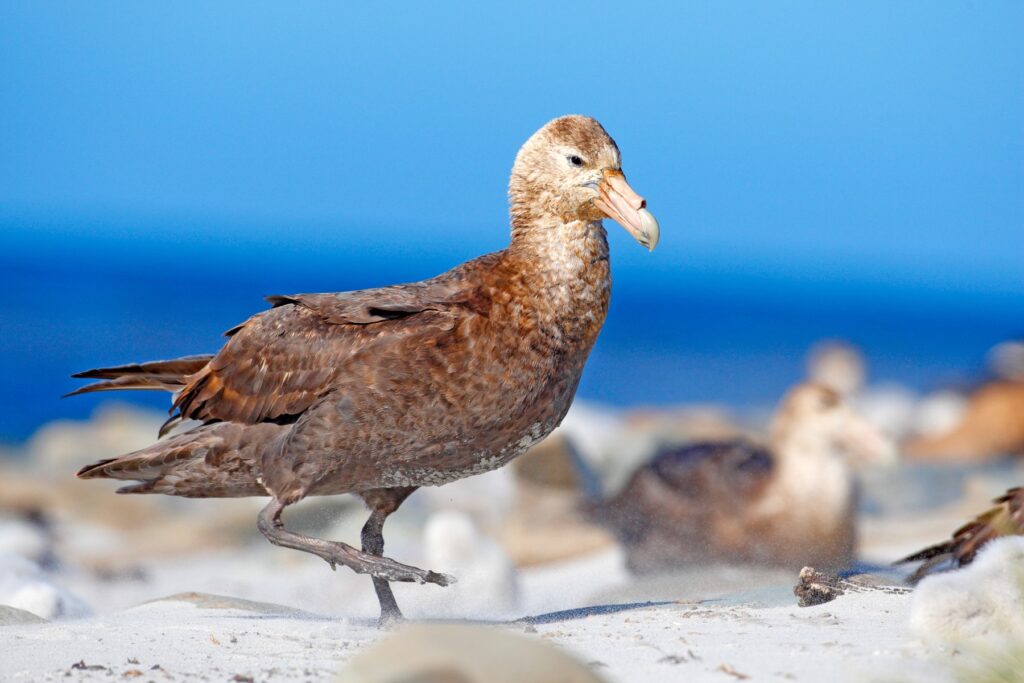
A few minutes’ walk south from the giant petrel colony takes you to a beach that both magellanic oystercatchers and blackish oystercatchers can be found nesting at the top of. As their nests are well camouflaged, walkers must watch out for displaying adults and thus avoid the nesting sites. The beach is also another favourite haul-out site for elephant seals, with one favoured site at the eastern end of this beach, and even more found at the western end, a 20-minute stroll away.
Just beyond the big haul-out site, you can walk around 100yds on to some grassy slopes (a super place to watch both upland geese and ruddy-headed geese), behind which there is a small bay, the aptly named Elephant Corner. Here, visitors can push through the tussac grass on the path of least resistance in order to reach a low promontory in the middle of the cove. The elephant seals can be viewed in safety from here and it is an excellent spot for photography.
Stanley is probably the smallest and most remote capital city in the world. The official existence of Port Stanley began in July 1845, when the islands’ capital was moved from Port Louis to an area originally called Jackson’s Harbour. It was situated on a north-facing slope in order to face the sun throughout the year. It grew dramatically during the Californian Gold Rush in the mid 1800s with this boom lasting until the 1890s. Subsequently, Stanley has continued to be the commercial centre of the islands and the main port of access.
A wide range of architectural styles prevails in the city, ranging from the magnificent brick-built Christ Church Cathedral, to Jubilee Villas – an imposing terrace of four tall, red-brick houses with large bay windows, to the hospital and school with their colourful roofs and white-clad exterior. Upland geese and Falkland steamer ducks frequent the waterfront, while turkey vultures and kelp gulls glide overhead. It is also one of the few places on the islands where house sparrows, introduced during the 19th century, have remained plentiful. Stanley is where many Falkland holidays start and finish, and therefore it has a good selection of accommodation and tour operators able to cater to visitors’ tastes and interests.
The Historic Dockyard Museum and around
A good place to start is at the new Historic Dockyard Museum situated in the old dockyard on Ross Road. The perfect starting point for a history lesson about Stanley, the museum houses information ranging from the first settlers up to the present day. Exhibits cover every aspect of life in the Falklands including the Falklands War and other conflicts, camp life, shipwrecks and natural history. There is a very poignant video playing in one room, showcasing interviews with islanders about their experiences during the war. To see it all takes the best part of 2 hours, with some visitors coming back for more than one visit.
The main museum building is situated in an old store, one of the oldest buildings in Stanley, which dates back to 1843. The site beyond once included storerooms, workshops, a jail, a magazine (used for storing munitions) and a smithy, and many of these buildings have been restored to their former glory as part of the museum’s exhibits. For those seeking refreshment, the Teaberry Café is on site.
Liberation Monument
The memorial just opposite the Historic Dockyard Museum is the Liberation Monument. Paid for by public subscription and erected by volunteers, the monument was officially unveiled on 14 June 1984. The military personnel who gave their lives to liberate the islands are remembered on the surrounding wall. Liberation Day, 14 June, is marked in the islands each year by a public holiday.
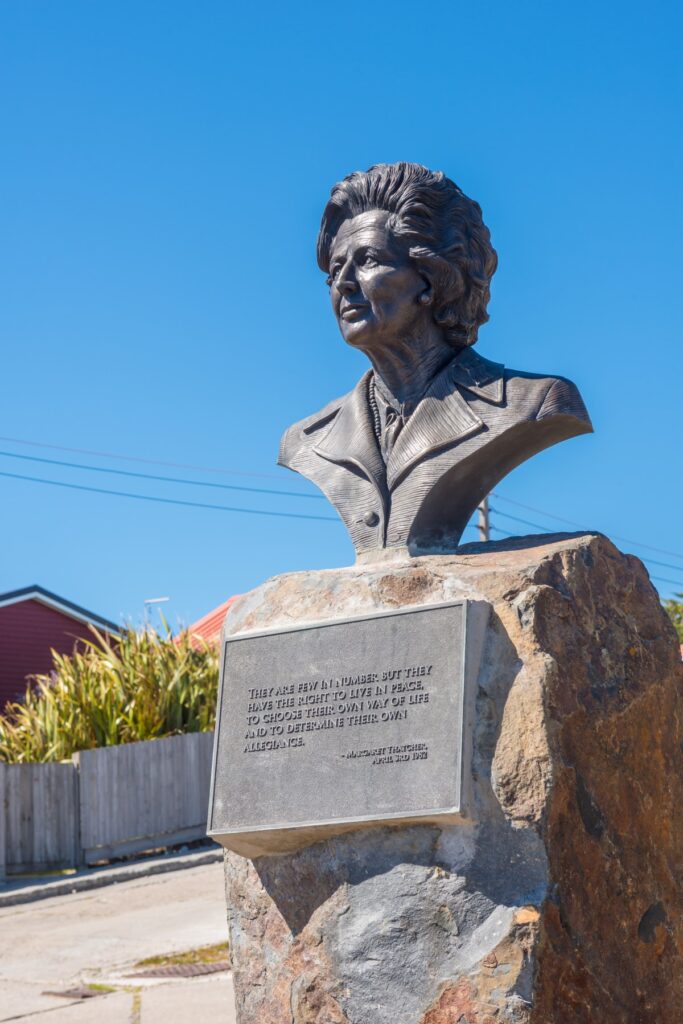
Some 50yds away is the bust of Margaret Thatcher, prime minister at the time of the Argentine invasion, and largely held responsible for the decision to send the task force to regain control of the islands. The Secretariat, just behind these memorials, houses the islands’ administrative offices and treasury buildings. Adjacent to these buildings is Cable Cottage, the Attorney General’s Chambers, which housed the Stanley end of the telegraph cable that linked the islands to Montevideo in the early 1900s.
Government House
Just below the community school playing field is a long-angled driveway that leads up to Government House. Originally built in 1845, this building has been regularly extended, improved or just generally altered over the years. Every governor and his wife seem to have added their own touch to the building. Each spring, when the gorse hedges are in bloom, this is a very picturesque situation in the lee of the macrocarpa trees. The conservatory at the front of the house is home to one of the most prolific grapevines on the islands.
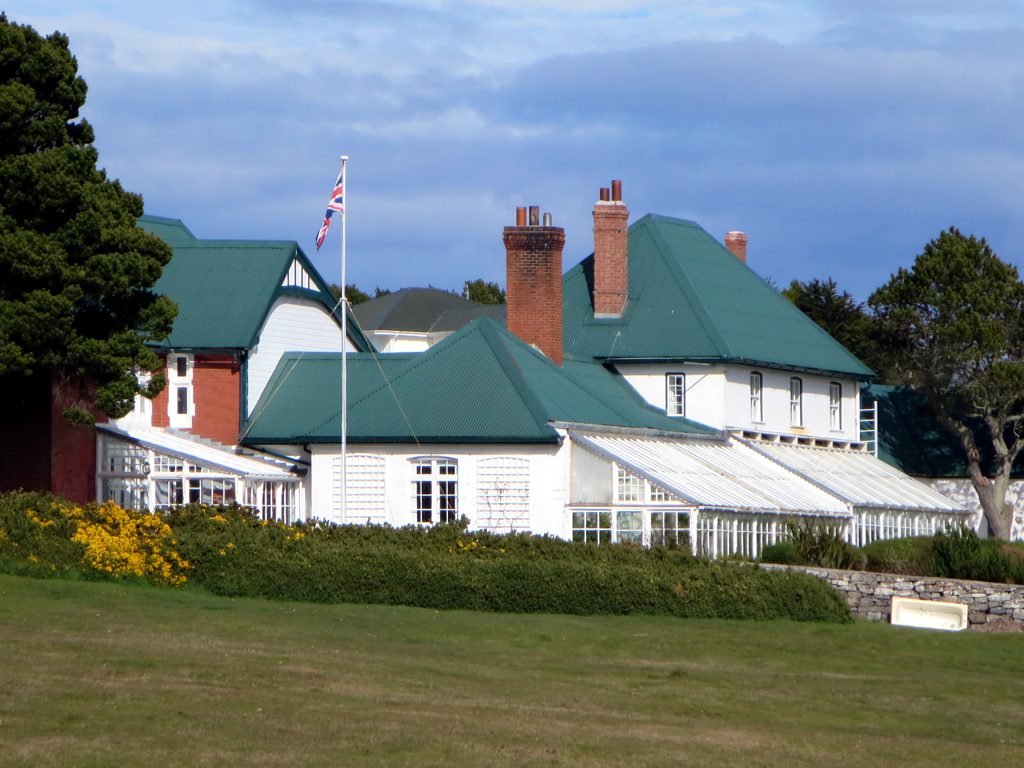
The house itself, though not open to visitors, is full of all manner of memorabilia from throughout the ages. Outside the west entrance are a pair of brass guns cast in 1807, and elsewhere there is a harpoon gun that was presented by a South Georgia Whaling Station and a shell that is supposed to have come from the German cruiser Leipzig . The bullet holes still visible in the walls mark the most dramatic period in the history of this building, which suffered during the invasion and subsequent recapture of Stanley from the Argentinians. The large trees are a good place to look for some of the smaller birds such as black-chinned siskins and the occasional swallow blown in from South America.
1914 Battle Memorial
This monument commemorates the Battle of the Falklands fought on 8 December 1914, in which the British Squadron under the command of Vice Admiral Sturdee destroyed the German Squadron under Vice Admiral Graf Von Spee. A public holiday on the Falklands was declared on this date and every year there is a parade and a ceremony, which includes a display by the Royal Air Force and the Royal Navy. The memorial was paid for by public subscription and was first unveiled on 26 February 1927.
Between SURE’s headquarters and the memorial is a memorial wall built in 2014 to commemorate the centenary of the two battles at sea in World War I. There are three plaques on the wall, detailing information about the two battles and the people involved. There are also a couple of benches and a pretty flower garden – this is a quiet place to sit in the sun out of the wind.
Christ Church Cathedral
Christ Church Cathedral must be one of the best-known, most-photographed buildings on the islands. It is the southernmost cathedral in the world and for part of its history was the main cathedral for the missionary diocese of South America.
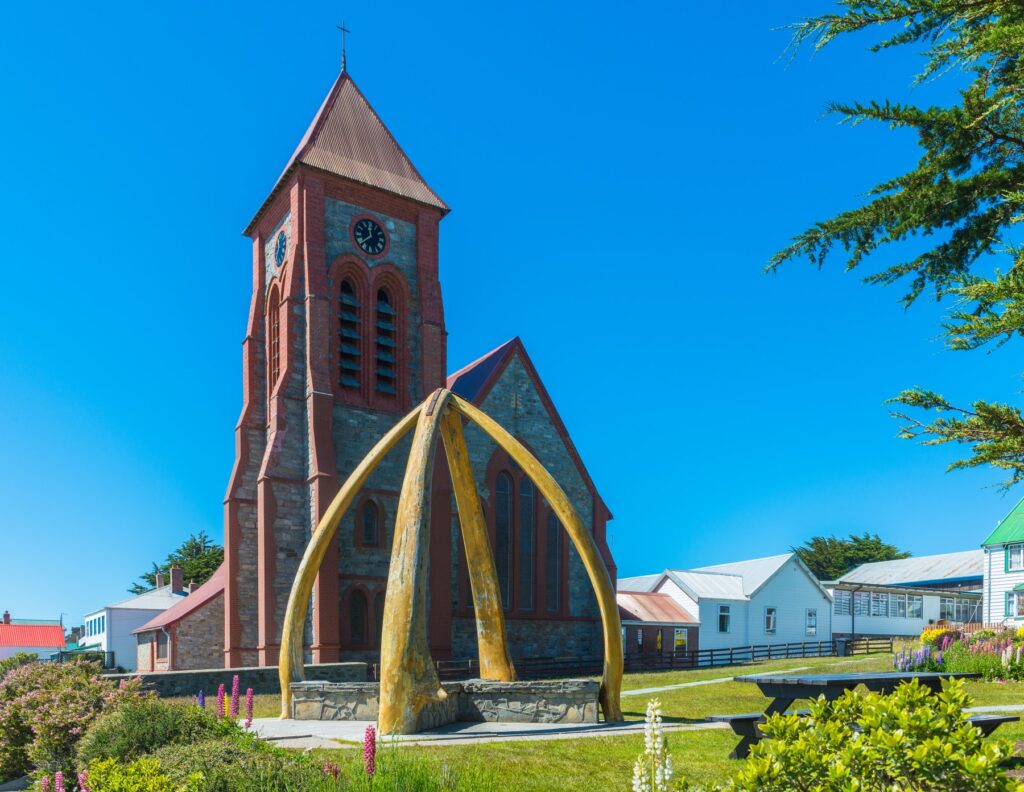
Consecrated in 1892 and finished in 1903, it has remained in use to this day. The whalebone arch, situated next to the cathedral and made from the jawbones of two blue whales, was presented to the islanders in 1933 by whalers from South Georgia. The arch and the cathedral were renovated in 1991.
Jubilee Villas
About 300yds further on, at the head of the public jetty in front of Jubilee Villas, among the oldest buildings in Port Stanley, is a small plaque commemorating the visit of HRH Prince Alfred, Duke of Edinburgh in 1871, the first royal visit, and the visit of the present Duke of Edinburgh in 1957. The easternmost building is now the offices of Falklands Conservation, a non-governmental environmental charity, which is involved with a wide range of research and advisory roles concerning the islands’ wildlife.
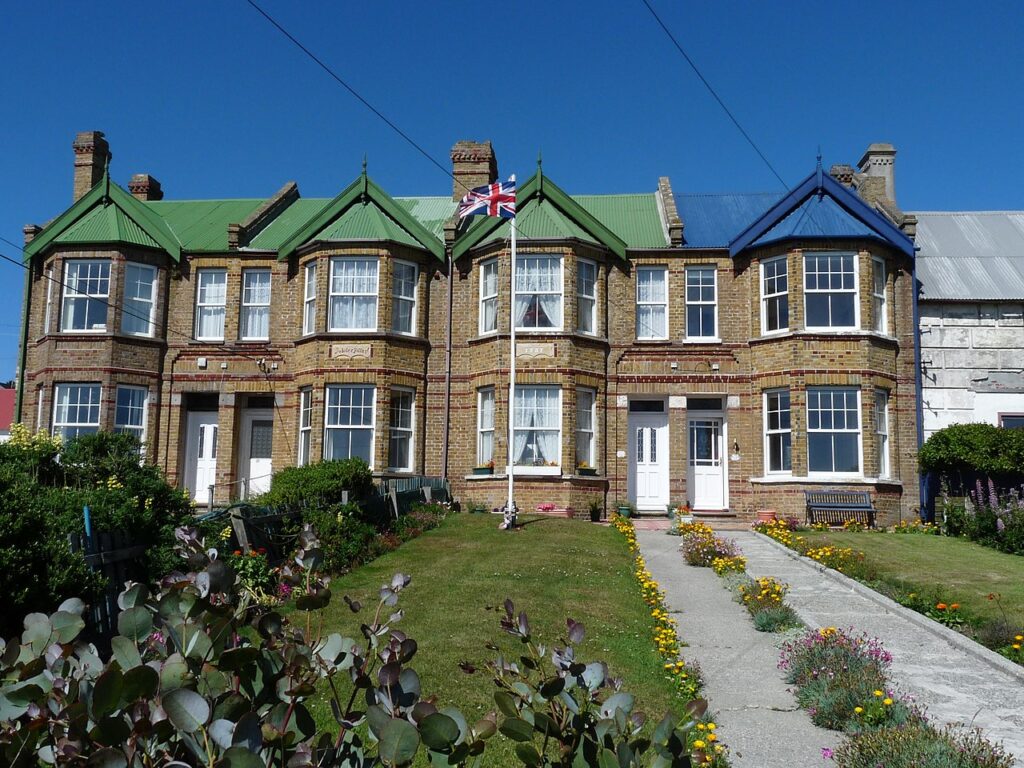
The ruins of the William Shand are best seen from the public jetty looking towards the East jetty. This barque, built in Greenock in 1839, visited Stanley on the outward journey from Liverpool to Valparaíso in February 1859, and returned to the islands after a severe battering as she tried to round Cape Horn two months later. She was condemned and ended her days in Stanley.
Sapper’s Hill
A superb view over Stanley can be had from Sapper’s Hill, which overlooks the town from the west. From here you can see Stanley laid out before you, over the harbour to Port William, and out over the South Atlantic Ocean to the south. This viewpoint is reached by heading west towards Government House from the Historic Dockyard Museum, but turning south down Darwin Road, following it to the Stanley– Mount Pleasant Airport Road for half a mile and then turning on to the track that leads up the hill for a few hundred yards.
On the way back, you can take a different route by following the Stanley Bypass and turning left into Dairy Paddock Road before soon reaching one of the most unusual gardens in Stanley. In the gardens, next to the sign, ‘say no to whaling’, are the impressive skulls of killer and sperm whales along with a metal sculpture of a whale and a harpoon gun from the whaling days. By continuing down Dairy Paddock Road for another 100yds, you come to Pioneer Row, where some of Stanley’s best-preserved older houses can be found.
Volunteer Point
Volunteer Point is named after the Volunteer , a ship that visited the Falkland Islands in 1815. This privately owned nature reserve is on a narrow strip of short grass that connects East Falkland to the headland of Volunteer Point itself and is bordered by the two-mile-long Volunteer Beach to the north and by Volunteer Lagoon to the south. The wardens’ house is at the western end of the grassy area, while the king penguin colony is at the eastern end.
This colony is one of the highlights of any visit to the Falkland Islands – it is the largest colony of this species on the islands and is still increasing. There are two additional species of penguin, and many other birds breed in this fabulous scenery. As you near the site on the tracks from Johnson’s Harbour, the whole area opens up spectacularly before you, revealing the lagoon, penguins and beach.
King penguins
The main penguin colony does move slightly from year to year, but is always located between the valley and the southern boundary fence. These birds are used to the presence of visitors throughout the year but a distance of 7.5m must be respected. It is possible to get close views of the birds by sitting beside their main routes to the sea and waiting for them to come and inspect you. The majority of the inactive birds in the main group are probably incubating their huge, single egg. This egg is sometimes visible on top of the penguin’s feet as it awaits incubation, but is hidden when the bird sits down. The penguin’s stiff tail feathers help prop the bird upright when it is incubating or roosting. Penguins can also rest by lying prone on the ground but seem to prefer to remain upright, presumably as this gives a better chance of spotting any approaching predators.
The air around the rookery is full of soft piping noises through the summer. This sound is the young calling to their parents. When just hatched these youngsters are small enough to stay hidden under the folds of their parents’ skin, especially on cold windy days, but as they get larger, or on warm days, their heads peep out just above the parents’ feet. Chicks, which have grown too big to fit under the parent birds, still try to hide by pushing their heads into their former haven. They look a rather comical sight, only their head hidden, the rest of the body exposed to the elements. As they grow, the chicks grow a very fluffy, brown, downy coat to protect them from the cold.
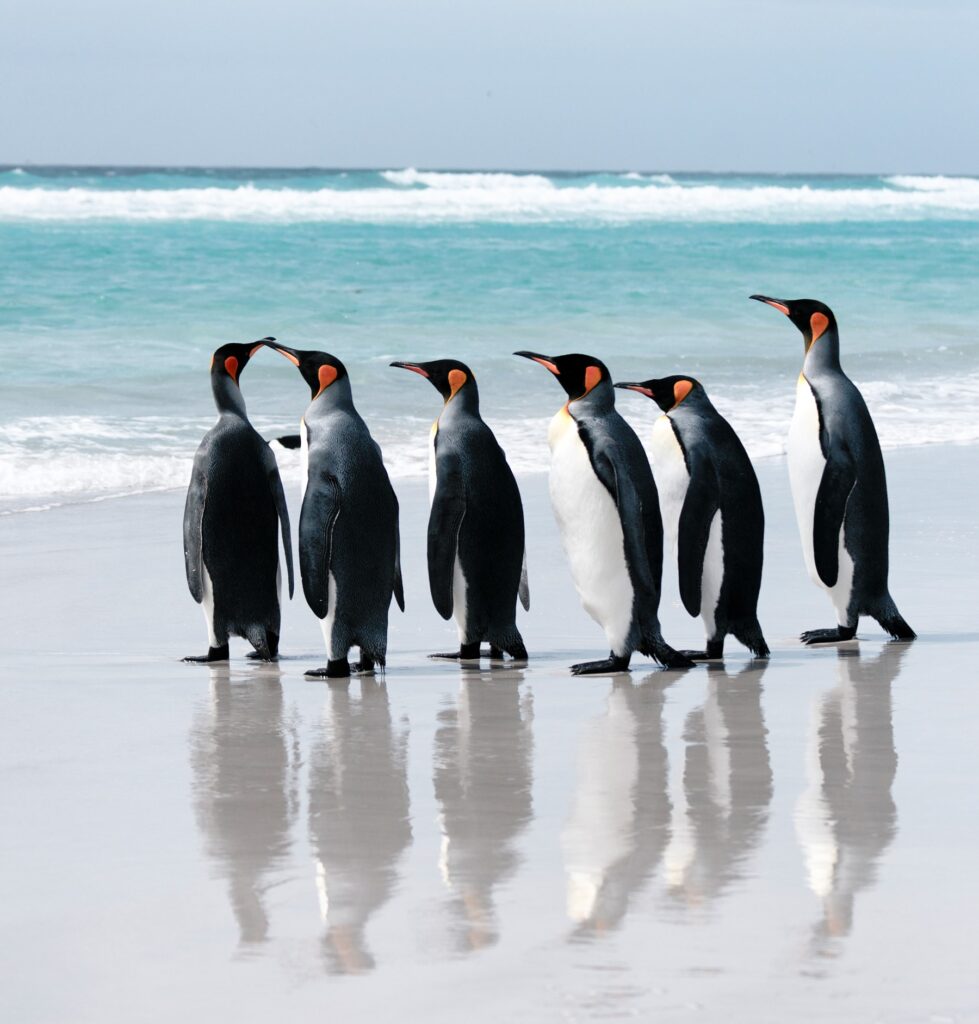
The main breeding activity takes place around the principal flock, but there are usually several smaller groups nearby. There may be some young birds in these satellite groups, but they are usually non-breeding adults. Males seeking a mate wander around the main group, adopting a very exaggerated strutting walk and batting each other with their flippers. Owing to their staggered breeding cycle there will always be some pairs starting earlier than others, but generally birds will be incubating between November and January with small young being visible from early in the new year until late February, after which they will be much easier to see as they are too big to hide under their parents.
The majority of the birds return to the sea at Volunteer Beach. Some walk in the other direction, to the lagoon, where they can be seen washing and splashing about in the shallows. The low banks above the small beach on the edge of the lagoon make a good vantage point for observing these birds. Sometimes they can be seen swimming in the shallow water and the graceful speed of their movements is in stark contrast to their upright waddling gait on land.
Gentoo and magellanic penguins
King penguins constitute the main attraction of Volunteers, as the sanctuary is known on the island, but they are not the only penguins breeding prolifically on this grassy bank. Two colonies of gentoo penguins occupy the lagoon side of the bank a short walk from the king penguins. The number of colonies has varied over the years. Sometimes two groups of gentoo penguins will merge, while in other years they will remain apart, but the overall number of birds does not vary significantly, with around 1,000 pairs using this site in recent years. By late summer all the young will have been gathered into crèches in the middle of the colony for protection from predatory birds. It is quite a sight when the young race after their returning parents to beg for food. The adult’s purpose is twofold: it wants to teach its offspring to feed and also wants to ensure that it is nurturing its own young and not its neighbours’.
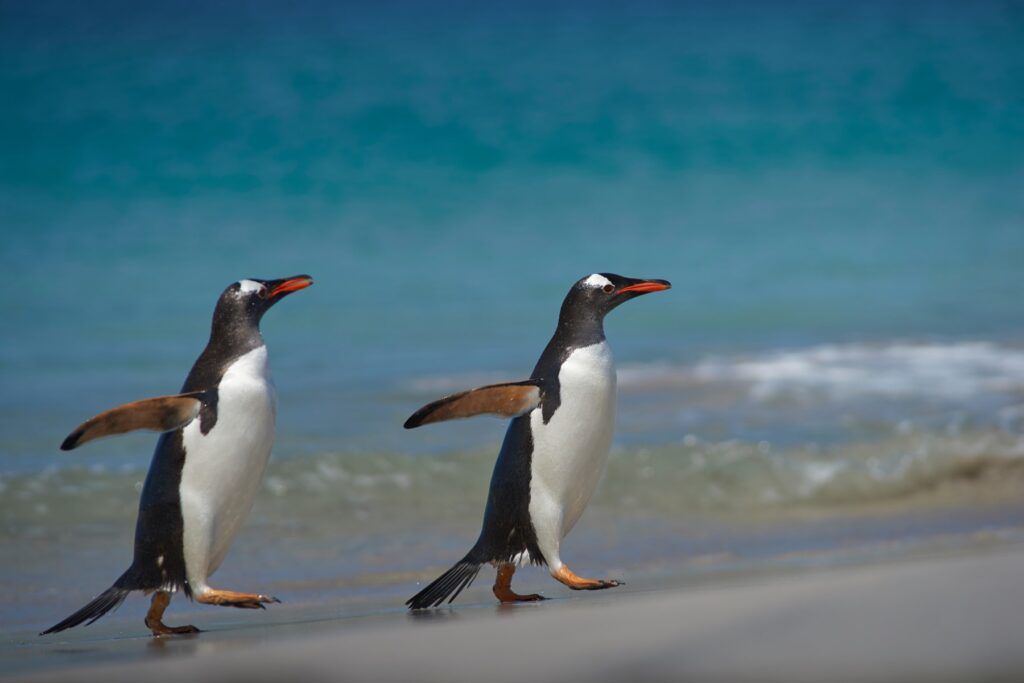
Magellanic penguins prefer the beach side of the bank where the drier, sandy ground is much more suitable for digging burrows than the wet, peaty ground. The bank above the beach is, therefore, riddled with both used and unused penguin burrows.
Other flora and fauna
After the penguin colonies have been visited there is plenty more to see. The flora is dominated by grasses thanks to the grazing birds and sheep. Some of the wetter valleys are full of gunnera , with its inedible red berries hidden under the leaves in late summer. The most colourful flower is the sea cabbage with its silvery white leaves, fluffy to the touch and topped by bright yellow flowers at the height of the summer. The seeds formed during January are a preferred food of the islands’ smallest finches, the black-chinned siskins. The sea cabbage grows above the shoreline, anchoring the shifting sands.
In the lee of the sea cabbage, small groups of waders gather in late summer, the majority of which are white-rumped sandpipers that have come from North America to winter on the islands. The other birds are the resident two-banded plovers, which breed above the high-tide mark, so it is sometimes possible to find some of the young racing from one clump of sea cabbage to the next.
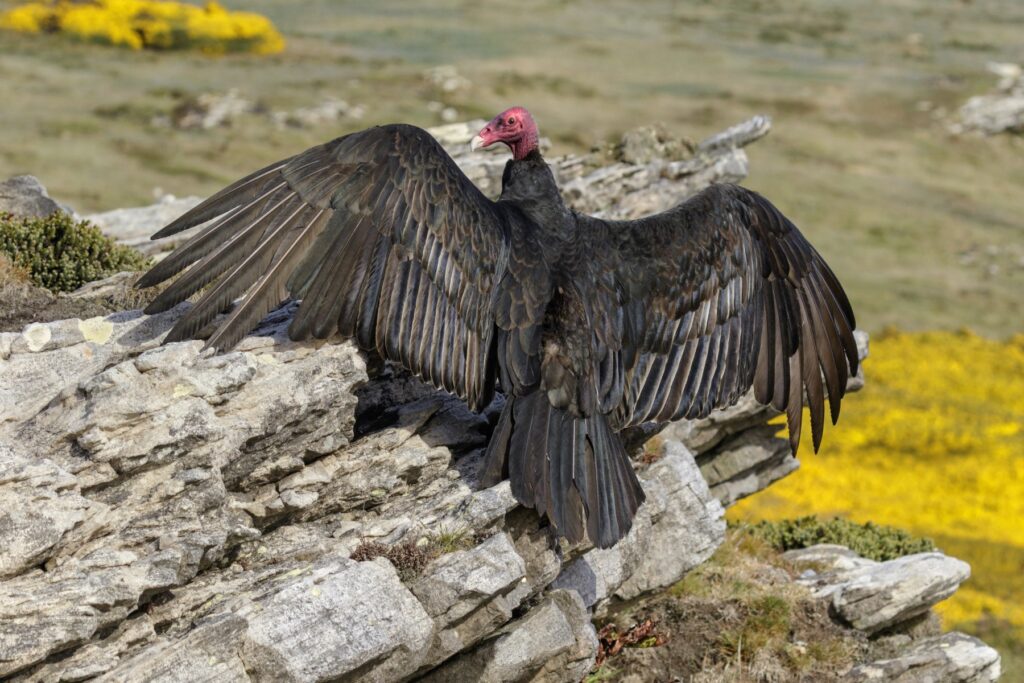
The second most frequent species, after penguins, are geese. Upland geese and ruddy-headed geese frequent all grassy areas. By late summer they have gathered into large family groups. Habitually the males gather together flocks of juveniles, irrespective of their parentage or age. According to one theory, this behaviour suggests that the males use unrelated offspring as an avian shield for their own goslings, the probability being that any predator will not detect their young. The predators here are mostly avian; turkey vultures and variable hawks are the most numerous and can be seen around most penguin colonies, while peregrine falcons circle high over Volunteer Point.
The small islets beyond Volunteer Point, although out of sight at the far end of the reserve, are the haunts of fur seals; visitors are not allowed to access these areas, but the seals can sometimes be seen zooming through the surf on to the beach. Elephant seals have been recorded on some of the sand beaches but, like fur seals, they often pick sites that are not readily accessible to tourists.
West Point Island
West Point Island, owned by Roddy and Lily Napier and run as a farm, is not one of the bigger Falklands islands. Covering 3,630 acres, it is five miles long and just under two miles at its widest point. The population is just two, plus Bosun the dog. Despite its size, there is more than enough for walkers and naturalists to see here – whether in a few hours on a stop from a visiting cruise ship, or for a full day when visiting from nearby Carcass Island.
The island is renowned for its huge colonies of black-browed albatrosses on its western side, on some of the most spectacular cliffs in the archipelago. The area around the small settlement, where the island’s buildings are, is at its most colourful in springtime when the densely flowered gorse is in bloom. Sheep are still kept here, but tourism is the source of most of its income. The highest point on the island is Cliff Mountain at 1,250ft, while nearby Mount Misery stands at 1,211ft above the albatross cliffs. The channel, located at the narrowest point between West Falkland and West Point, is Woolly Gut, which is strongly tidal before it opens out into West Point Pass to the southwest.
What to see and do on West Point Island
Afternoon tea.
As on the neighbouring island of Carcass, the welcome and afternoon tea provided at the farmhouse for cruise-ship passengers are some of the highlights of a visit to West Point. Even though the main aim of landing on the island is to visit the seabird colonies, the concept of tea and cakes should be high on your agenda, along with taking a look around the settlement.
The birdlife of West Point, although not as varied as that on Carcass Island owing to the introduction of cats, rats and mice years ago is still present, only less abundant. It is now believed that cats have been successfully eradicated and there has been some recent work to remove the rat population around the settlement resulting in an immediate increase in the number and diversity of smaller birds. Some, such as black-chinned siskin, Falkland thrush and grass wren survived the higher rat numbers quite well by breeding on cliffs inaccessible to rats. These birds can be heard singing on spring mornings with others now being noted on a more regular basis.
Tussacbirds are now also being seen regularly and there have been recent reports of possible sightings of Cobb’s wren which is very good news. The lush garden and vegetable patch, close to the farmhouse, are good places to see some of these species. Male long-tailed meadowlark, known locally as military starling, look particularly fine when perched on flowering gorse bushes. Their red breasts stand out from a long way off.
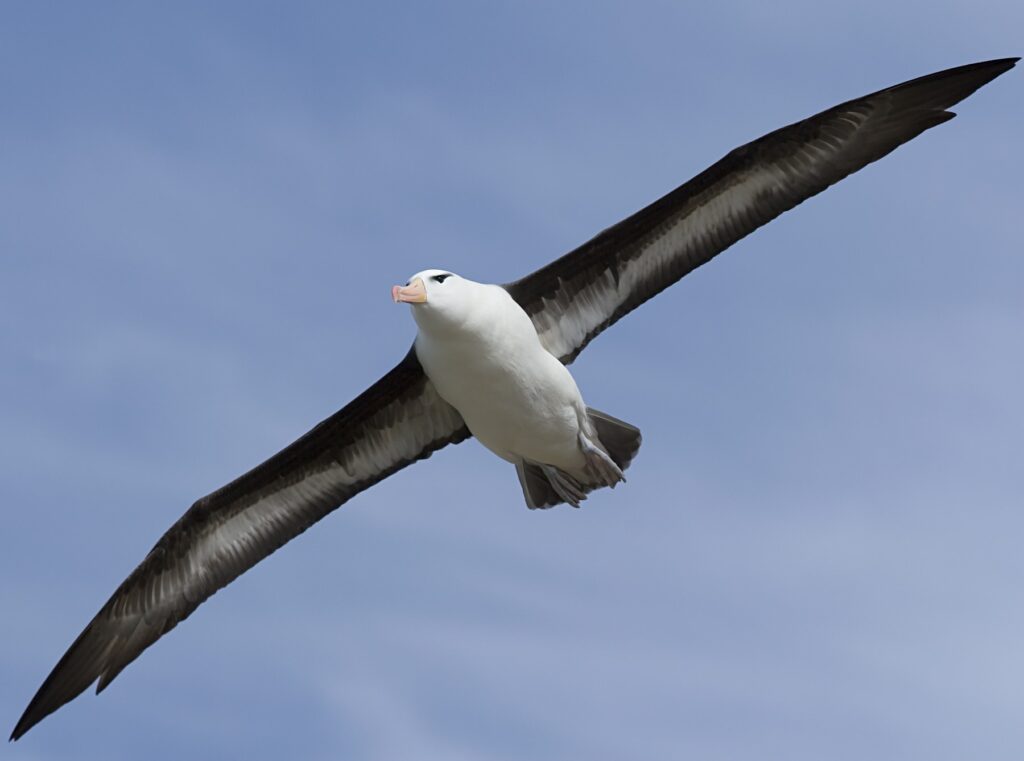
The major attraction is the impressive black-browed albatross colony located on the western side of the island. From the settlement, it is about a 5-minute drive to the colony – the managers will be able to give you a lift. Alternatively, the colony is an easy 30–40-minute walk along a grassy track that is marked by red-topped stakes and passes through a series of fields before reaching the inner edge of the tussac grass that grows on the island’s periphery, at a safe distance from the local sheep.
The birds situate their mud-pot nests on the top of the slope, so that they can land and take off without too much difficulty. With a wingspan of over 7ft (2.13m), they need plenty of room to get to and from their nest site in safety. The main path leads down to the colonies for a few yards before splitting. You can then follow either path to loop around the colony, walking from one end of it to the other. It is therefore possible to take a circular walk and get wonderful views only a few feet away from the birds. As long as you stay on the path in the tussac the birds carry on with their daily activities without seeming to be concerned by your presence. In the past, some of the albatrosses in this colony were ringed as part of a research project to determine the longevity of the species, where the albatrosses went after leaving the island and if they returned here to breed.
The waters around the island are favoured haunts of Commerson’s dolphin. They follow many of the boats into the harbour, often playing in the bow wave as the ship enters the harbour.
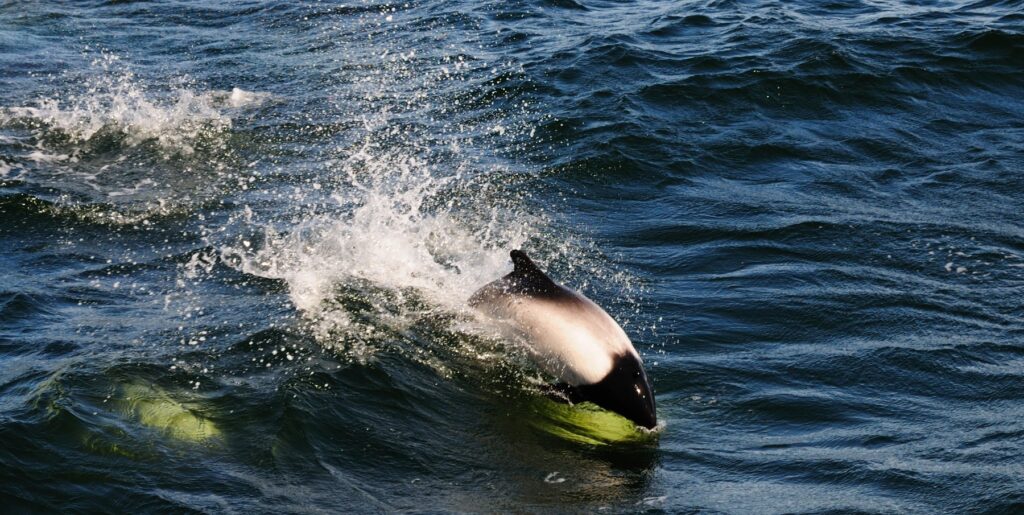
From the westward side of the island it is possible to see the occasional fur seal swimming close inshore, and on very calm days some of the great whales, most commonly sei and southern right whales, have been seen from many locations around this island.
Related books
For more information, see our guide to the Falkland Islands :
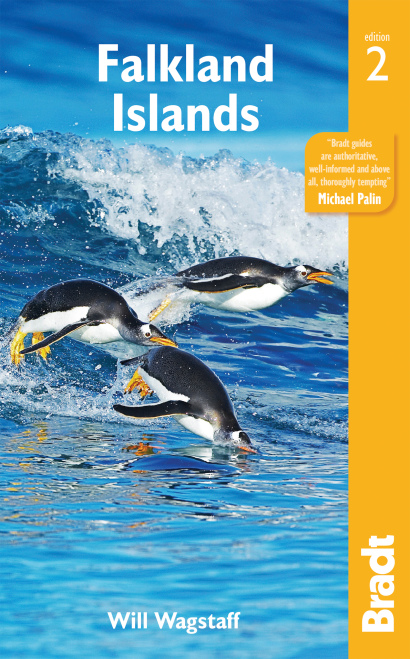
Related articles
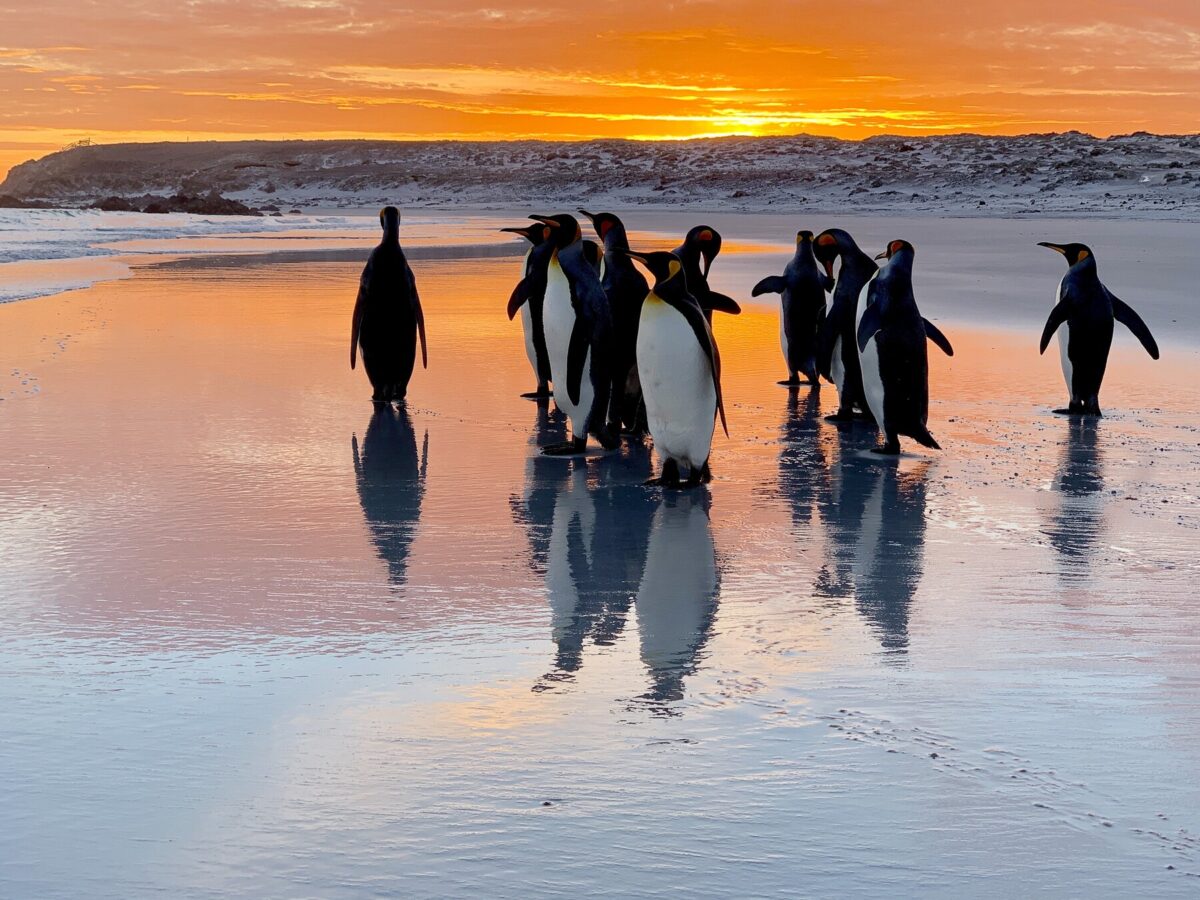
Photography in the Falkland Islands
The Falklands offer perfect opportunities for professional and amateur photographers alike.
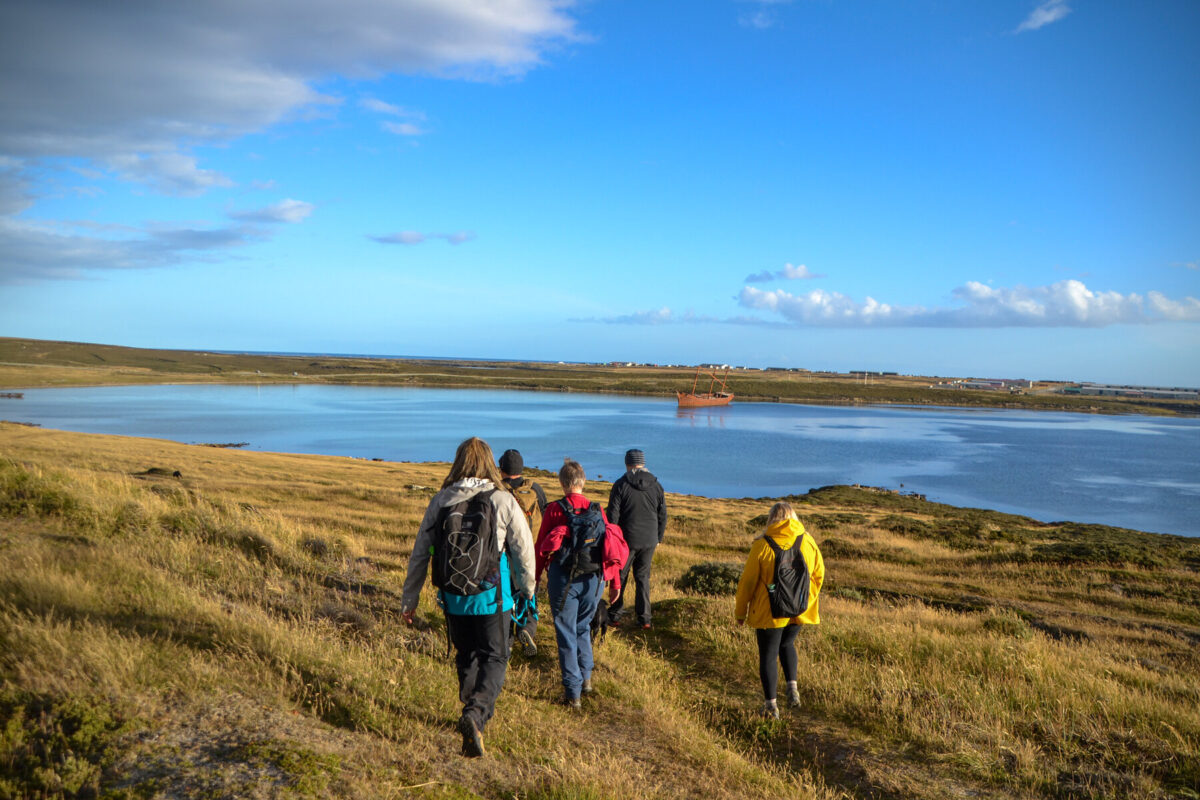
The best walks in the Falkland Islands
Breathe in the glorious unpolluted air.
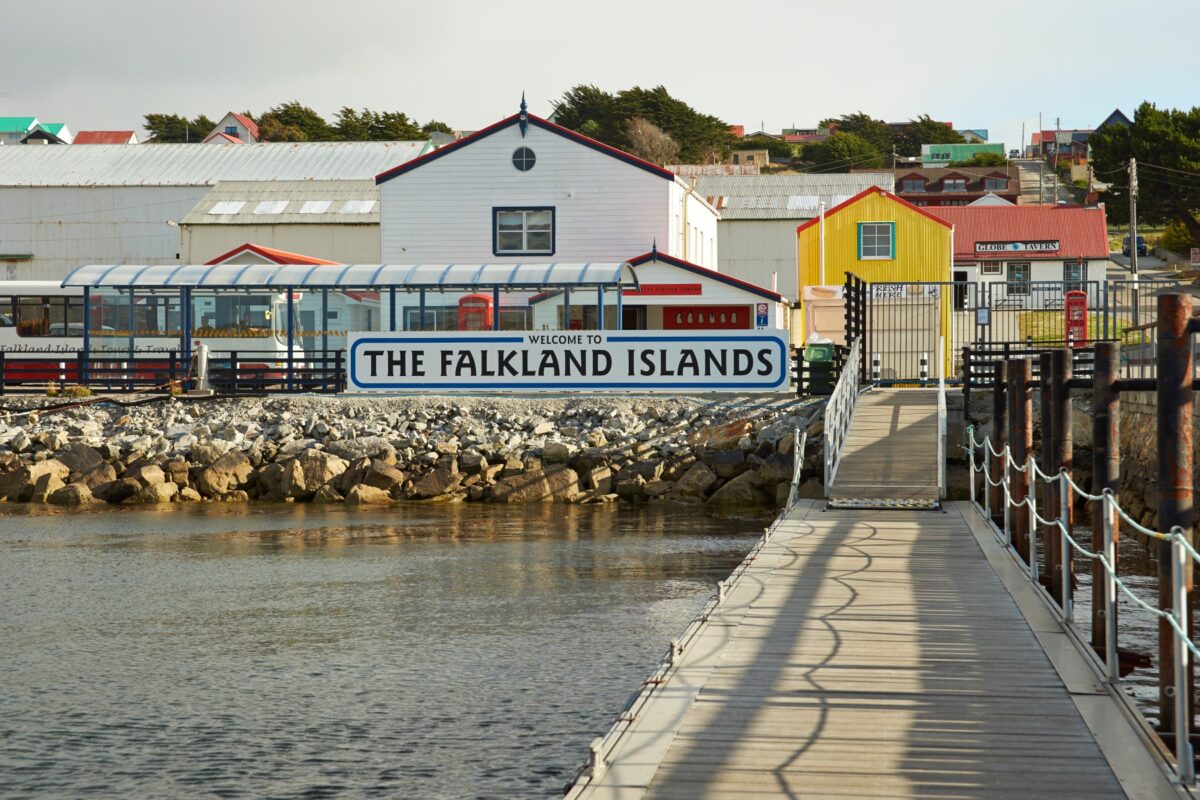
Exploring the city: 24 hours in Stanley
Spend a day in the one of the most remote capital cities in the world.
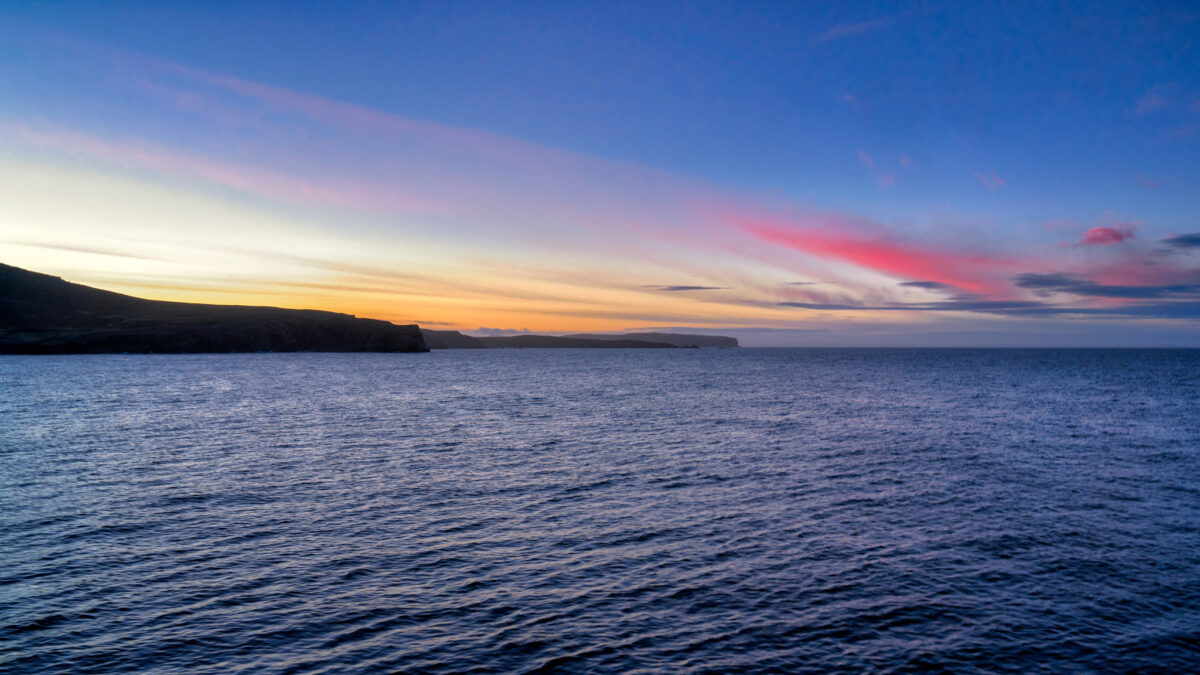
Unmissable activities on the Falkland Islands
Including wildlife-watching, fishing and hiking – there’s something for everyone!
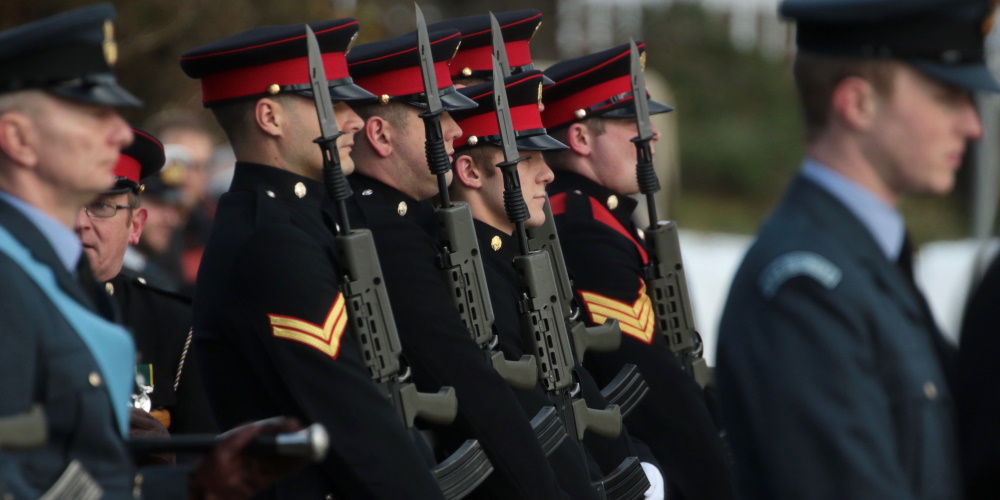
Looking Forward at 40: celebrating the liberation of the Falkland Islands
The 40th anniversary of Liberation Day sees a packed programme of events in the Falklands.

Falkland Islands Travel Guide
The main attraction of the Falkland Islands is wildlife watching with many birds and marine mammals to view. Flying fishing and horse trekking are two of the most popular sporting activities with hiking, climbing, sea kayaking, and mountain biking for the more adventuresome traveler. Falklanders are hospitable, welcoming people interested in sharing island life with visitors.
Attractions
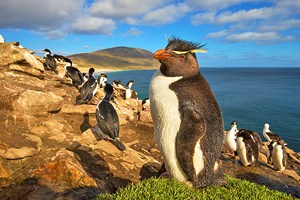
Cookies on GOV.UK
We use some essential cookies to make this website work.
We’d like to set additional cookies to understand how you use GOV.UK, remember your settings and improve government services.
We also use cookies set by other sites to help us deliver content from their services.
You have accepted additional cookies. You can change your cookie settings at any time.
You have rejected additional cookies. You can change your cookie settings at any time.
- Passports, travel and living abroad
- Travel abroad
- Foreign travel advice
Falkland Islands
Warnings and insurance.
The Falkland Islands is a British Overseas Territory, so there is no British Embassy, and the Falkland Islands government will support you if you need help.
Before you travel
No travel can be guaranteed safe. Read all the advice in this guide and any specific travel advice that applies to you:
- women travellers
- disabled travellers
- LGBT+ travellers
- solo and independent travel
- volunteering and adventure travel
Travel insurance
If you choose to travel, research your destinations and get appropriate travel insurance . Insurance should cover your itinerary, planned activities and expenses in an emergency.
About FCDO travel advice
The Foreign, Commonwealth & Development Office ( FCDO ) provides advice about risks of travel to help British nationals make informed decisions. Find out more about FCDO travel advice .
Follow and contact FCDO travel on Twitter , Facebook and Instagram . You can also sign up to get email notifications when this advice is updated.
Related content
Is this page useful.
- Yes this page is useful
- No this page is not useful
Help us improve GOV.UK
Don’t include personal or financial information like your National Insurance number or credit card details.
To help us improve GOV.UK, we’d like to know more about your visit today. We’ll send you a link to a feedback form. It will take only 2 minutes to fill in. Don’t worry we won’t send you spam or share your email address with anyone.
How to Get to the Falkland Islands: A Step-by-Step Guide
If you’re looking for a unique and memorable travel experience, then consider visiting the Falkland Islands. This remote archipelago in the South Atlantic Ocean is a nature lover’s paradise, with remarkable wildlife sightings and breathtaking landscapes. But before you can embark on your Falkland Islands adventure, there are several important things to know. This step-by-step guide will help you understand how to get to the Falkland Islands and prepare for your journey.
Understanding the Falkland Islands
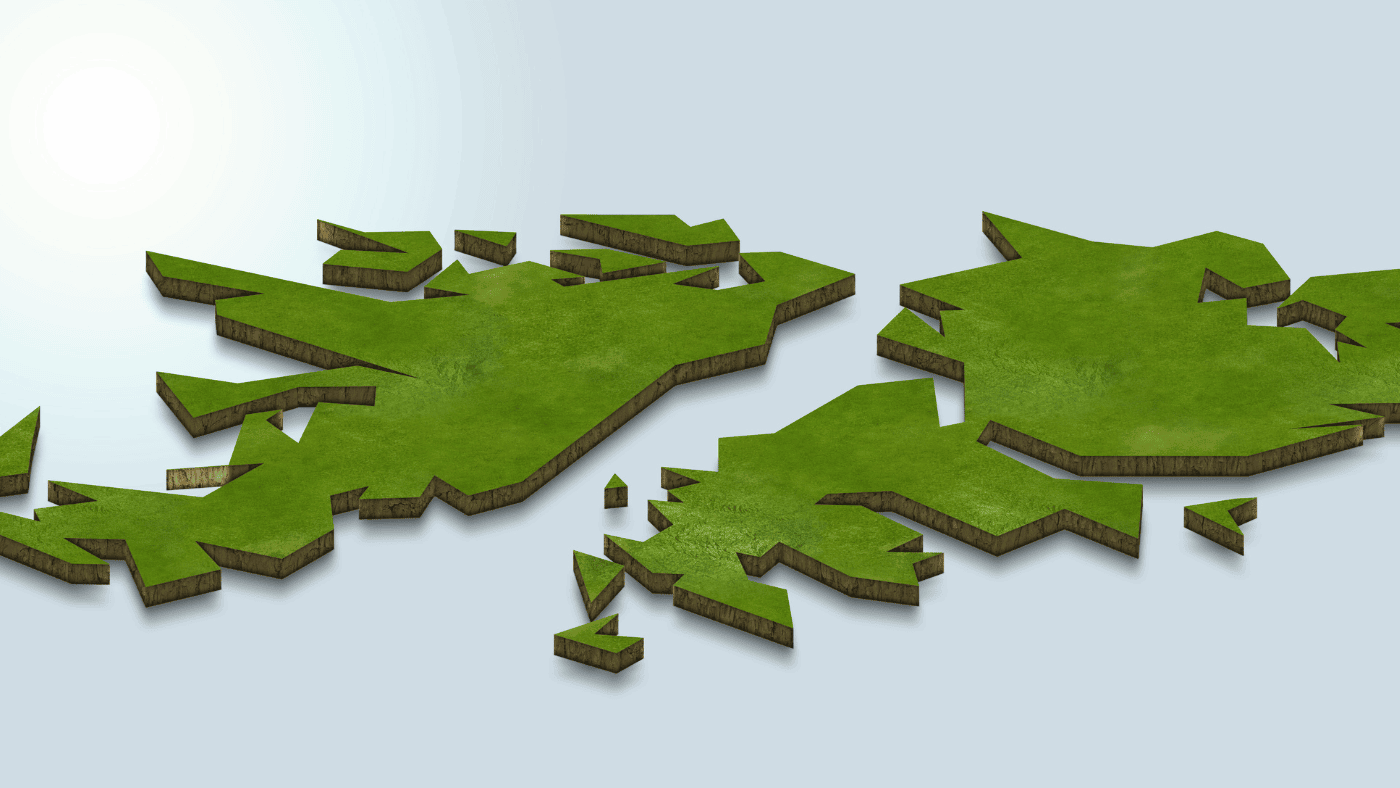
Geography and Climate
The Falkland Islands are a group of over 700 islands, with the two main islands being East Falkland and West Falkland. The islands are located in the South Atlantic Ocean, about 300 miles east of the coast of Argentina. The total land area of the Falkland Islands is approximately 4,700 square miles. The islands have a temperate climate, with cool and windy conditions throughout the year. The average temperature in the summer months is around 50°F (10°C), while in the winter months it can drop to 32°F (0°C). The best time to visit is during the summer months (November to March), when the days are longer and the weather is warmer. However, it’s important to note that weather conditions can change quickly, so it’s important to be prepared for all types of weather.
The Falkland Islands are also known for their unique landscape, with rolling hills, rugged coastlines, and wide-open spaces. The islands have a number of natural harbors, which have played an important role in the islands’ history as a stopover point for ships traveling between South America and Europe.
History and Culture
The Falkland Islands have a rich history, with a mix of British and Argentinean influences. The islands were discovered by Europeans in the 16th century, but were not settled until the 18th century, when the British established a colony on the islands. The islands have been the subject of dispute between the British and Argentinean governments for many years, with Argentina claiming sovereignty over the islands. In 1982, Argentina invaded the Falkland Islands, leading to a brief war with the United Kingdom , which resulted in the British regaining control of the islands.
The Falkland Islanders have a unique culture, with a strong British influence in language, customs, and traditions. English is the official language of the islands, and many of the islanders are of British descent. The islands have a small population of around 3,500 people, and the economy is largely based on fishing and tourism.
Wildlife and Natural Attractions
The Falkland Islands are home to a diverse range of wildlife, including penguins, sea lions, albatrosses, and many other species. The islands are particularly known for their penguin colonies, with five different species of penguins found on the islands. The islands also have a number of other unique animal species, including the Falkland Islands wolf, which is now extinct.
The islands also have many natural attractions, including white sand beaches, rugged coastlines, and scenic hiking trails. The islands’ natural beauty has made them a popular destination for eco-tourists, who come to explore the islands’ unique landscape and wildlife.
Preparing for Your Falkland Islands Trip
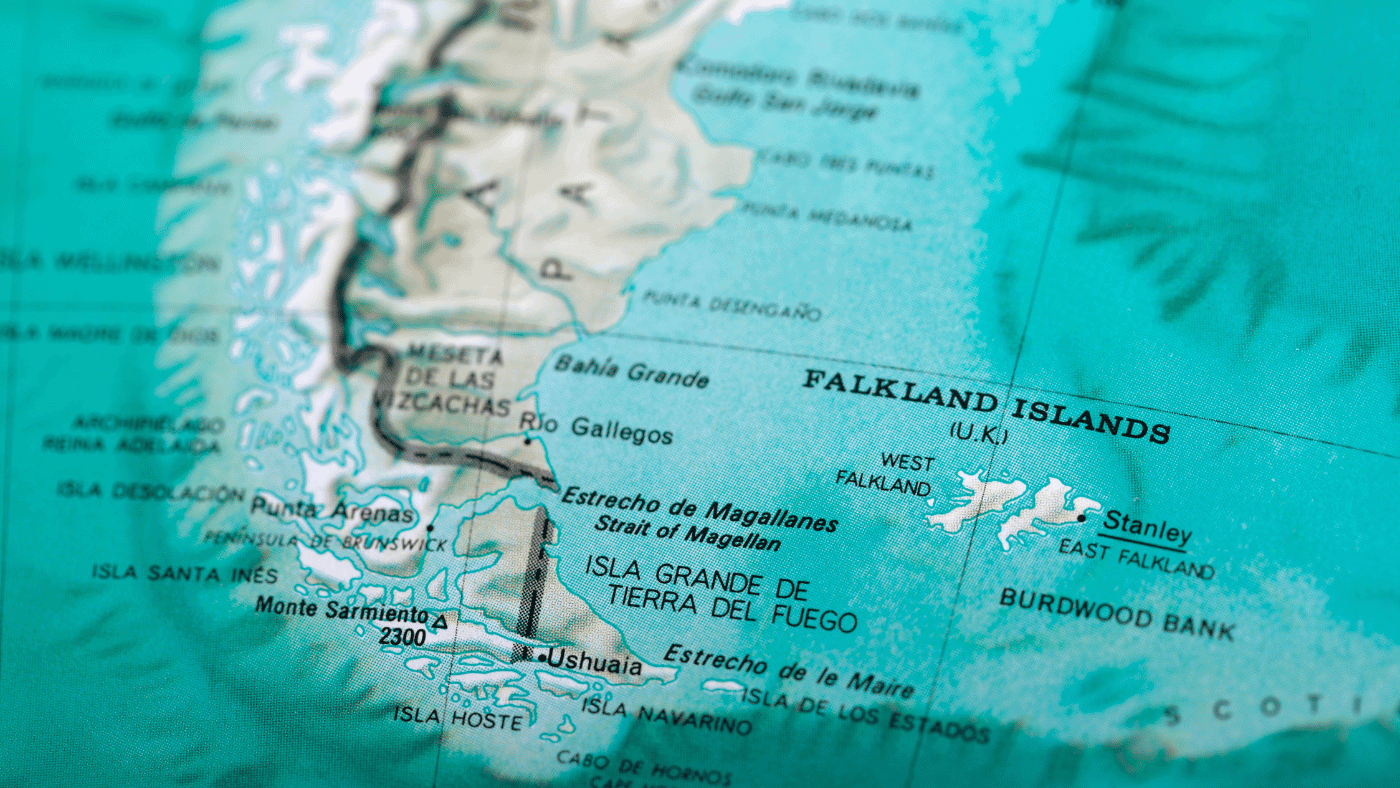
Visa Requirements and Travel Documents
If you’re a citizen of the UK or many other countries, you do not need a visa to enter the Falkland Islands. However, it’s important to check the visa requirements for your country before you travel . You will also need a valid passport and travel insurance .
Best Time to Visit
The best time to visit the Falkland Islands is during the summer months (November to March), when the weather is warmer and the days are longer. However, it’s important to note that weather conditions can change quickly, so it’s important to be prepared for all types of weather.
Health and Safety Considerations
The Falkland Islands are a safe travel destination, with low crime rates. However, it’s important to take standard precautions, such as keeping your valuables secure and being aware of your surroundings. It’s also important to be up to date on your vaccinations and to bring any necessary medications with you.
Packing Essentials
When packing for the Falkland Islands, it’s important to bring warm and waterproof clothing, as well as sturdy hiking shoes. You should also bring sun protection, as the sun can be strong even on cloudy days. Insect repellant and a first aid kit are also recommended.
Travel Options to the Falkland Islands
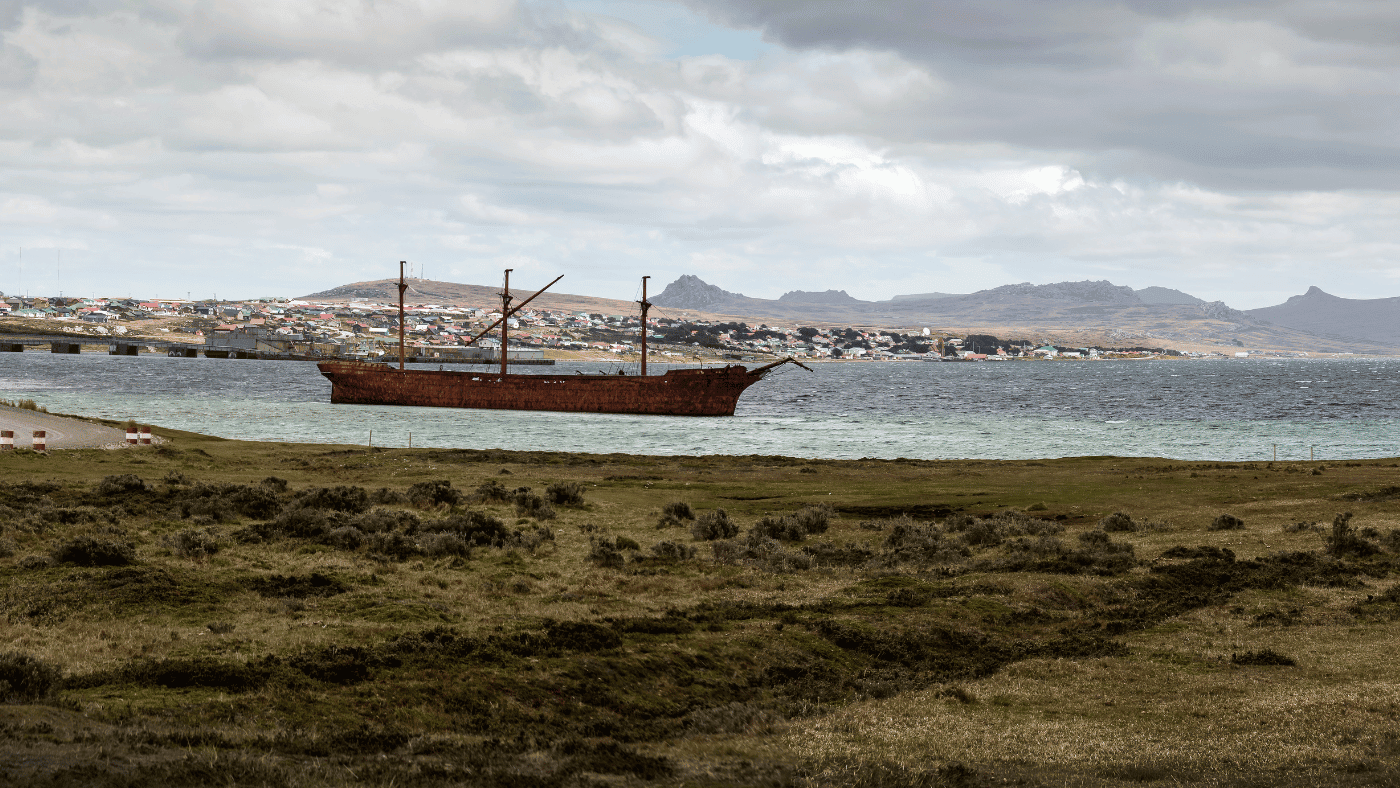
Flying to the Falkland Islands
The easiest way to get to the Falkland Islands is by flying. The Falkland Islands Government Air Service operates flights from Santiago, Chile and Punta Arenas, Chile to Mount Pleasant Airport in the Falkland Islands. There are also occasional flights from Rio Gallegos, Argentina and São Paulo, Brazil.
Cruise Ship Options
Another way to get to the Falkland islands is by taking a cruise. Many cruise lines offer tours that stop in the Falkland Islands, giving passengers the opportunity to see the wildlife and natural beauty of the islands.
Private Yacht or Charter
If you’re looking for a more adventurous way to get to the Falkland Islands, you can charter a yacht or hire a private charter. This option allows you to explore the islands at your own pace and provides a unique travel experience.
Navigating the Falkland Islands
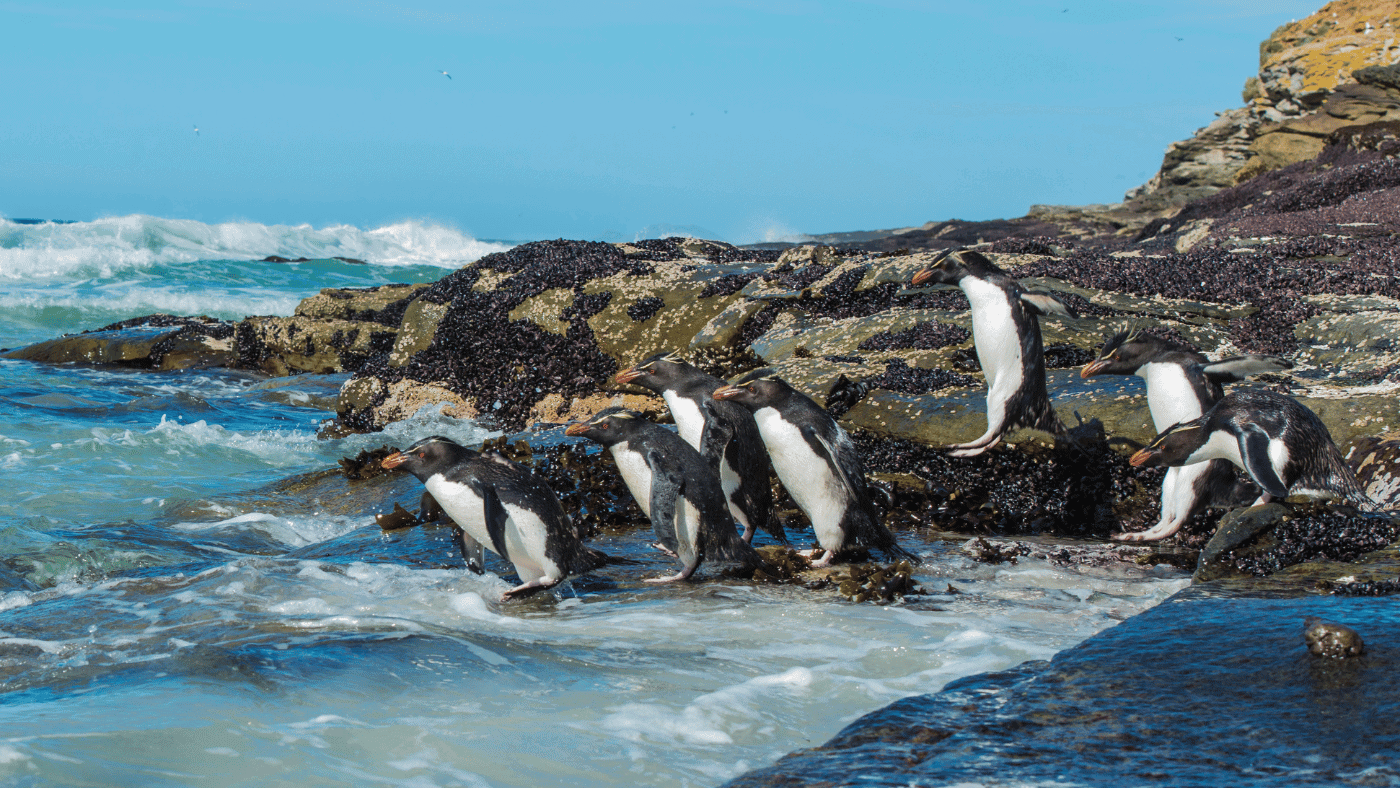
Transportation within the Islands
Once you’ve arrived in the Falkland Islands, there are several transportation options available. Rental cars and bicycles are available, as well as guided tours and taxi services. Many attractions can also be accessed on foot.
Accommodation Options
The Falkland Islands offer a range of accommodation options to suit different preferences and budgets. There are hotels and bed and breakfasts, as well as self-catered cottages and camping options. It’s important to book your accommodation in advance, especially during the peak travel season.
Local Customs and Etiquette
The Falkland Islanders are a friendly and welcoming people, but it’s important to be respectful of their customs and traditions. The main language spoken is English, and there are many British customs and traditions that are observed. Handshakes are the customary greeting, and it’s important to dress appropriately in public places.
By following this step-by-step guide , you can ensure that your trip to the Falkland Islands is a success. Whether you’re interested in wildlife sightings, scenic hiking trails, or exploring new cultures, the Falkland Islands have something to offer. Start planning your Falkland Islands adventure today!

Skip To Main Content
- Avian Influenza
- Tour Operators
- Cruises to the Falklands
- Independent Travel
- Travel by Air
- Travel by Sea
- Travel by Road
- Local Tours
- Reaching the Outer Islands
- Top 5 Things to Do in Stanley
- Top 5 Things to do in the Falklands
- Top 5 Beaches in the Falklands
- Island Hopping
- Wildlife and Penguins
- Biosecurity
- Essential Information
- Safe Travel
- Tourist Information Centre
- Useful Downloads
- E-newsletter
- History & Heritage
- Falklands Life
- Falklands Flora
- Sustainable Travel
- Competitions
- Digital Image Library
- Things to Do
- Food and Drink
- Northern Section
- Southern Section
- Bleaker Island
- Carcass Island
- George & Barren Islands
- Jason Islands
- Kidney Island
- Pebble Island
- Saunders Island
- Sea Lion Island
- Weddell Island
- West Point Island
- Birdwatching
- Seals, Whales and Dolphins
- 1982 Battlefields
- Walking & Hiking
- All Year Round
- Eat & Drink
- Shopping in the Falklands
- Hotels, Lodges and Guest Houses
- Self-Catering
.png)
Getting Here
Travelling to the Falkland Islands is easier than you might think with options by air and by sea. Arrangements can be made with an international operator or Falkland Islands Holidays , a Falklands-based company.
Many visitors choose to arrive via Chile. LATAM operates a flight every Saturday from Santiago, Chile (SCL) returning the same day. A stop is made each way at the southern Chilean city of Punta Arenas (PUQ) where customs formalities for Chile are completed. Once a month the flight stops in Rio Gallegos, Argentina (RGL).
For flight enquiries and quotations from Around the World to the Falkland Islands please contact International Tours & Travel Ltd the Latam Airlines General Sales Agent in the Falkland Islands.
The Ministry of Defence, UK, operates twice weekly flights from Brize Norton in Oxfordshire, directly to the Falklands with a refuelling stop in Cape Verde. Flights leave the UK on Sundays and Wednesdays. Return flights depart the Falklands on Tuesdays and Fridays. Civilian passengers can book seats on these flights via the Falkland Islands Government Office in London. These flights are sometimes subject to last minute changes; travellers need to be sure that they have plenty of time available around their dates of travel to account for all eventualities.
All flights arrive at Mount Pleasant Airport (MPN) on East Falkland. The airport is part of Mount Pleasant Complex, managed by the UK Ministry of Defence. Bus transfers are available from the airport to Stanley where you will be dropped off directly at your accommodation. If your first destination is elsewhere in the Islands, your accommodation provider or tour operator will organise an appropriate transfer or meet you at Mount Pleasant. If you wish to travel independently to the Islands, both accommodation and transfers must be arranged prior to your arrival.
More than forty different cruise ships from a number of companies include the Falkland Islands as part of their austral summer itineraries. This is a great way to get a feel for the Islands as part of a South American or Antarctic adventure. Explore the range of cruise companies that currently operate to the Falklands.

Find out more!
Island Inspiration

Follow, Like, Love
Follow the falklands @ilovethefalklands, like the falklands on facebook, follow the falklands @fitbtourism, twitter updates.

Browse our shop
Read our blogs
Ratings & Reviews

- Falklands and COVID-19
- Accessibility Statement
- Privacy Policy
© Copyright 2024 Falkland Islands Tourist Board. All Rights Reserved
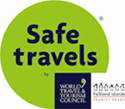

IMAGES
VIDEO
COMMENTS
The Falkland Islands are a natural wonder of spectacular landscapes and stunning vistas, teeming with wildlife. With so many adventures to enjoy, from walking and hiking, wildlife watching, fishing and sailing, kayaking and cruising, the Islands offer you a unique opportunity for truly getting away from it all.
An essential guide to the Falkland Islands. Even though the Falkland Islands - one of the UK's southernmost overseas territories - briefly came to global prominence in 1982 after its sovereignty was contested by Argentina, they aren't on the radar for most travelers. This South Atlantic archipelago consists of more than 700 islands, is ...
The best time for visiting the Falkland Islands is in the late spring and summer months, between the end of October and March. The best months will probably be November to February, with January and February being the warmest months, when days are longer, temperatures warmer and there are less chances of rain (though lots of wind).
Falkland Islands (Islas Malvinas) The Falkland Islands are a popular addition to many Antarctic voyages, but they're well worth seeing on their own for their spectacular penguin, seal and albatross populations. Surrounded by the South Atlantic, the islands lie 490km east of Patagonia. Two main islands, East Falkland and West Falkland, and ...
Two Weeks in the Falkland Islands Itinerary & Travel Guide. The Falkland Islands are one of those rare places left where you can escape the modern world. Located 300 miles to the east of the bottom tip of South America. Their remote location has left the Falklands a place for one-of-a-kind wildlife encounters. While the fauna is what draws most ...
This means most trips to the Falkland Islands will last a duration of 11 days in total - 2 days travel there, 7 days on island, plus 2 days travel back. #3 Ideal Falkland Itinerary If budget allows, I really recommend getting out of Stanley to experience many of the smaller islands, as this is where the best wildlife and remote Falkland ...
The Falkland Islands have been officially 'mine free' since November 2020, however there is still the outside possibility that you may come across an unexploded device, for example if one has been brought in from the sea ... Alternatively, you can travel around the Falkland Islands by vehicle and there are a range of local businesses that ...
Just a few decades ago, the Falkland Islands were embroiled in a bitter war when Argentina invaded the U.K.'s territory. The conflict, which eventually restored the islands back to British control ...
Falkland Island Tours & Travel ( ☏ +500 21775, [email protected]) operates a shuttle bus that meets all flights and that can take visitors to and from the capital for £15 per person (one-way). Taxis also take passengers to and from the airport, and these must be booked in advance.
The summer months of December to February are the most popular time to visit the Falkland Islands. The weather at this time of the year is mild, there are longer daylight hours, and the island's wildlife is at its peak. As always though, travelling in the shoulder season also has its benefits. It's generally cheaper, there are fewer people ...
Falkland Islands travel guide. About Falkland Islands. Nineteenth-century shipwrecks and a plethora of marine life are among the attractions awaiting visitors to the Falkland Islands. Although these islands are perhaps best known as the battleground of the eponymous 1982 war between Britain and Argentina, but this archipelago in the Atlantic is ...
Falkland Islands travel guide. The Falkland Islands are another world. This Atlantic archipelago has some of the earth's wildest and most far out landscapes, with white beaches, hidden beaches and empty beaches. Empty, that is except for the sea lions, penguins, dolphins, whales, elephant seals and over 200 species of birds.
The Falkland Islands, an archipelago located in the South Atlantic Ocean, is a destination that boasts stunning natural beauty and captivating wildlife. With its rugged coastlines, pristine beaches, abundant birds and marine mammals, the Falklands offer a unique and unforgettable experience. The archipelago is renowned for its incredible ...
The Falkland Islands offer some of the best birdwatching in the world, with large colonies of penguins, albatross and seals. A popular stop on Antarctic voyages, the islands are becoming increasingly popular in their own right, thanks to their abundant wildlife, gorgeous landscape and charming capital city Stanley. 18 days.
Other popular Falkland Island things to do include fishing, trekking, hiking, climbing, kayaking, and mountain biking. Find the best places to visit and points of interest with our list of the top tourist attractions in the Falkland Islands. On This Page: 1. Falkland Island Wildlife.
The Falkland Islands are situated between latitude 51 ̊ and 53 ̊S and longitude 57 ̊ and 62 ̊W in the South Atlantic, some 300 miles to the east of southern Argentina. There are two large islands, East and West Falkland, and over 700 smaller islands, which combine to create a total land area of 4,700 square miles (12,173km ² ).
Falkland Islands Travel Guide. The main attraction of the Falkland Islands is wildlife watching with many birds and marine mammals to view. Flying fishing and horse trekking are two of the most popular sporting activities with hiking, climbing, sea kayaking, and mountain biking for the more adventuresome traveler. Falklanders are hospitable ...
14 April 2024. Updated: 18 March 2024. Latest update: This travel advice has been rewritten to make it easier to read and understand. The Falkland Islands is a British Overseas Territory, so there ...
The islands are located in the South Atlantic Ocean, about 300 miles east of the coast of Argentina. The total land area of the Falkland Islands is approximately 4,700 square miles. The islands have a temperate climate, with cool and windy conditions throughout the year. The average temperature in the summer months is around 50°F (10°C ...
Whether from the Islands' capital, Stanley, or an accommodation establishment elsewhere, you will find plenty of suggestions to tempt you to travel around with a private guide, as part of small group or as a self-guided activity. Enjoy the excitement of an overland trip in a rugged but comfortable 4x4 vehicle or set your own pace on foot.
Getting Here. Travelling to the Falkland Islands is easier than you might think with options by air and by sea. Arrangements can be made with an international operator or Falkland Islands Holidays, a Falklands-based company. Many visitors choose to arrive via Chile. LATAM operates a flight every Saturday from Santiago, Chile (SCL) returning the ...